Motorola Mobility T56DP1 Portable Cellular/ PCS Transceiver (AMPS/CDMA) User Manual UG C330 GSM
Motorola Mobility LLC Portable Cellular/ PCS Transceiver (AMPS/CDMA) UG C330 GSM
Contents
- 1. Exhibit 8 Preliminary Users Manual
- 2. Supp Response to CRN231105AIHD
- 3. Users Manual per CRN 10580
Exhibit 8 Preliminary Users Manual
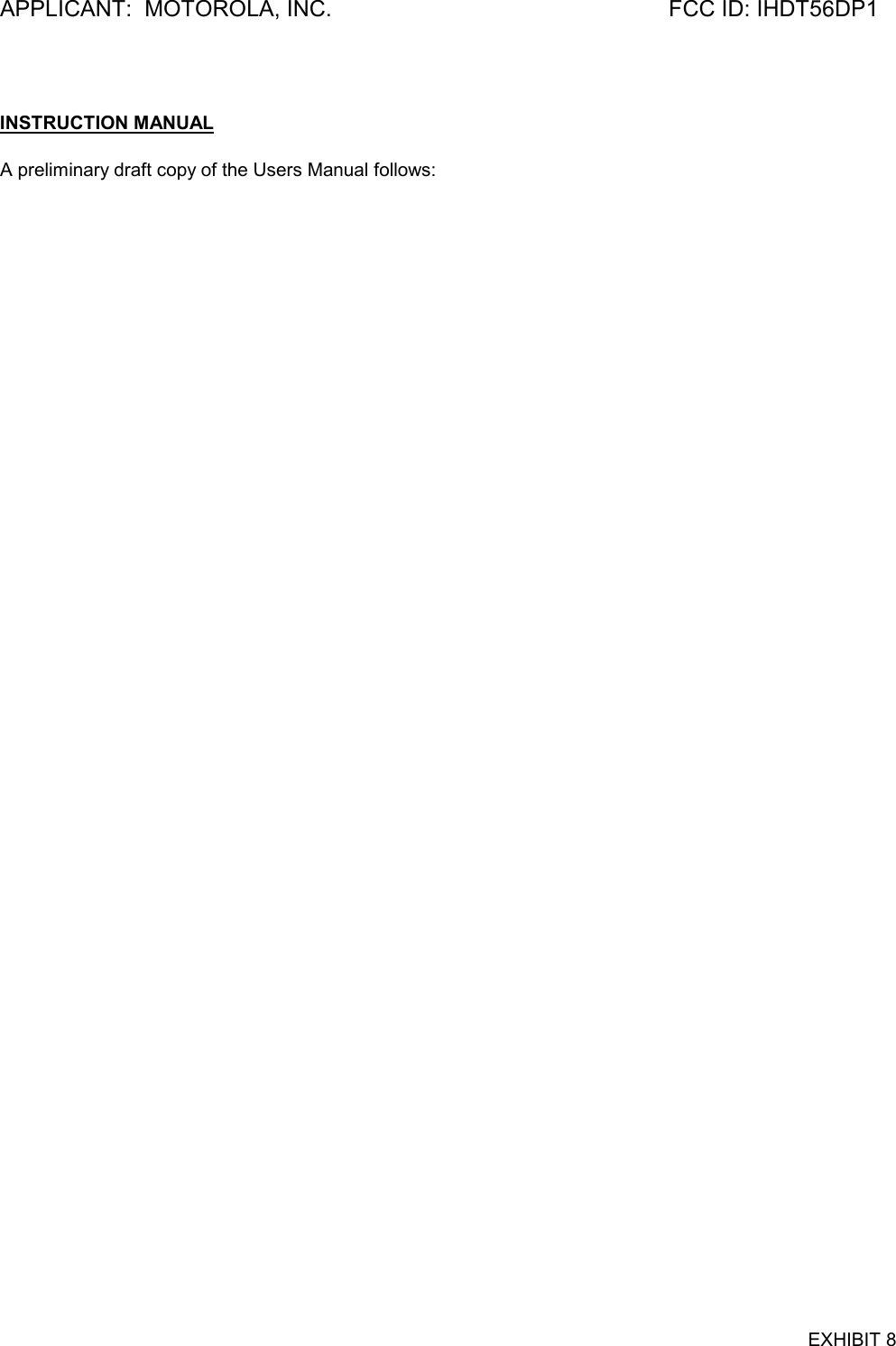
![User’s GuideVision-enabled PCS PhoneModel [xx]Manufacturer’sLogoSPRINT-motorola8/27 2003.8.27 2:16 PM Page b](https://usermanual.wiki/Motorola-Mobility/T56DP1.Exhibit-8-Preliminary-Users-Manual/User-Guide-372493-Page-2.png)
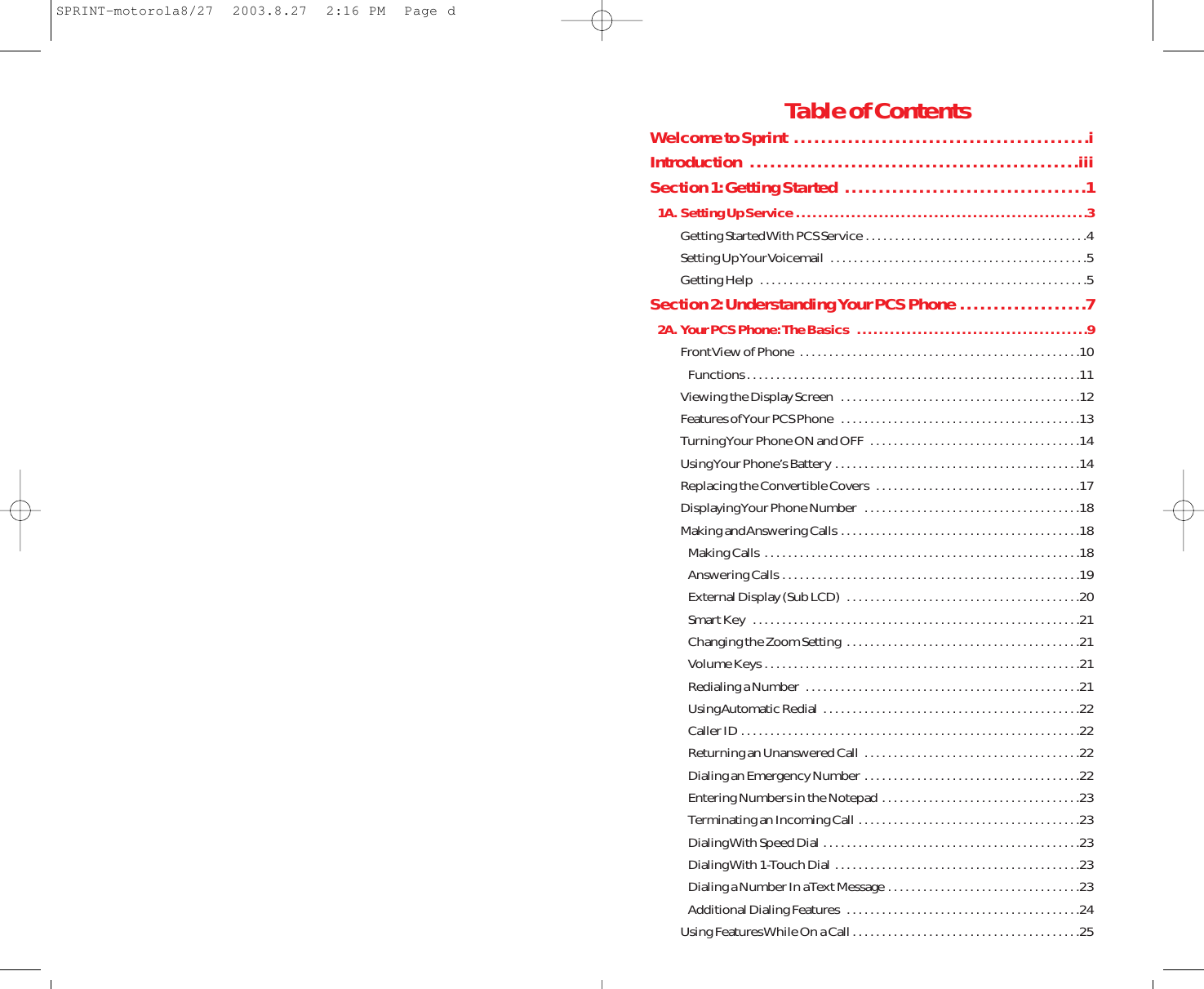
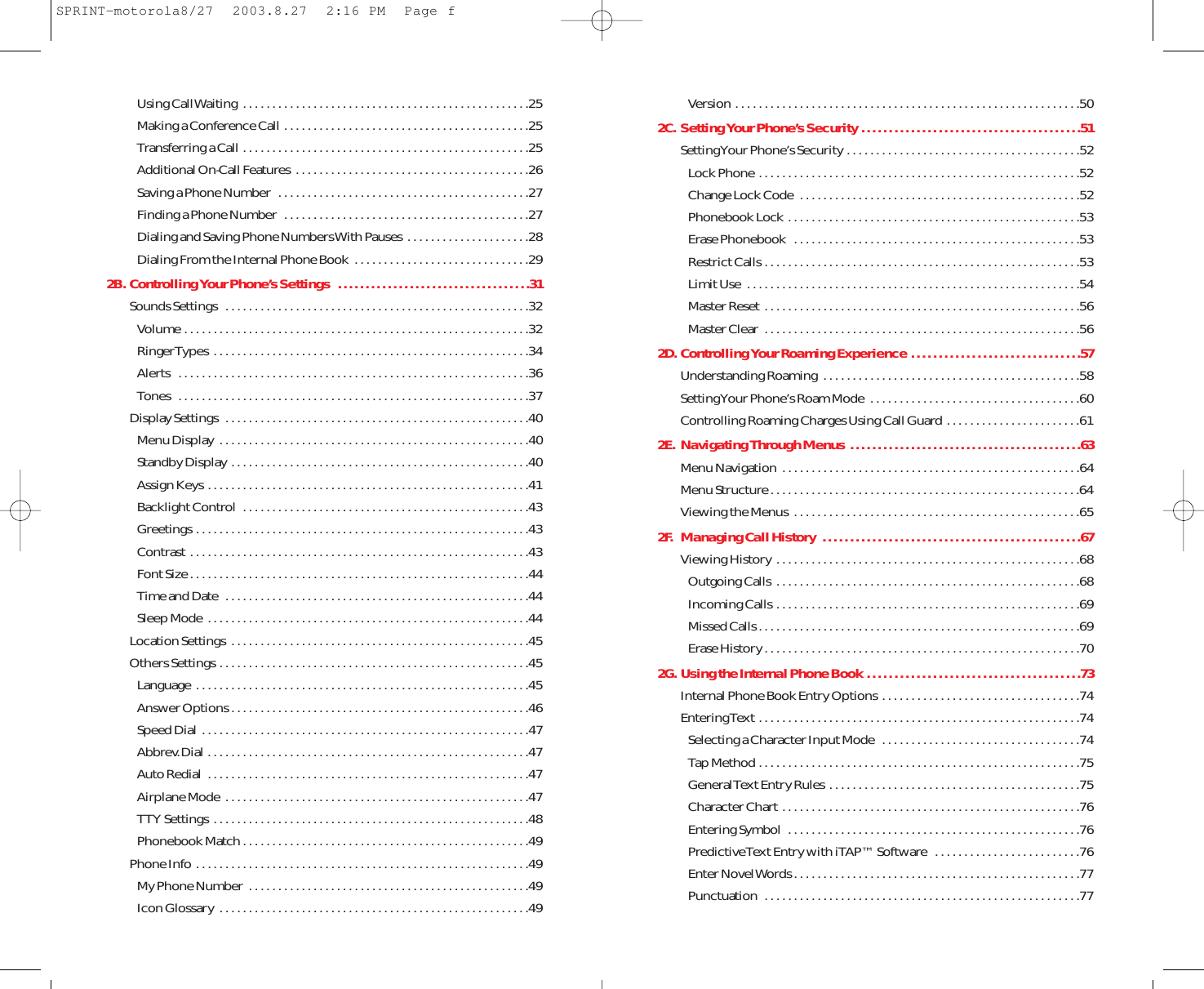
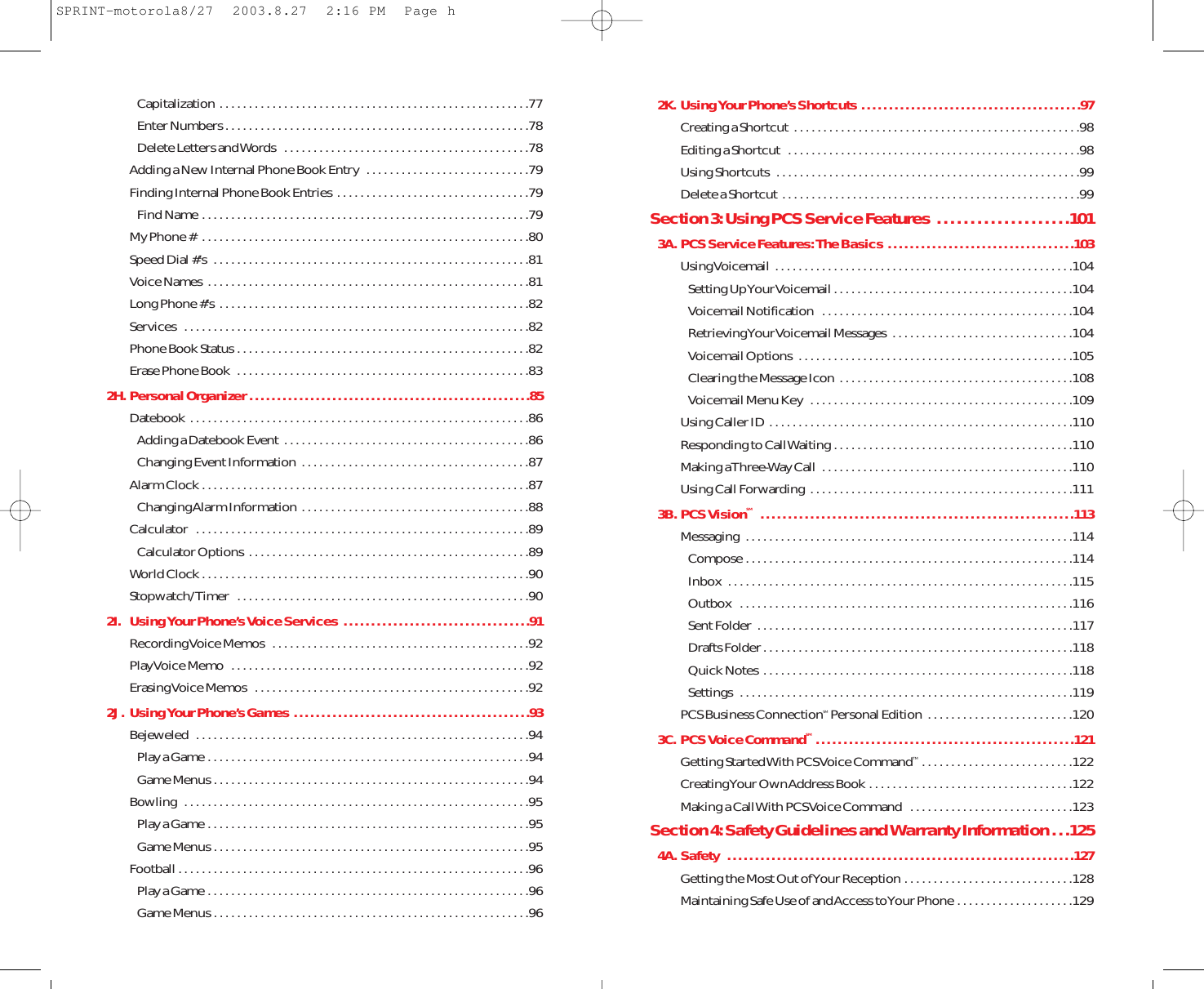
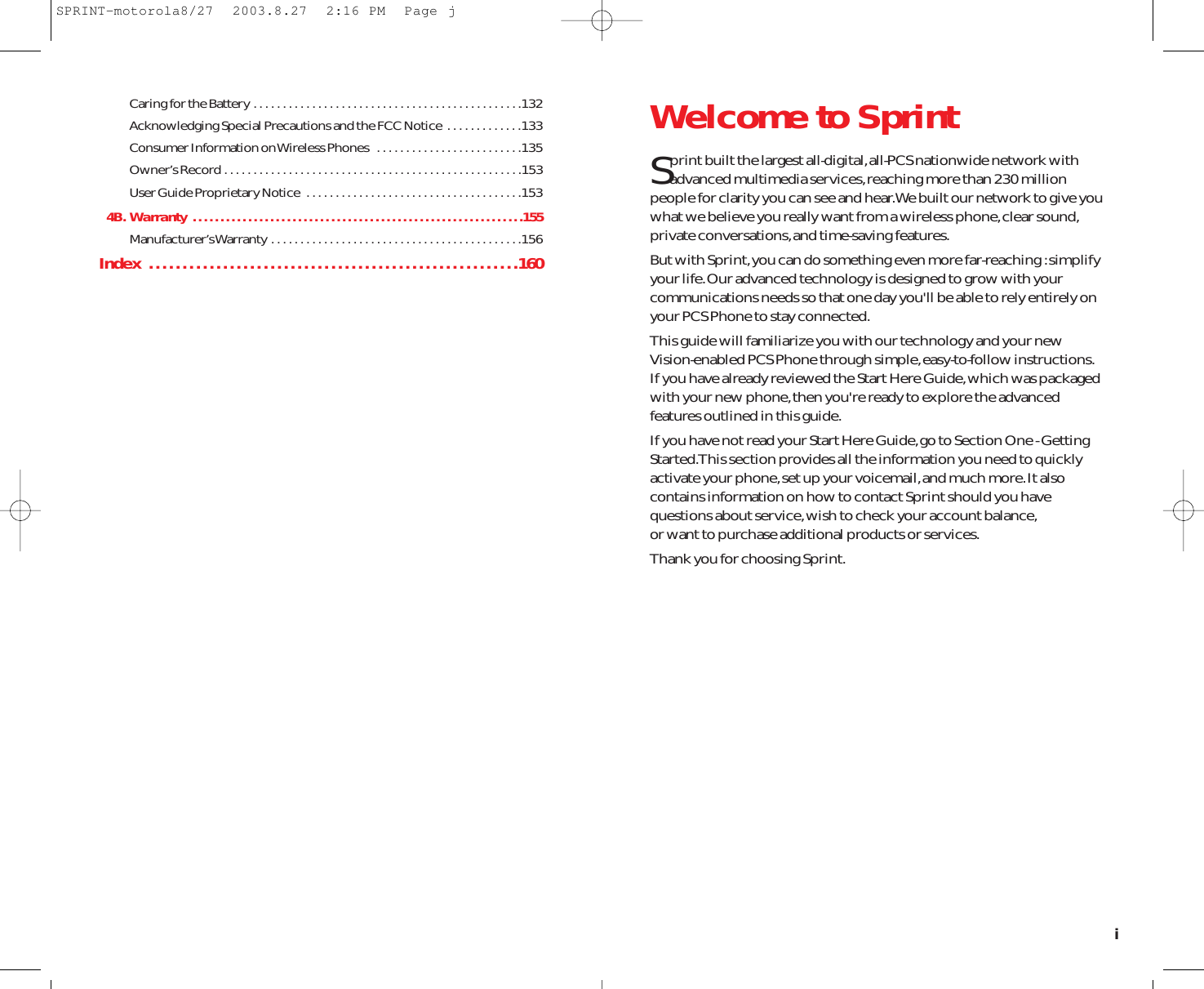
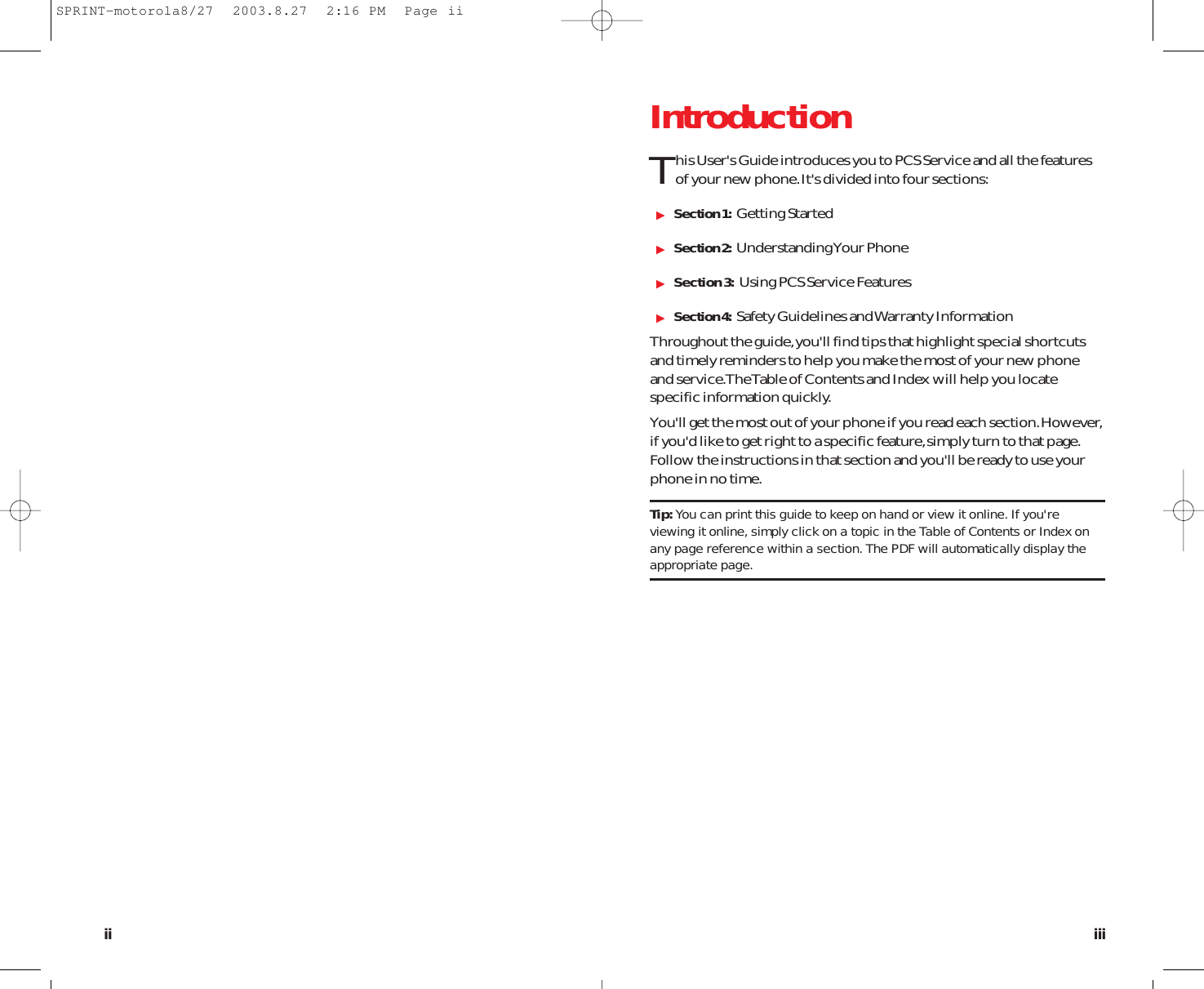
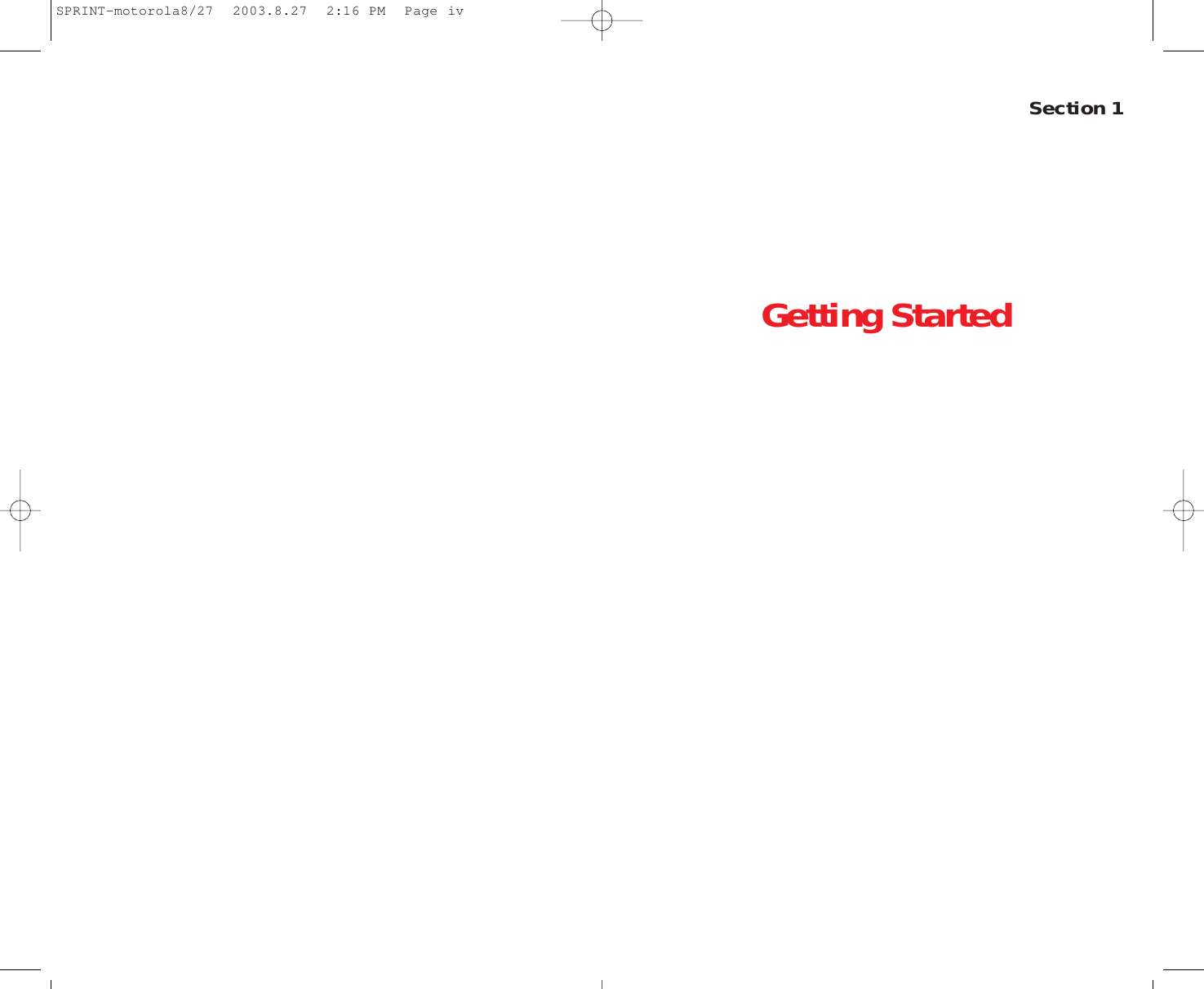
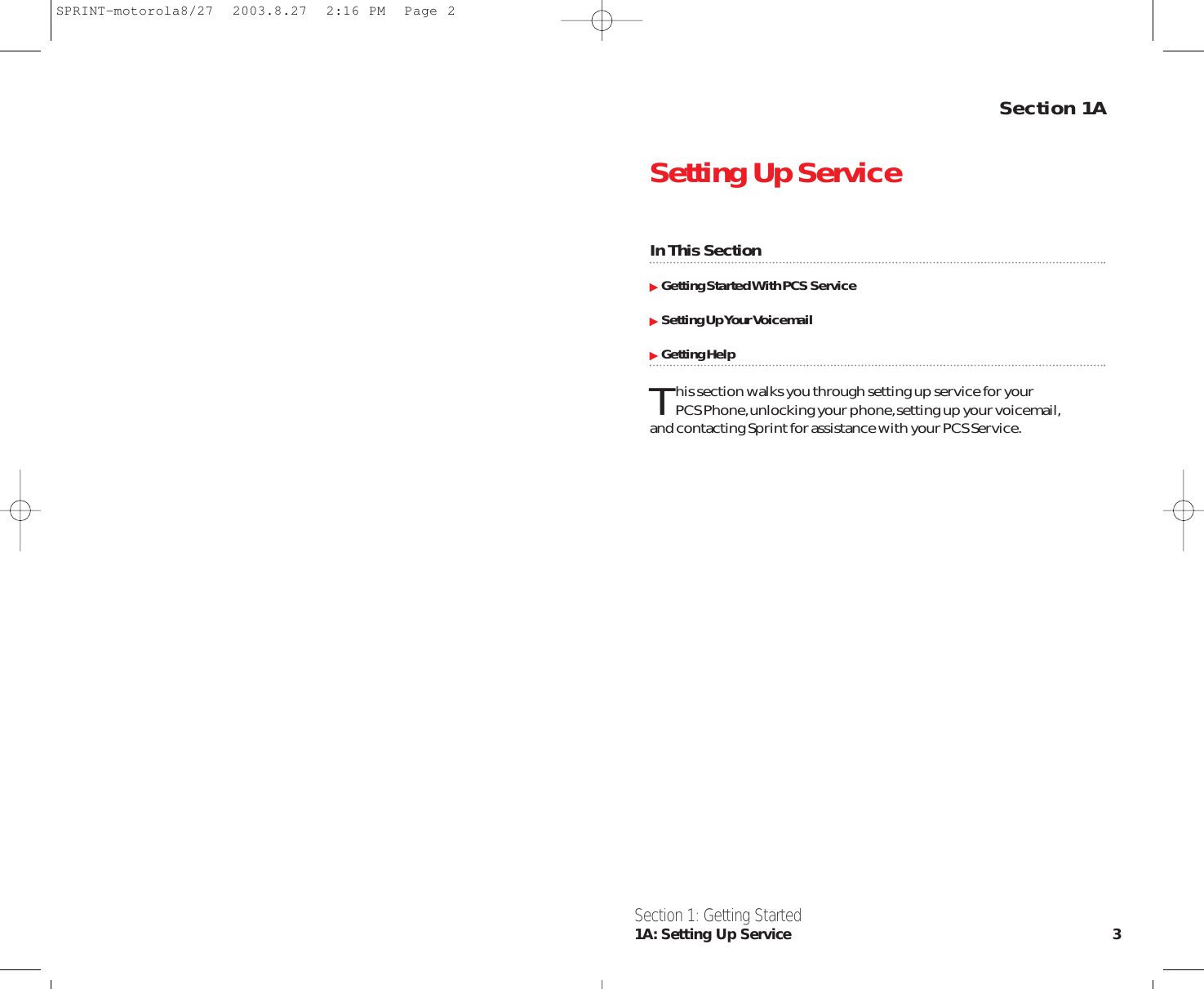
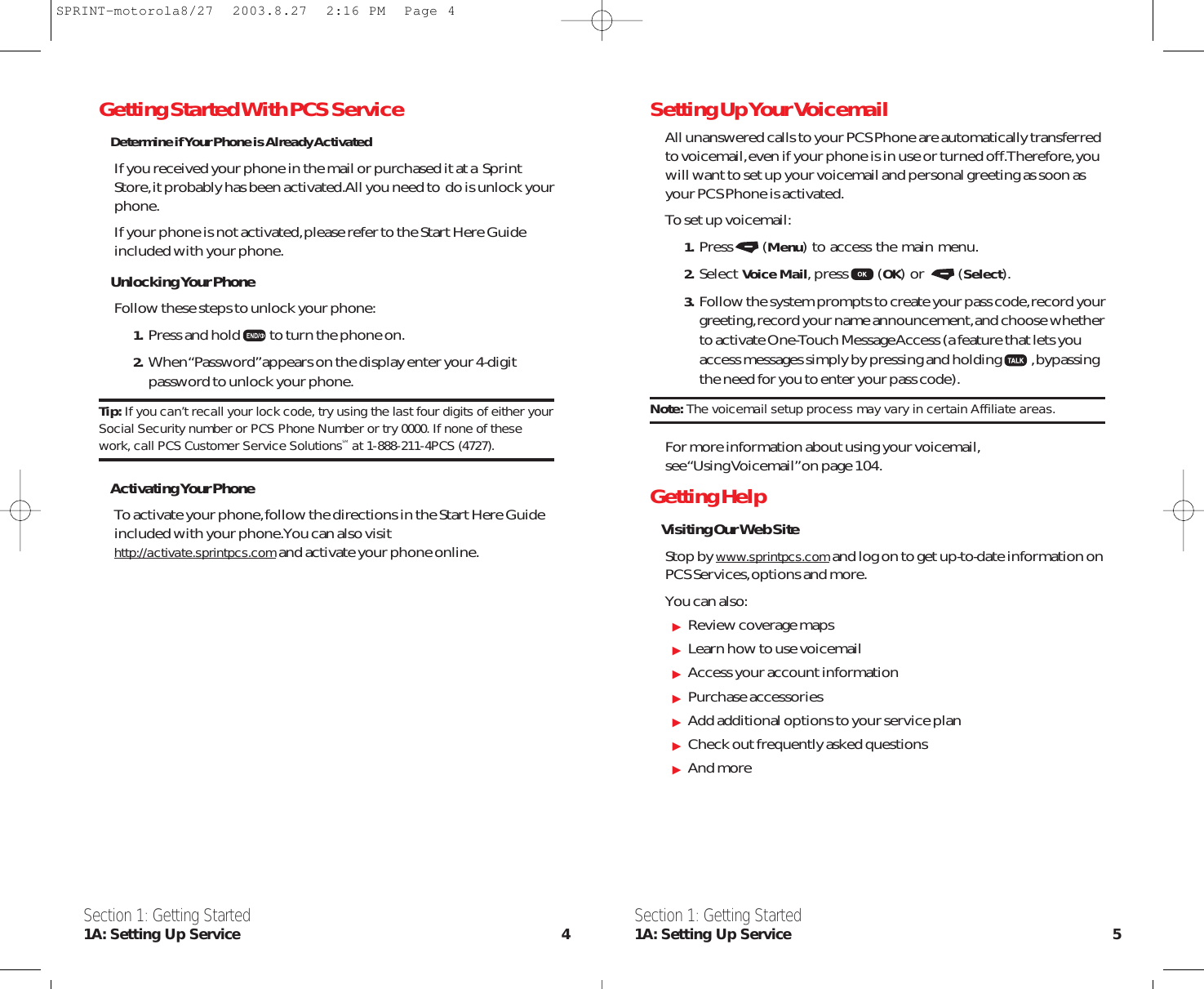
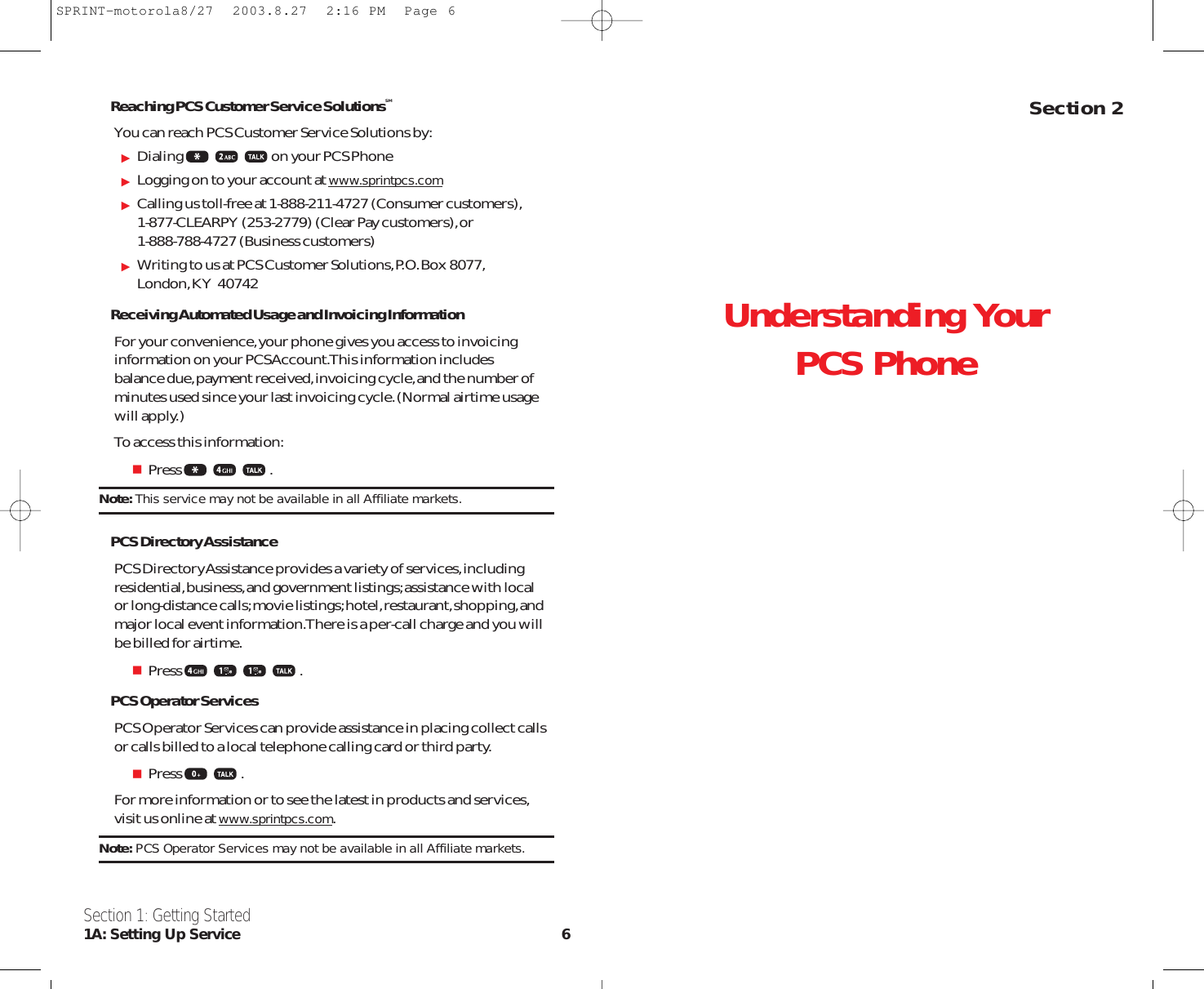
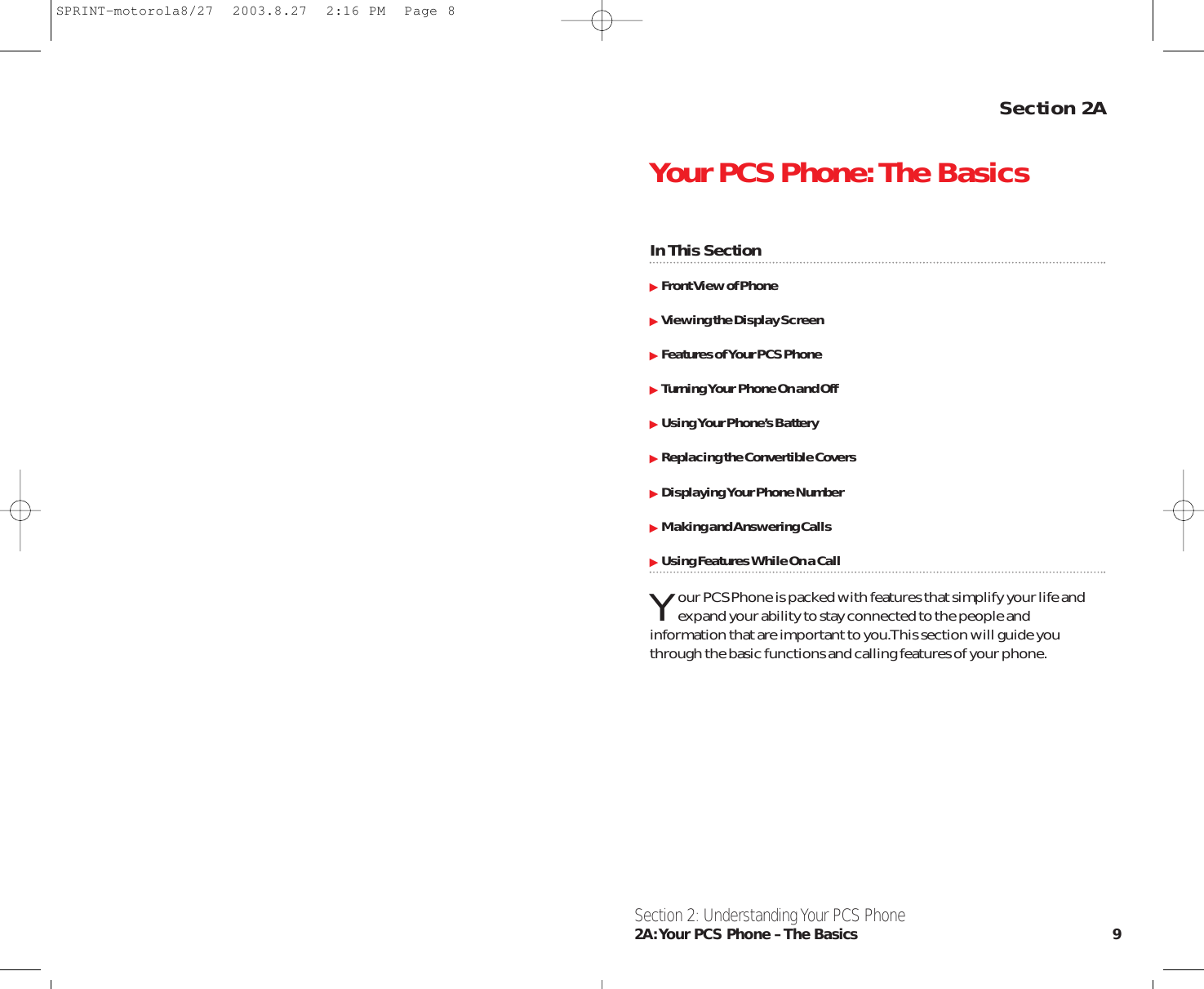
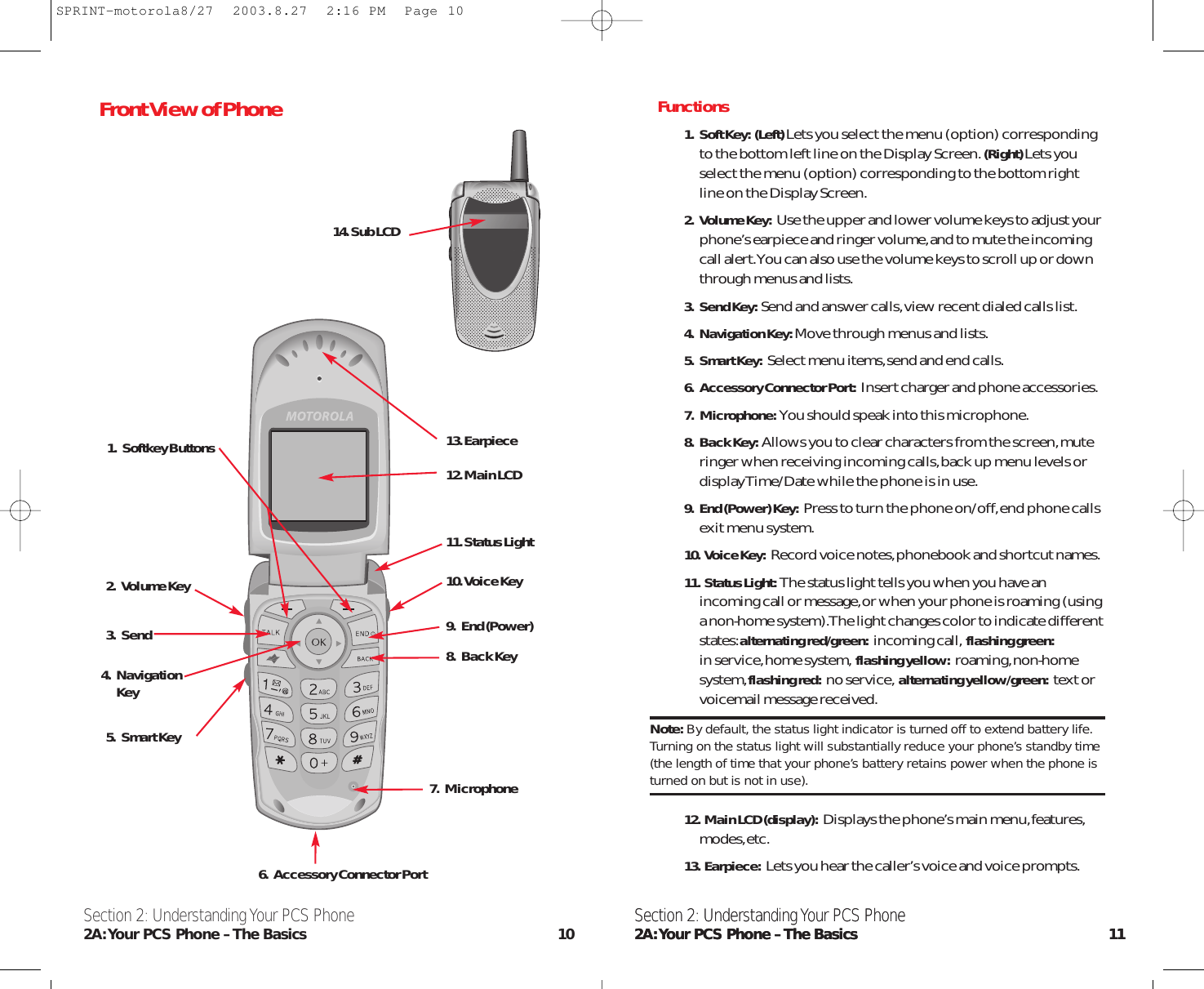
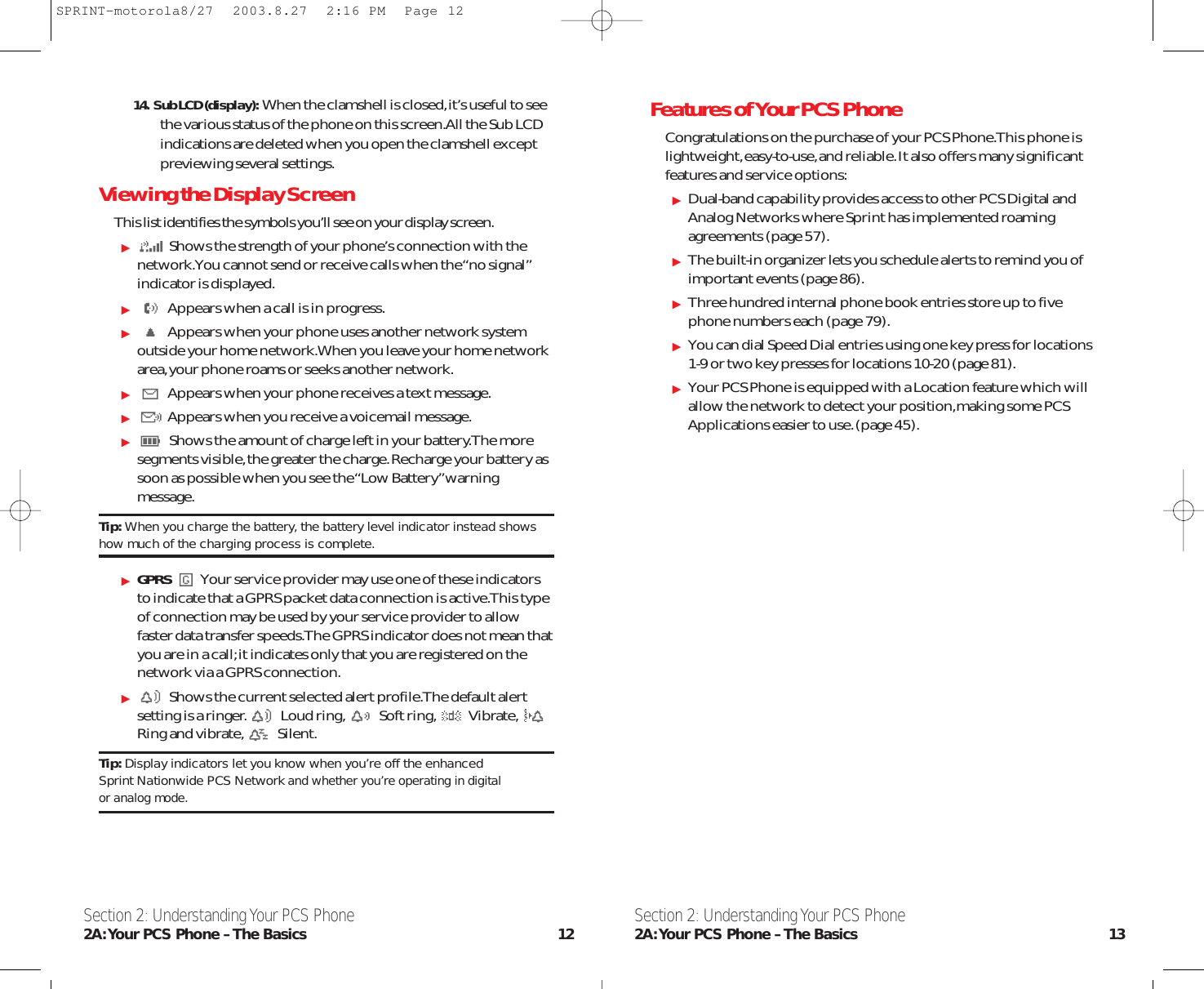
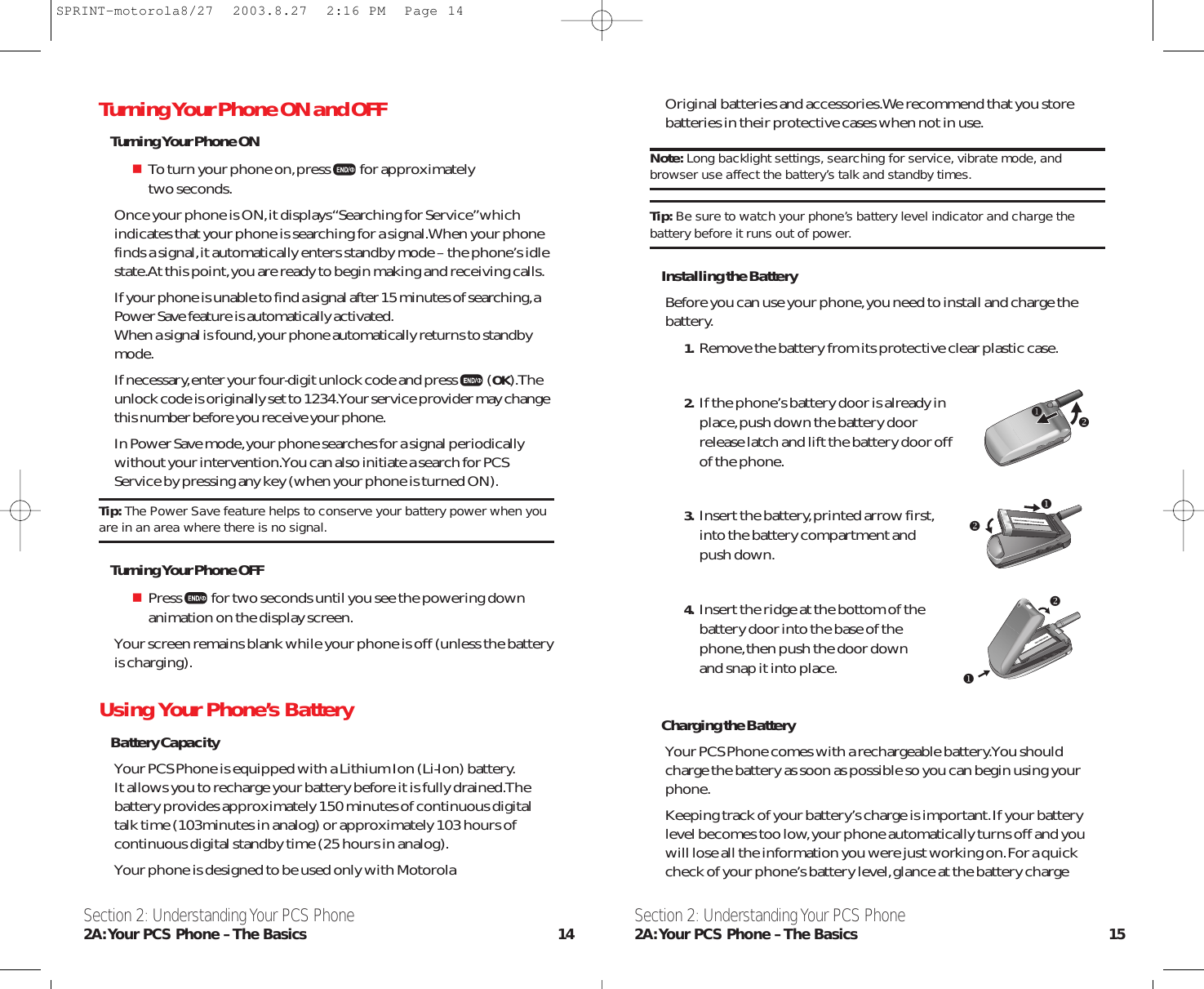
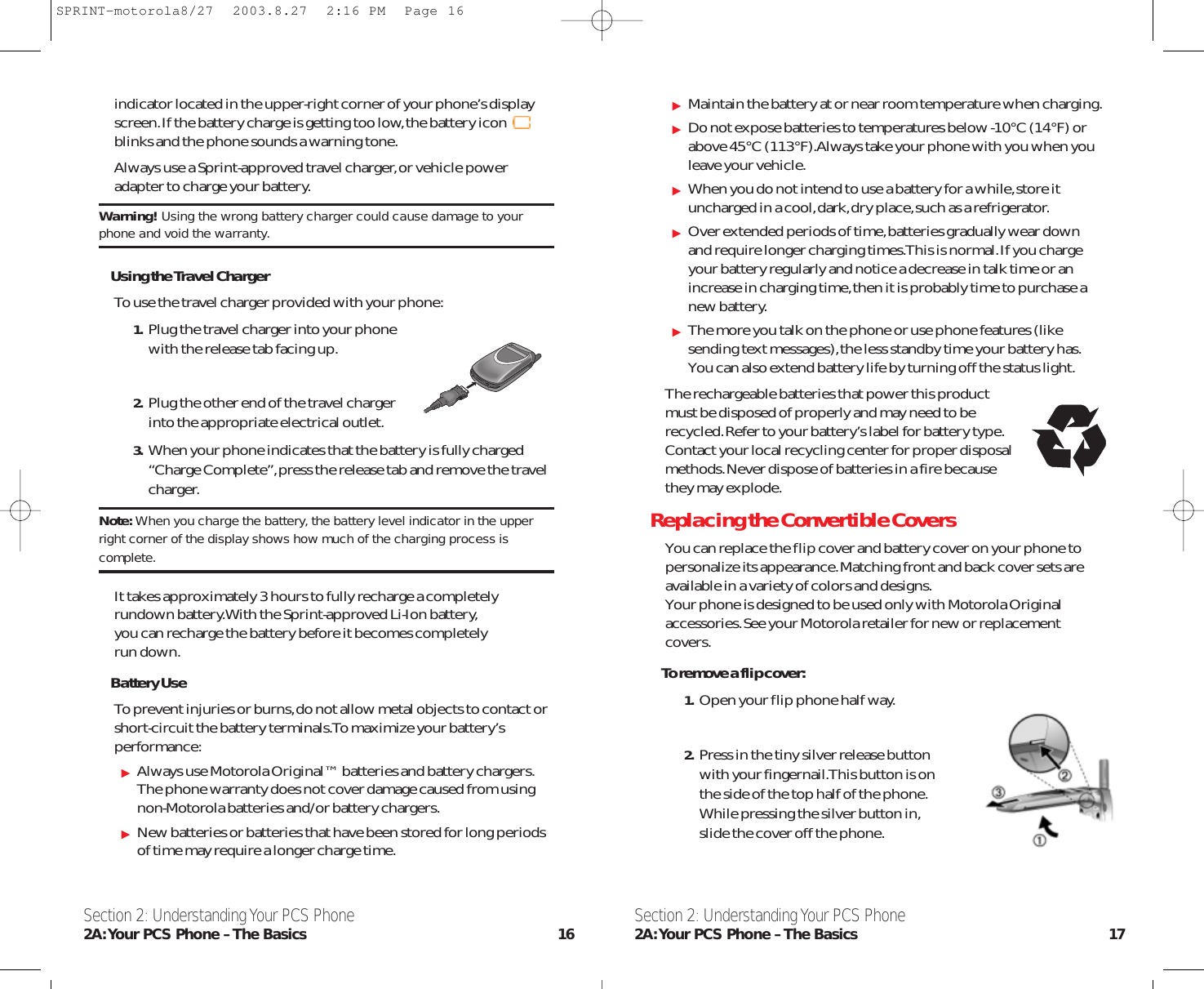
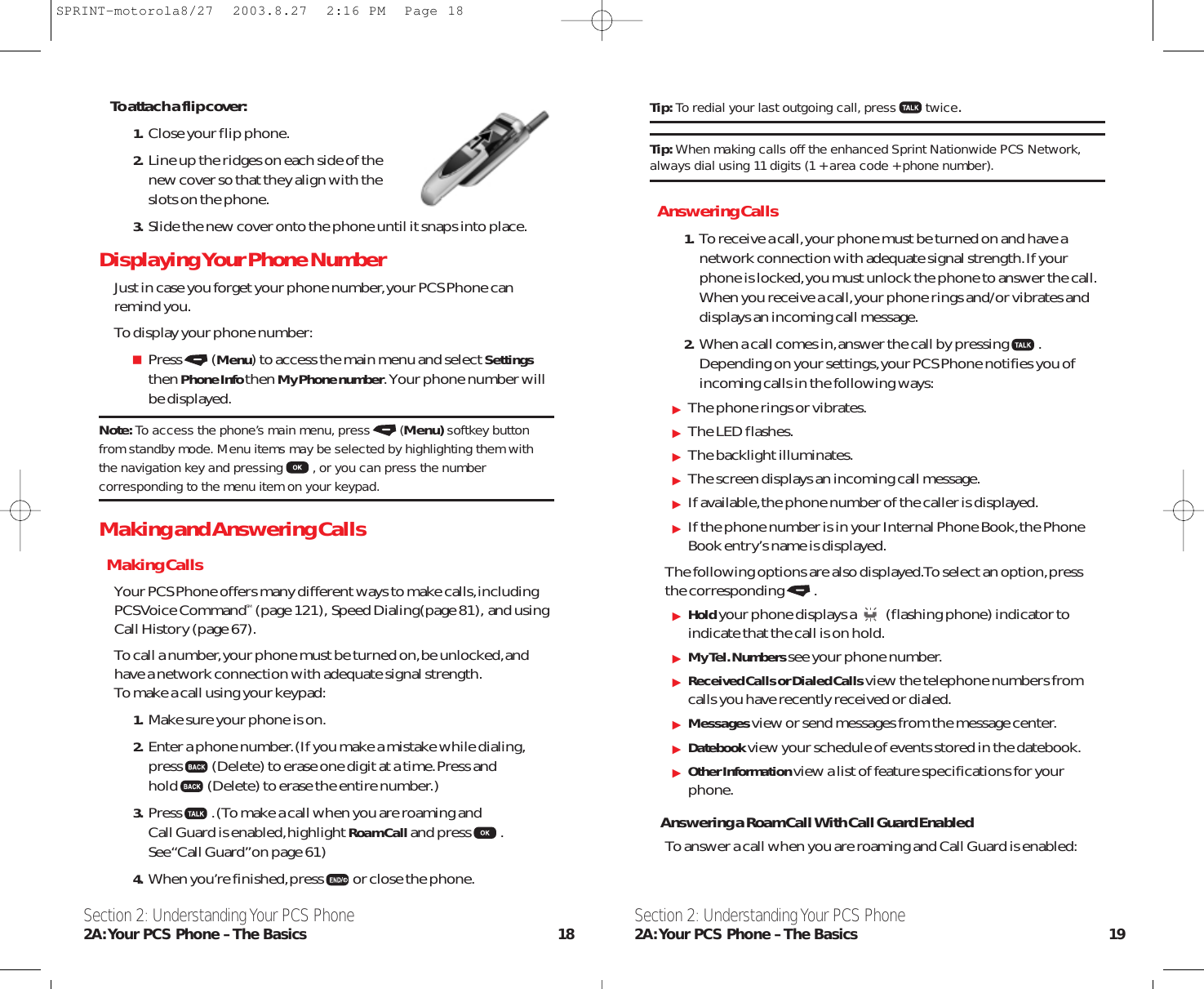
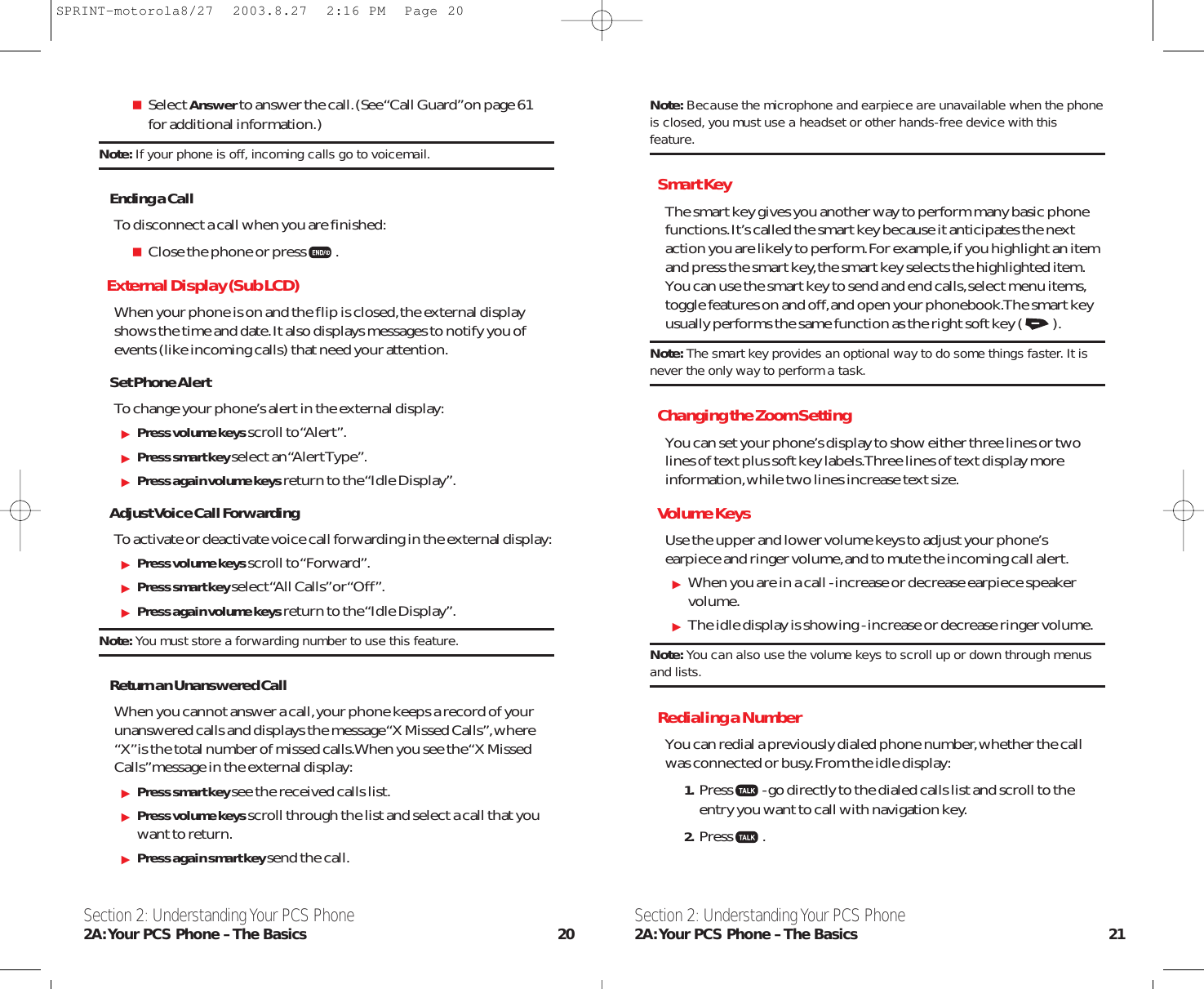
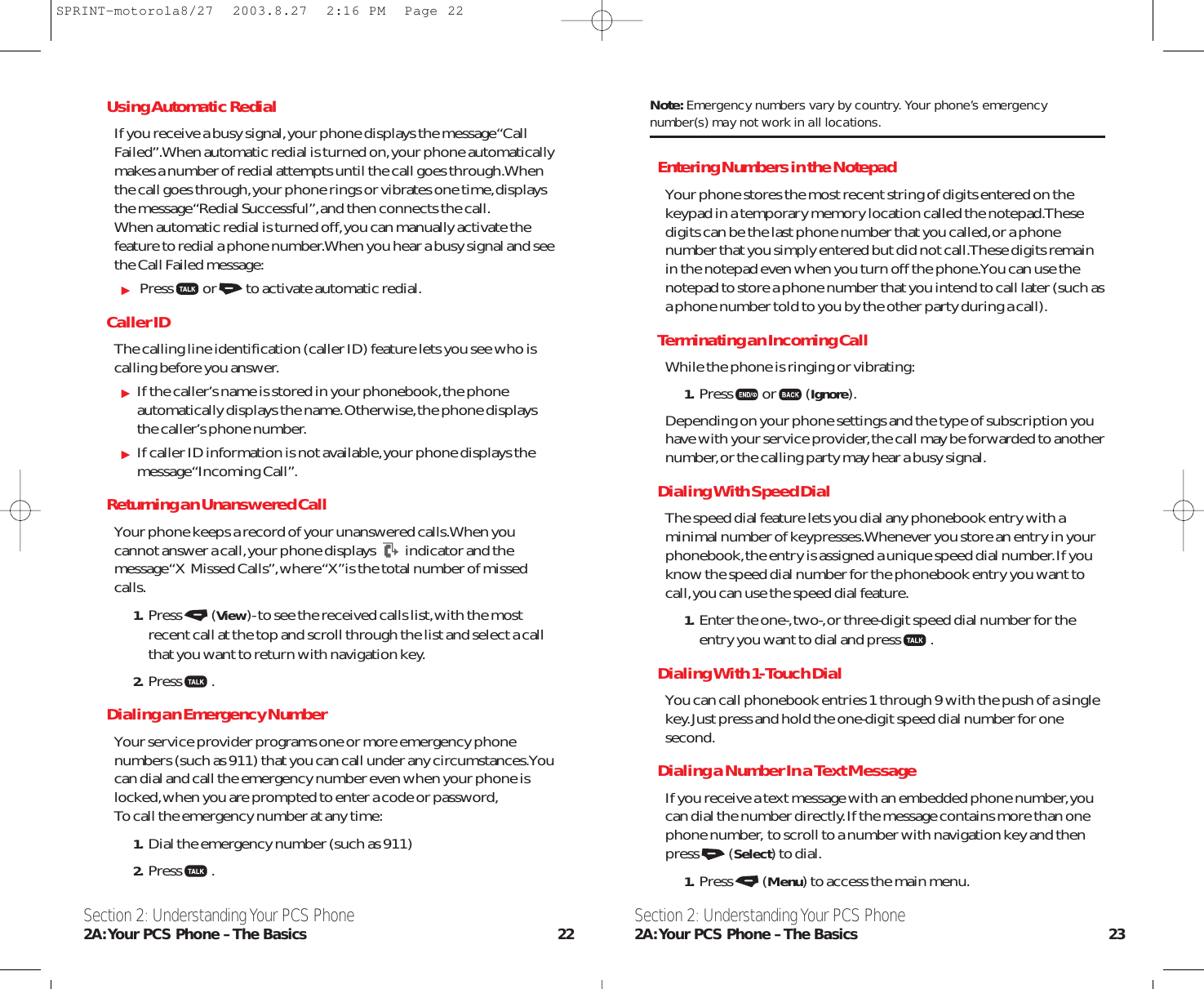
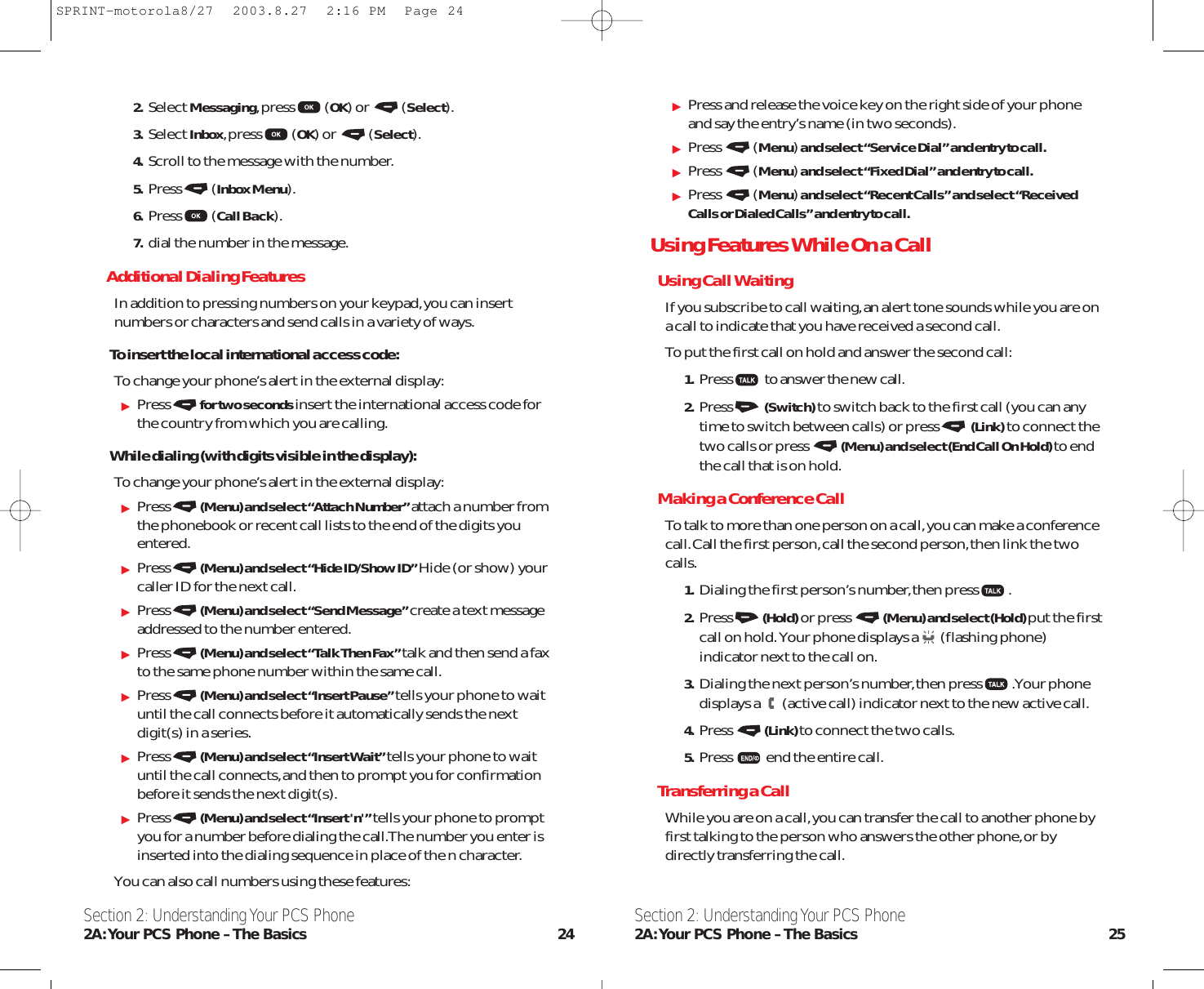
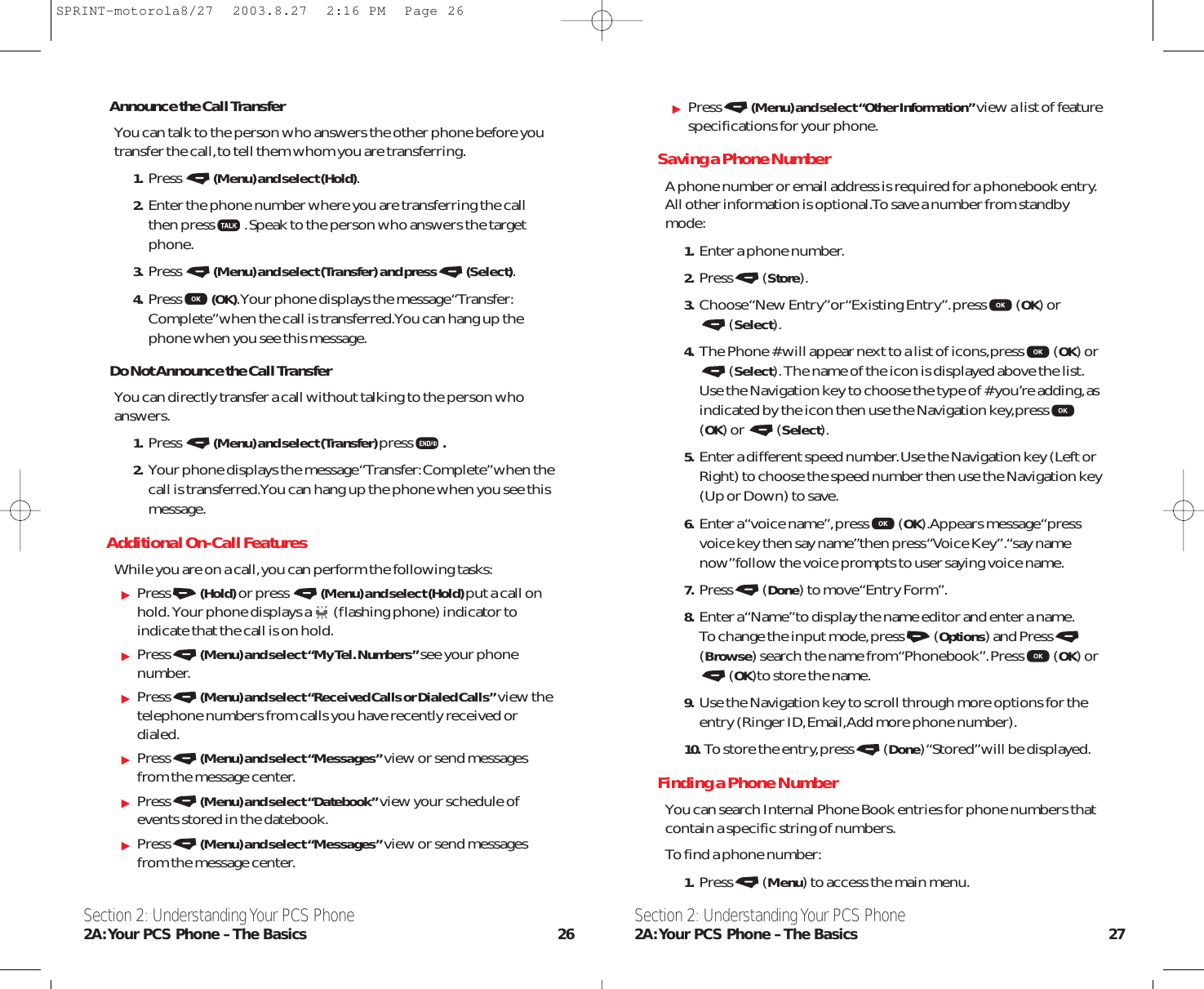
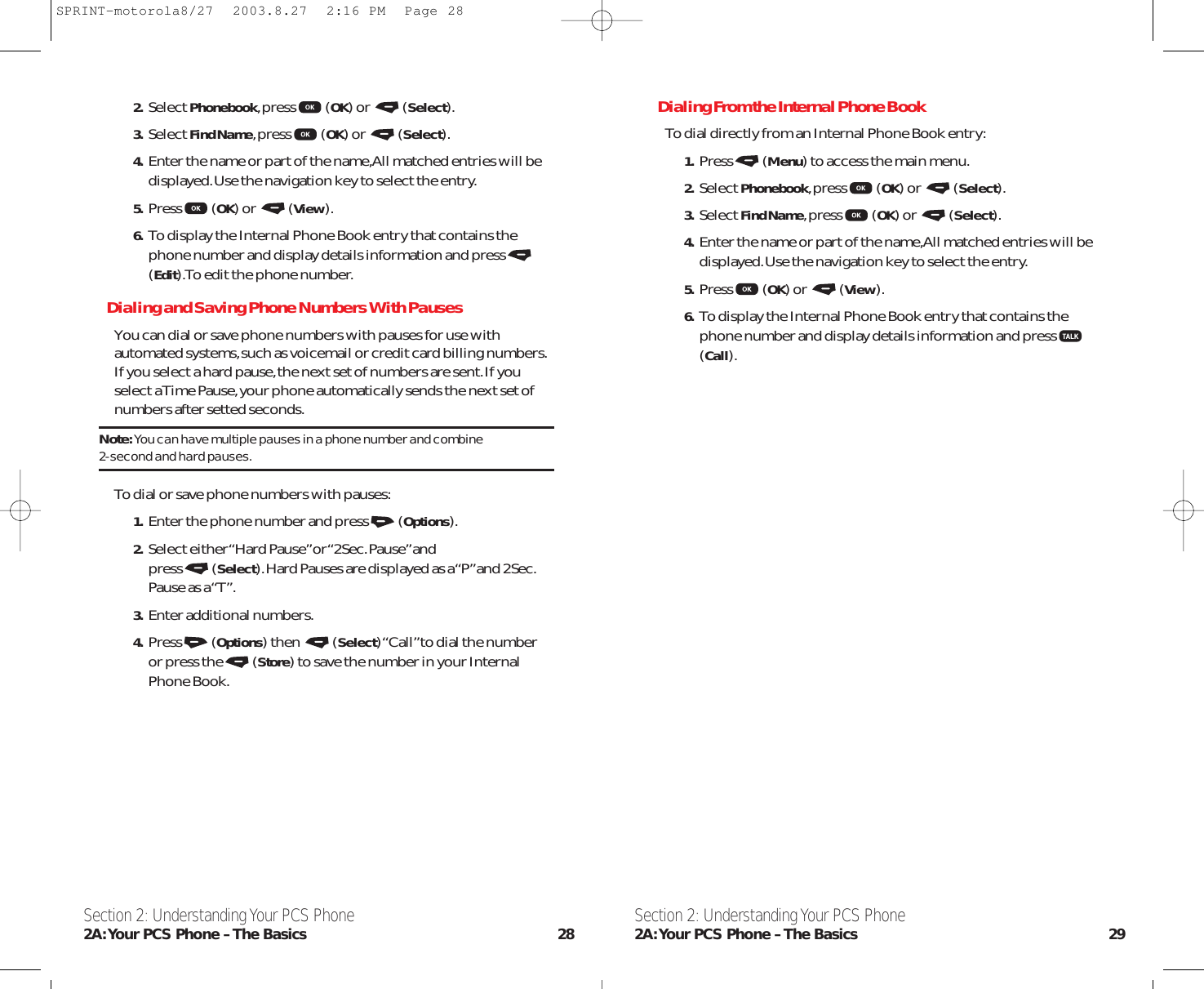
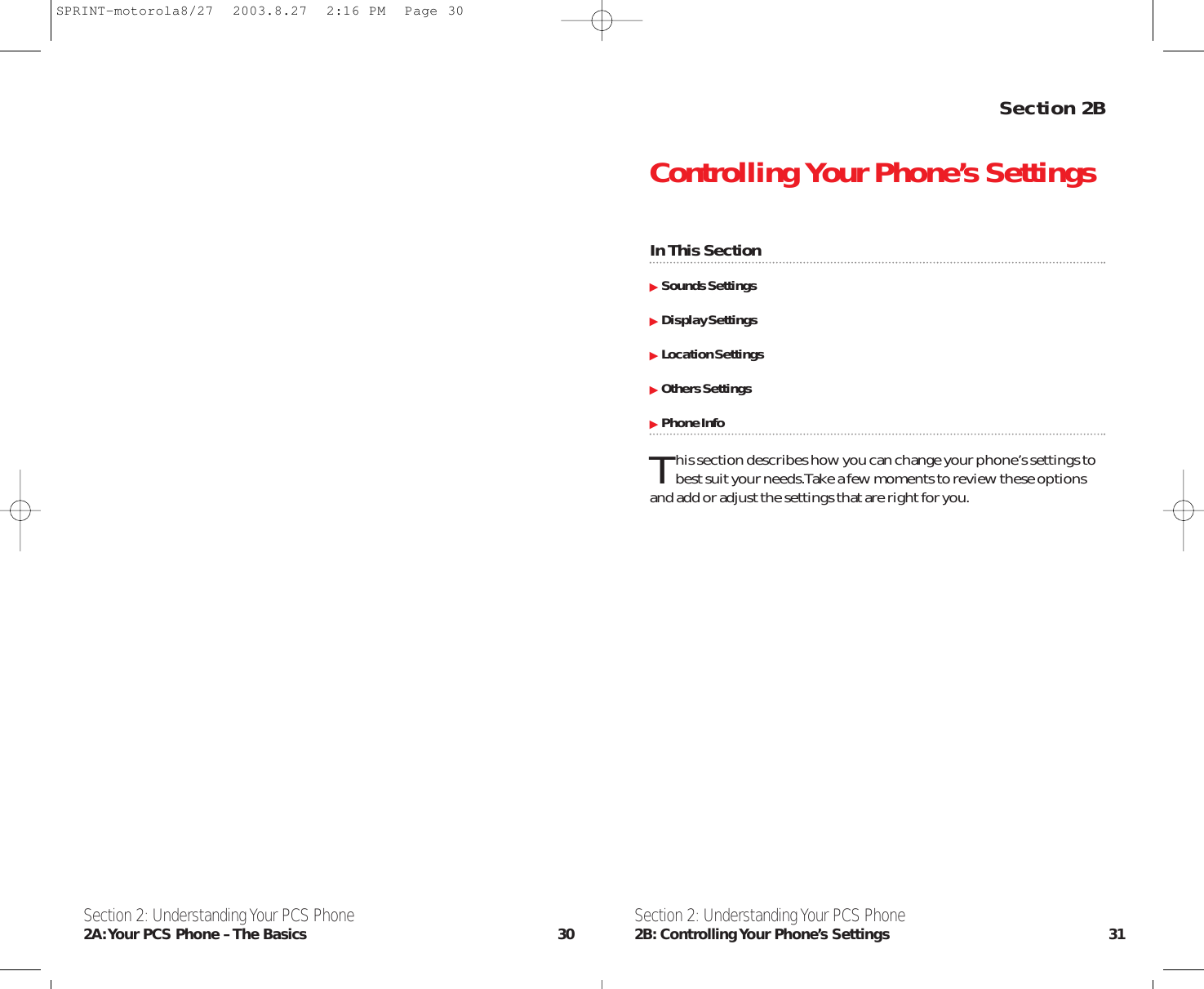
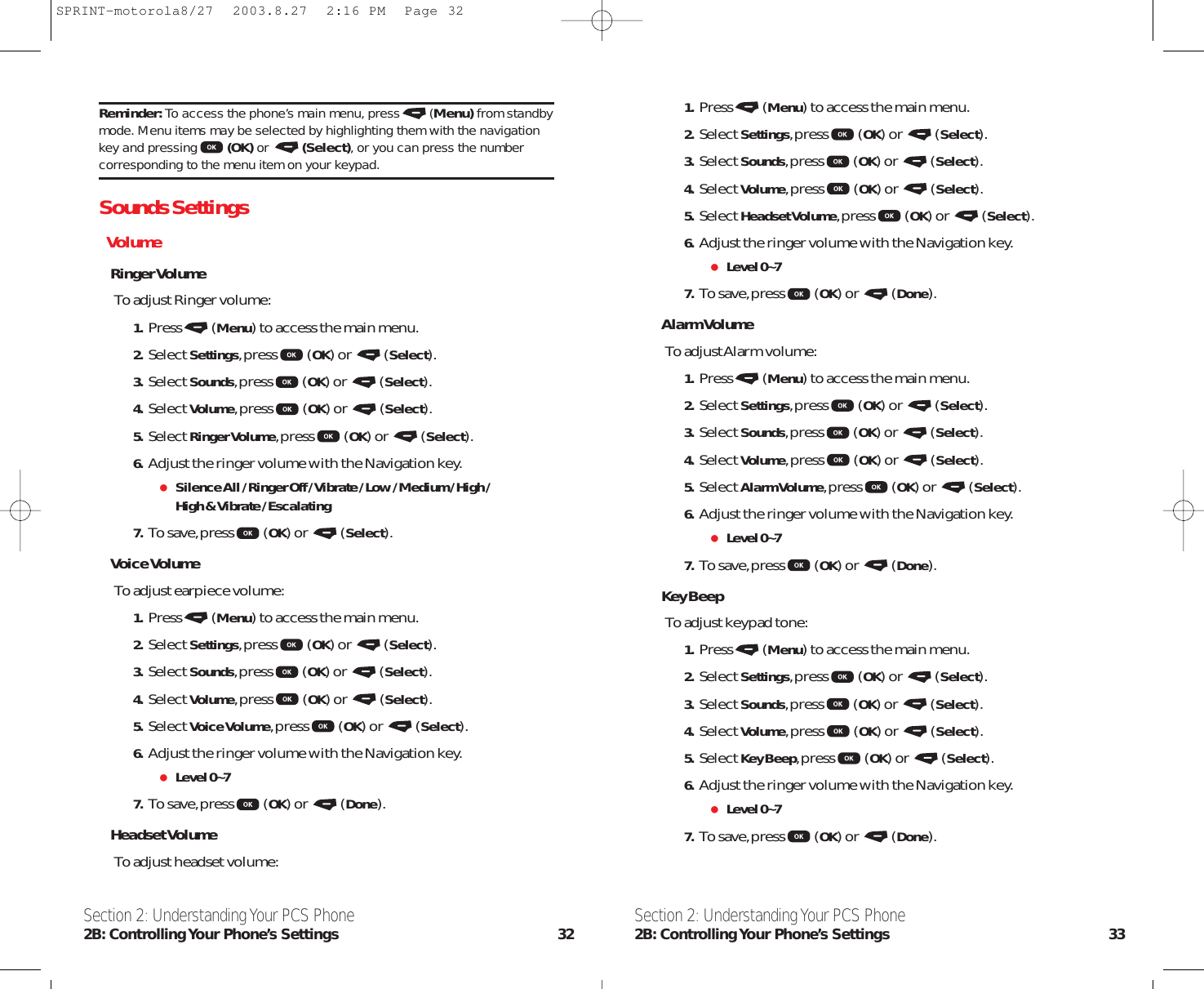
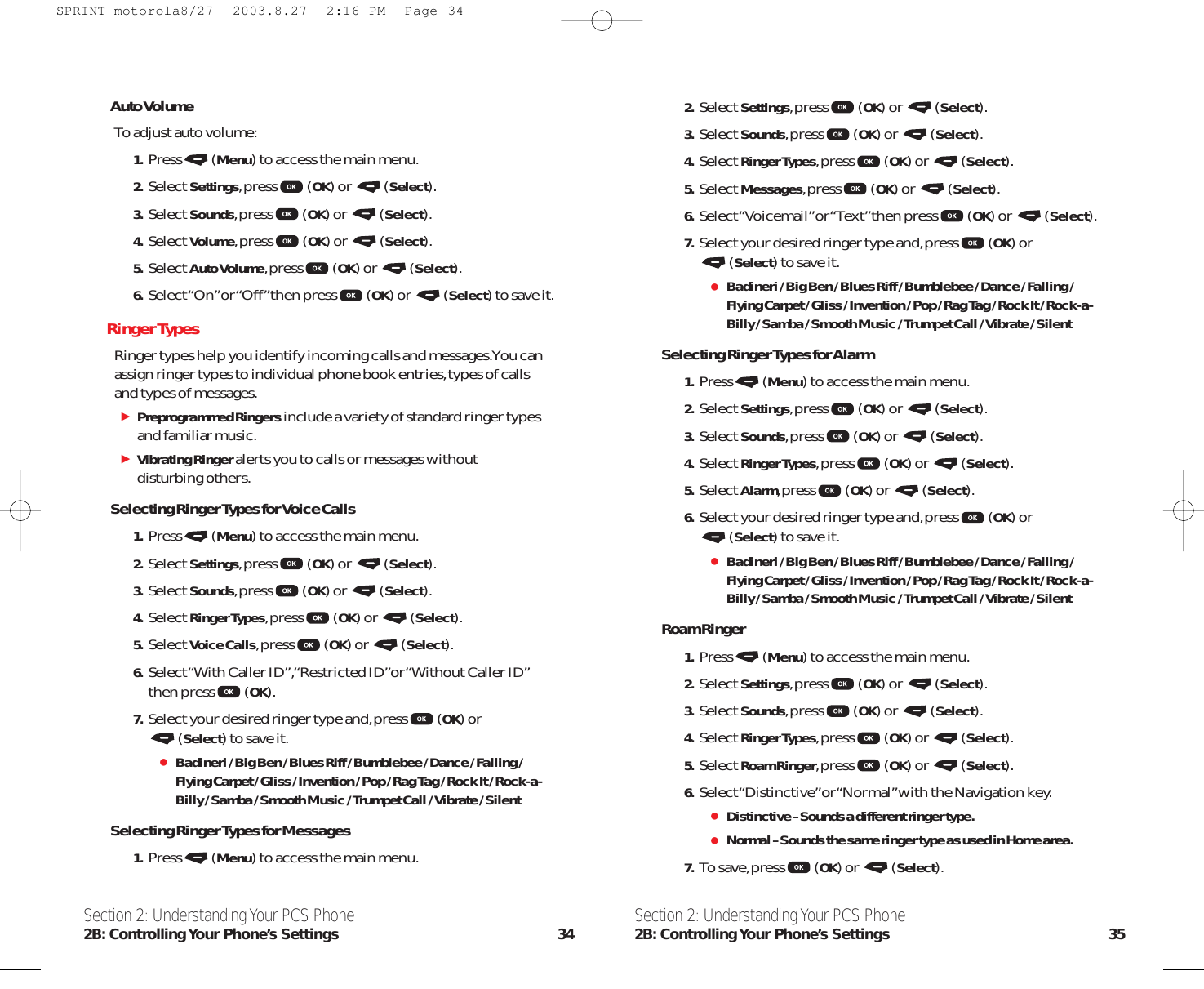
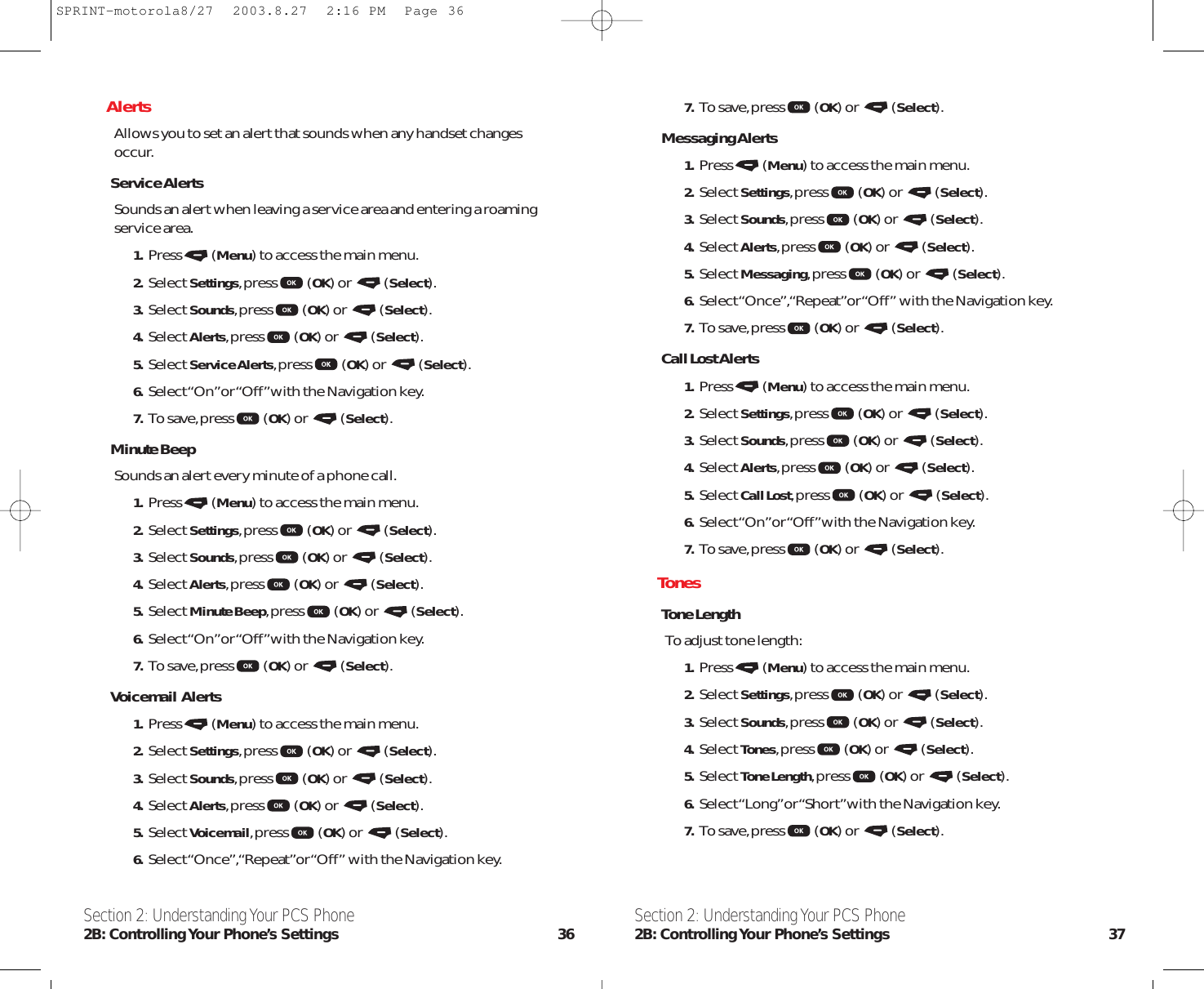
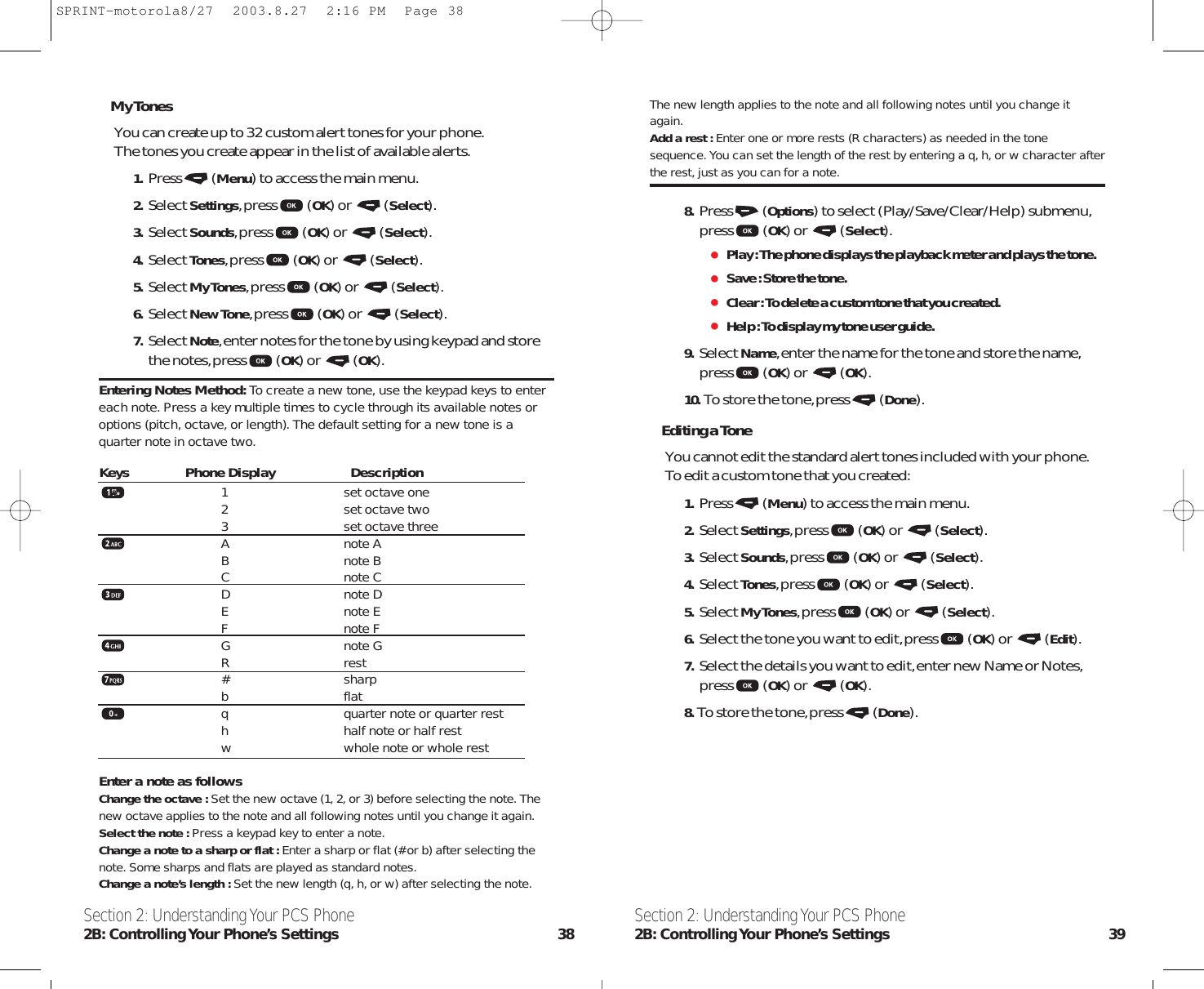
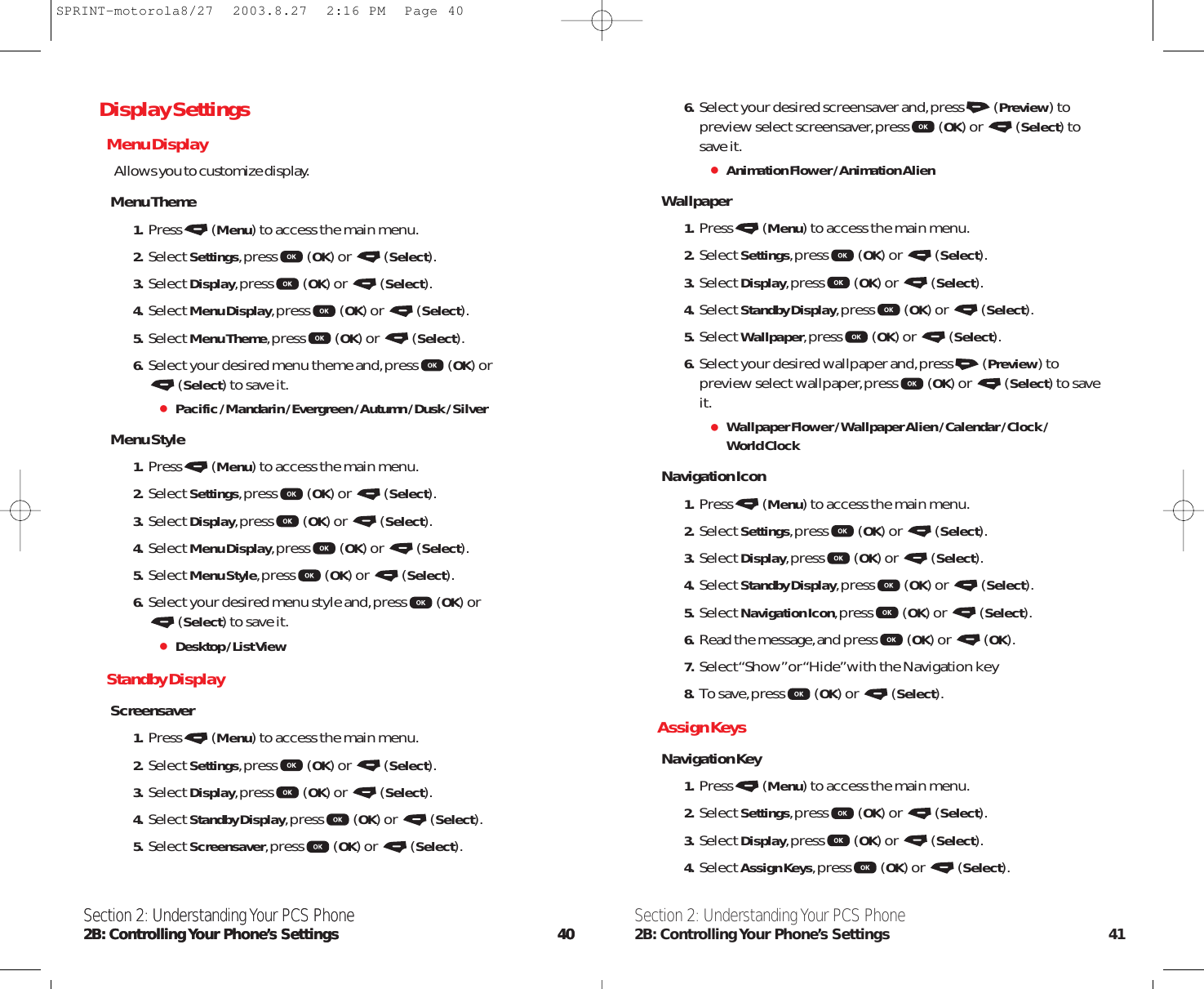
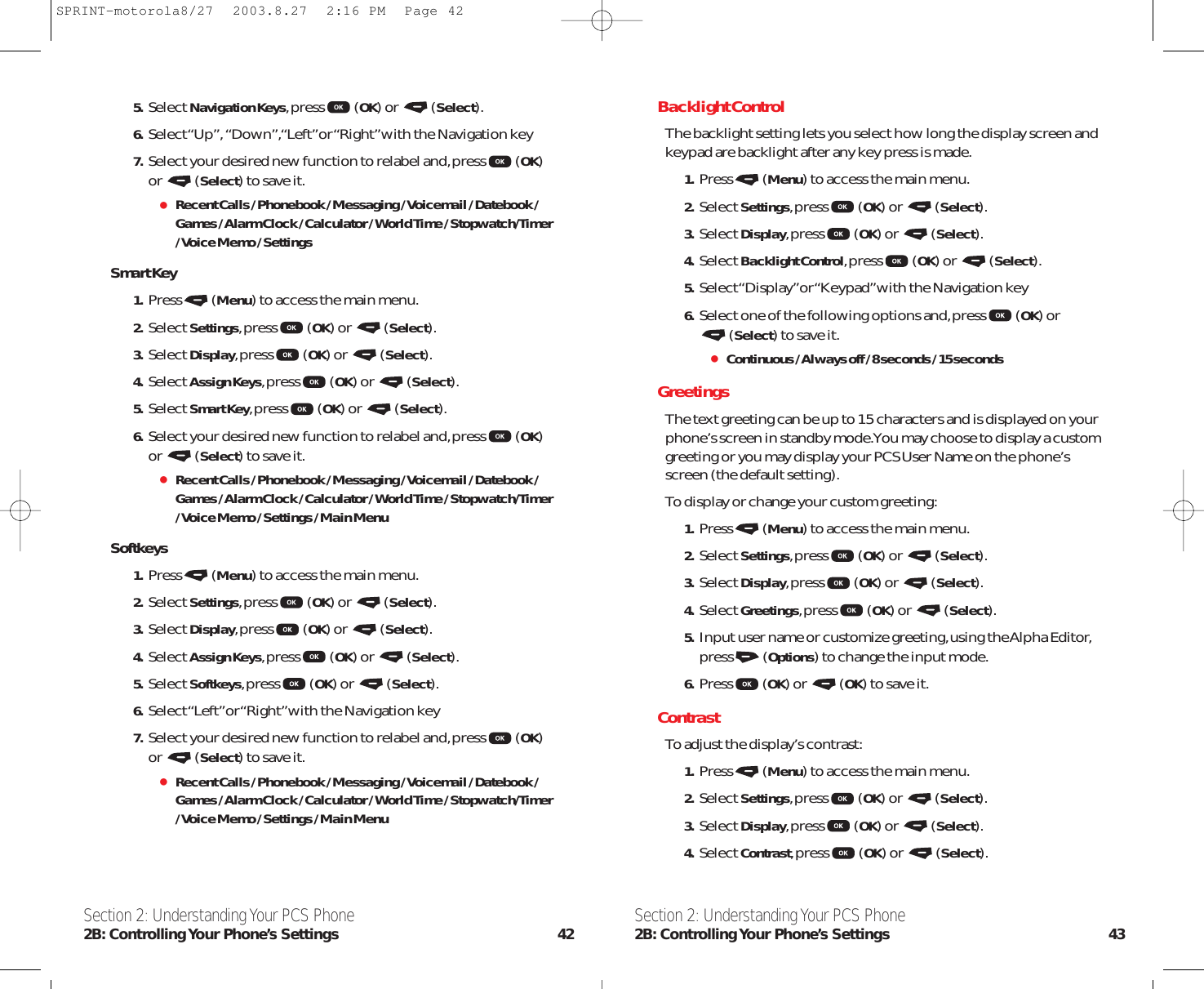
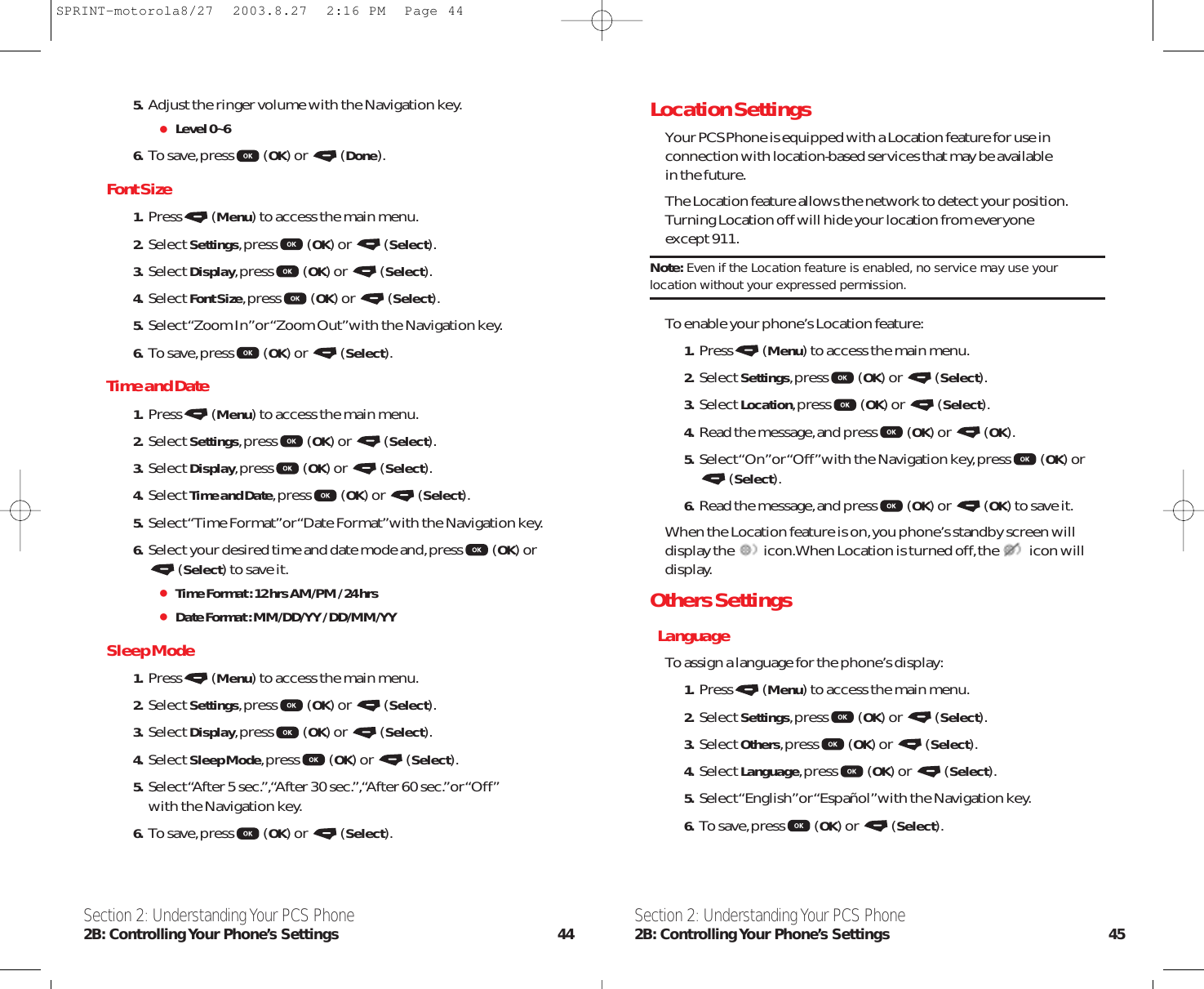
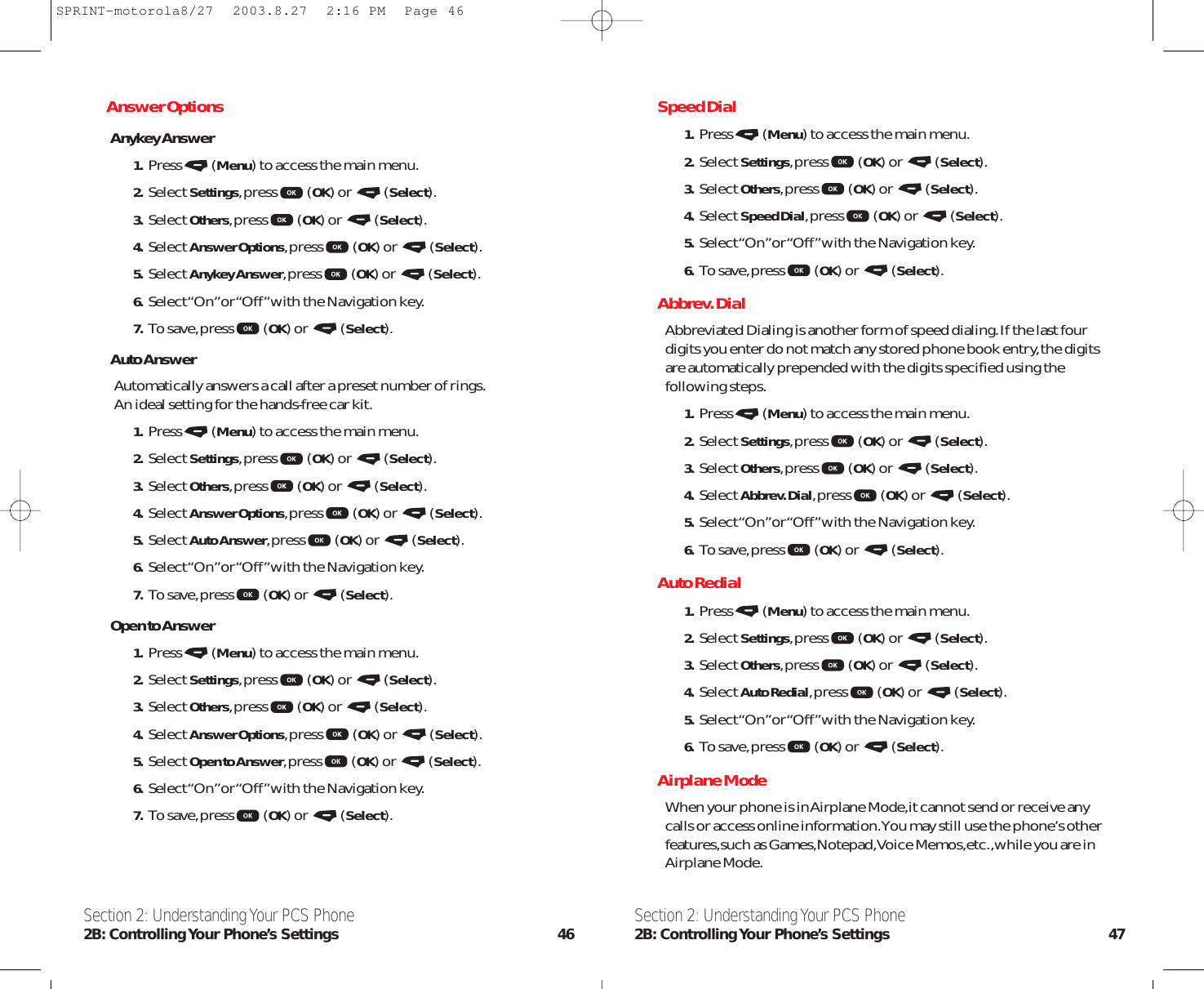
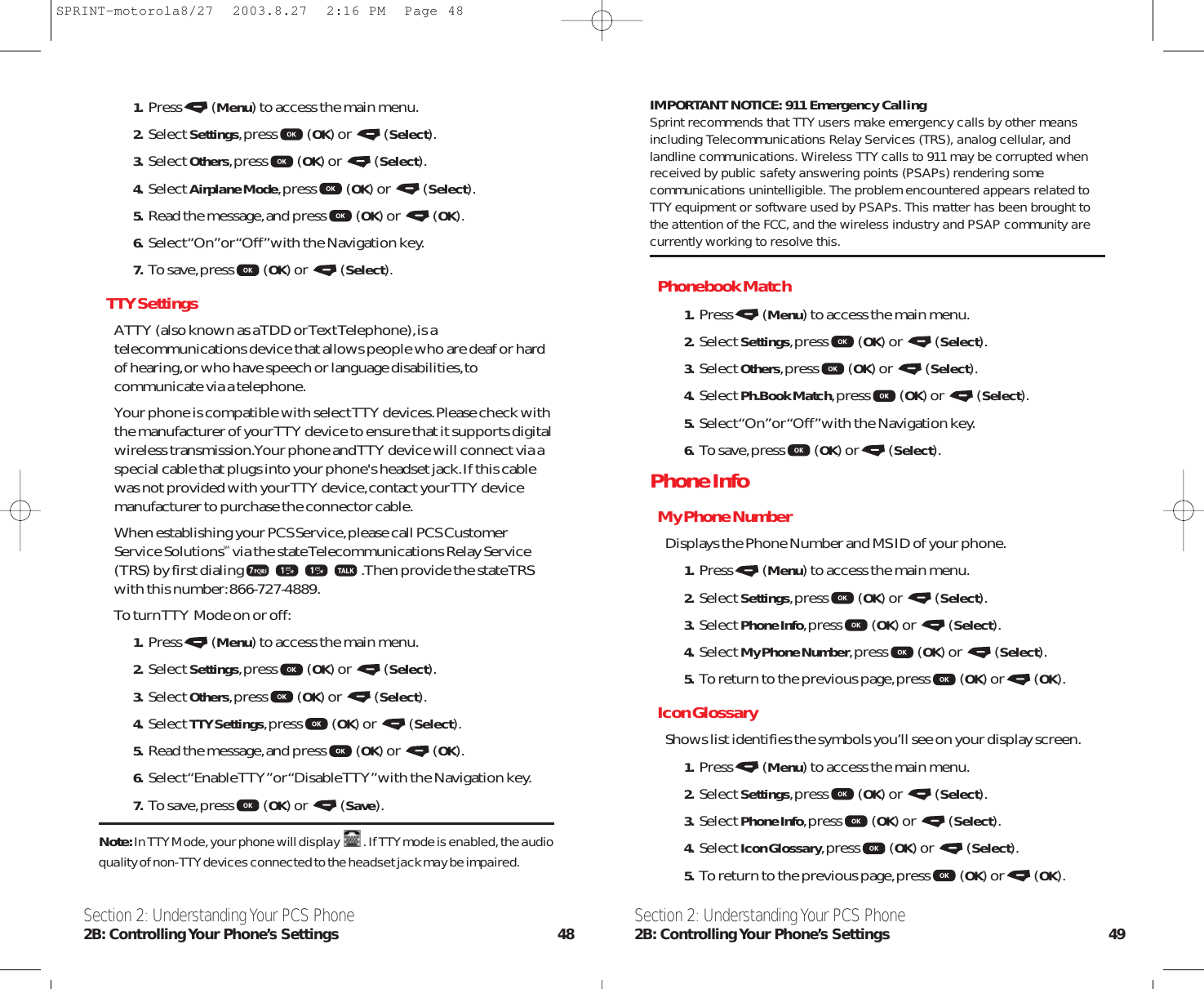
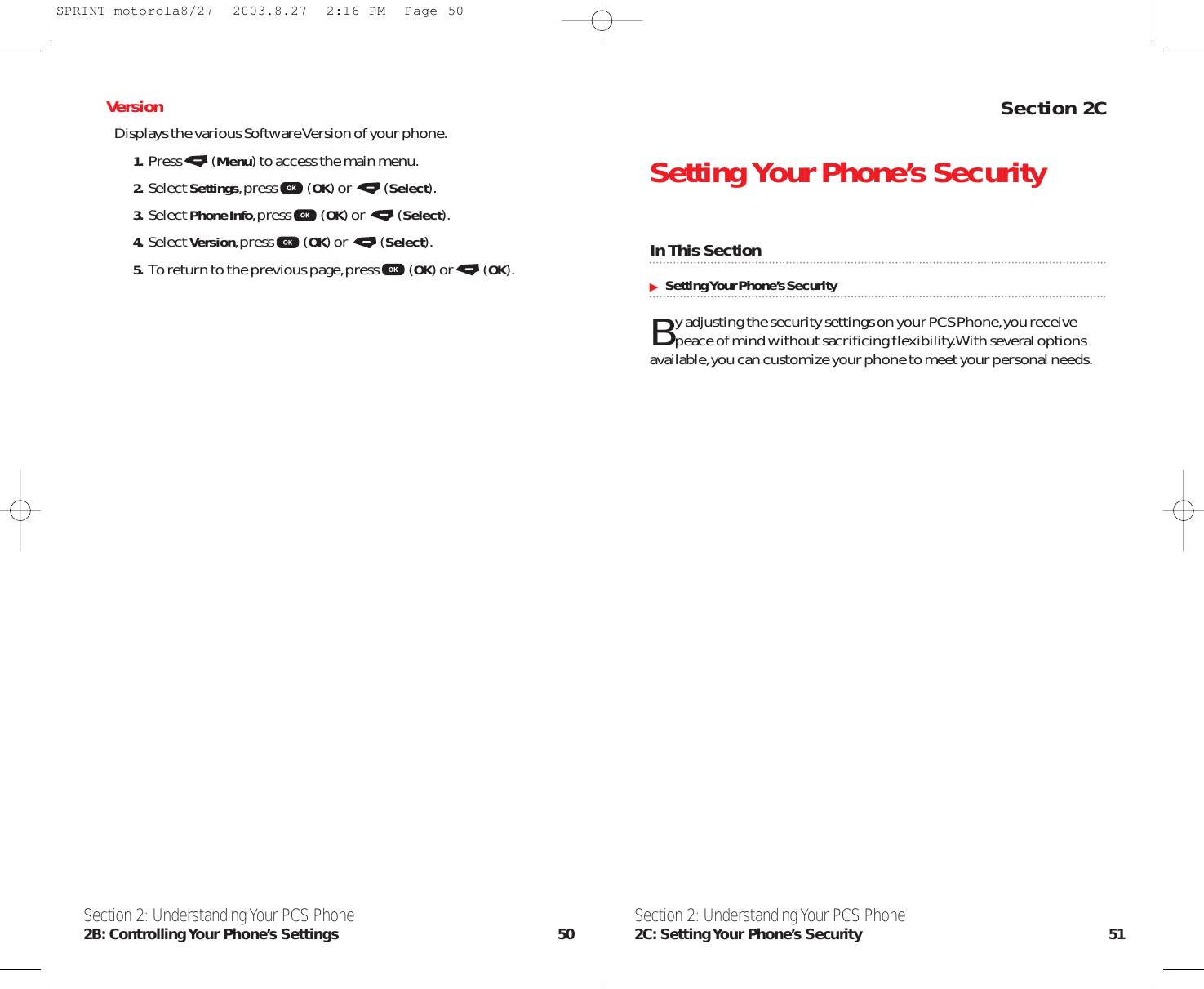
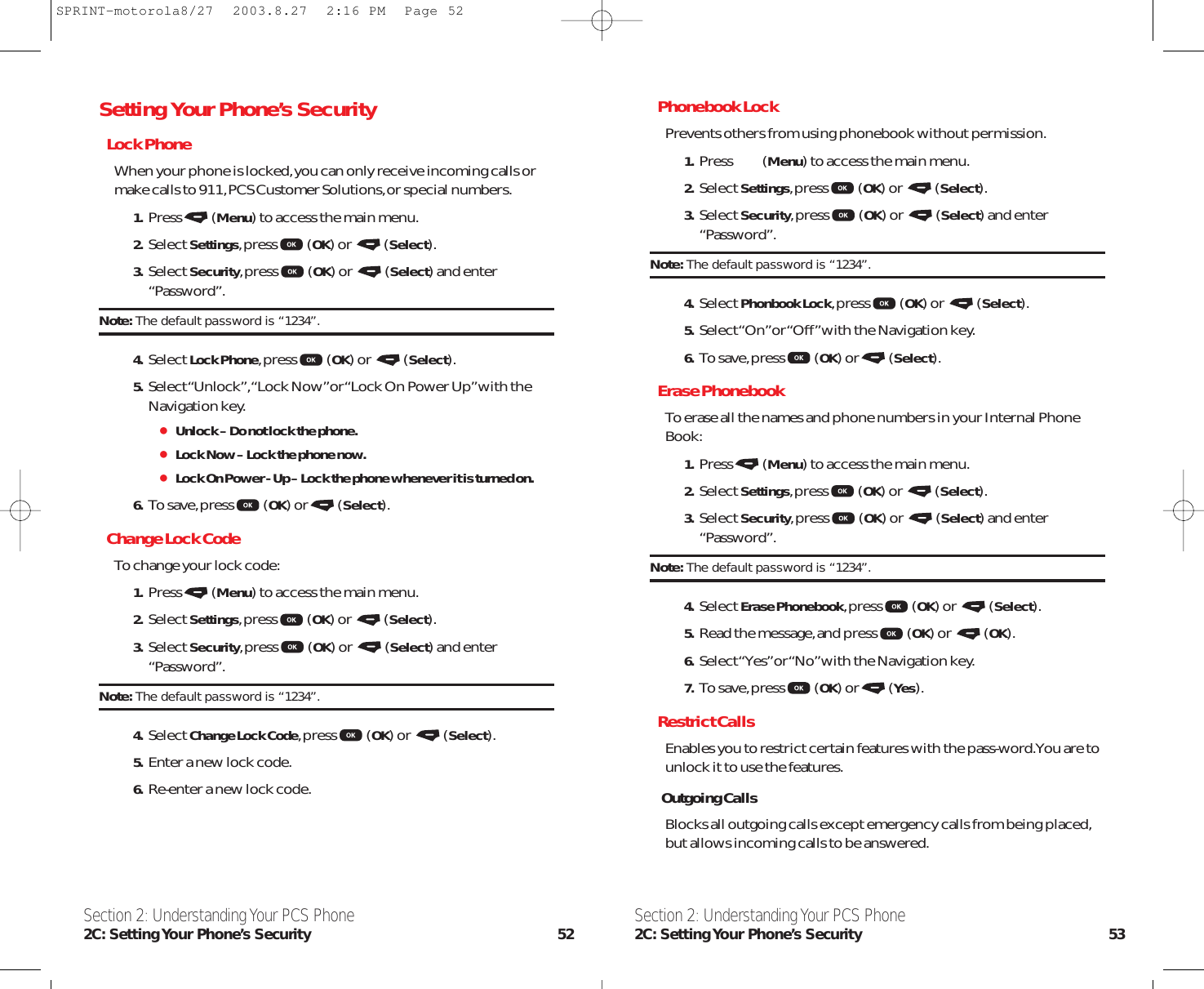
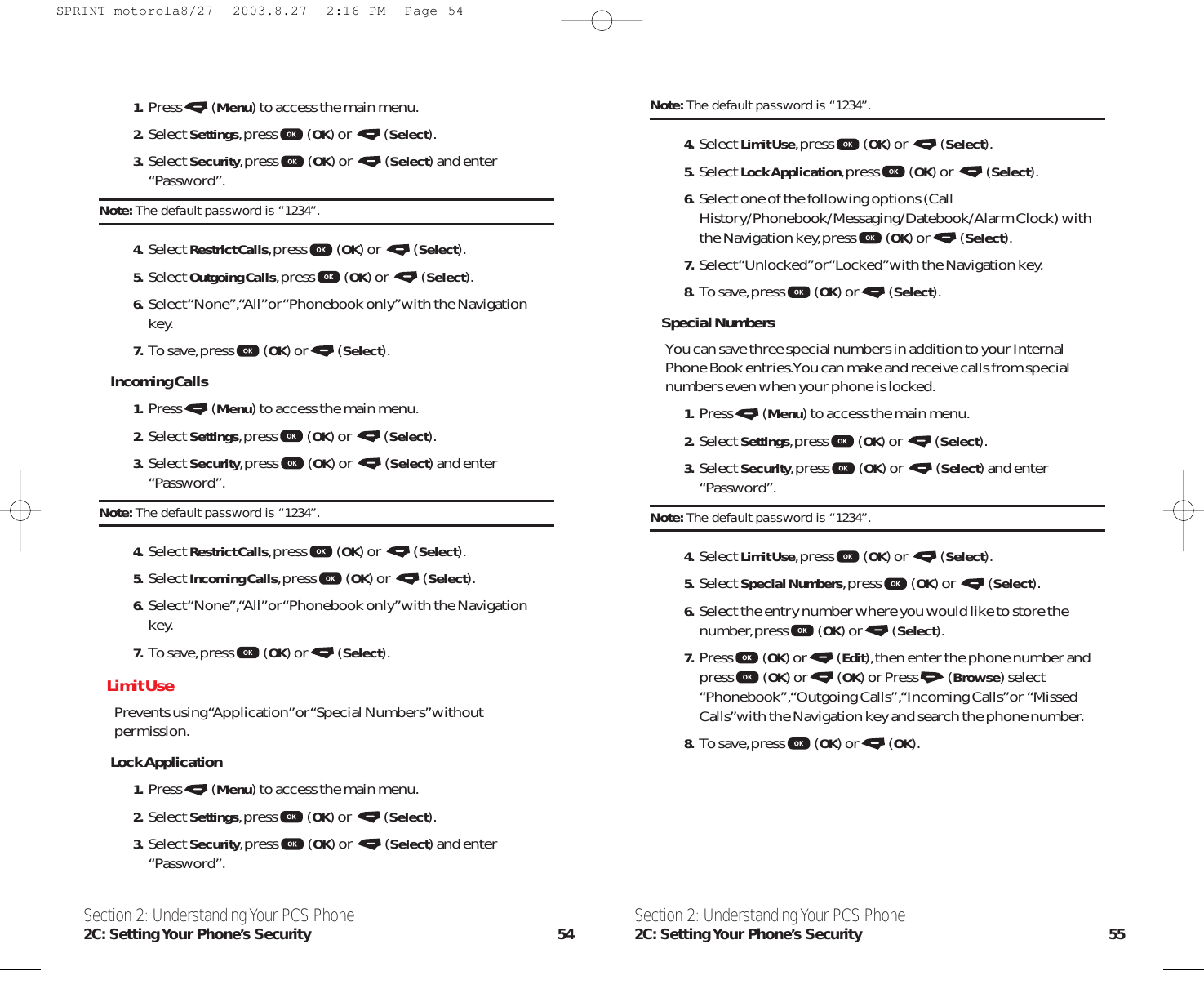
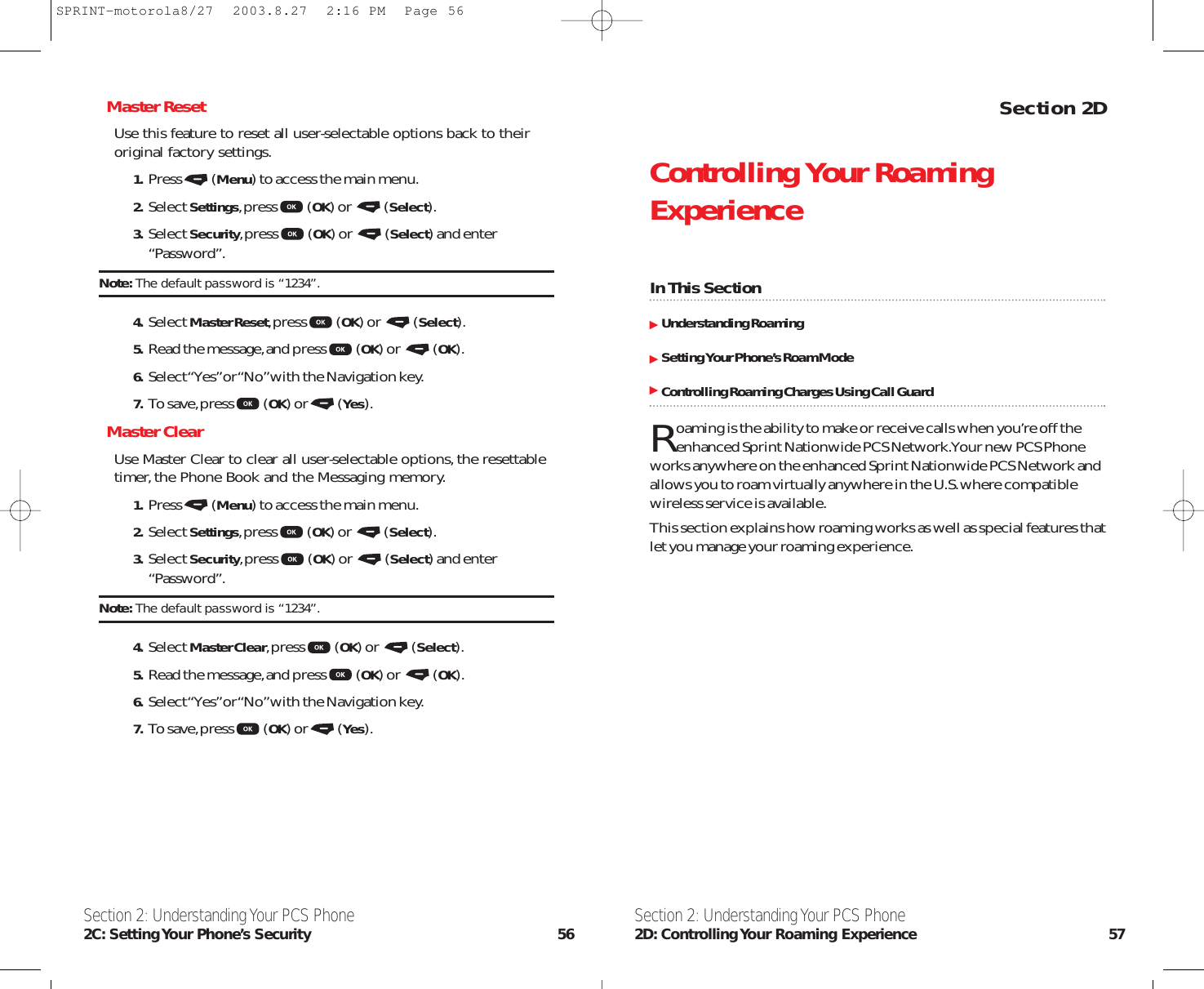
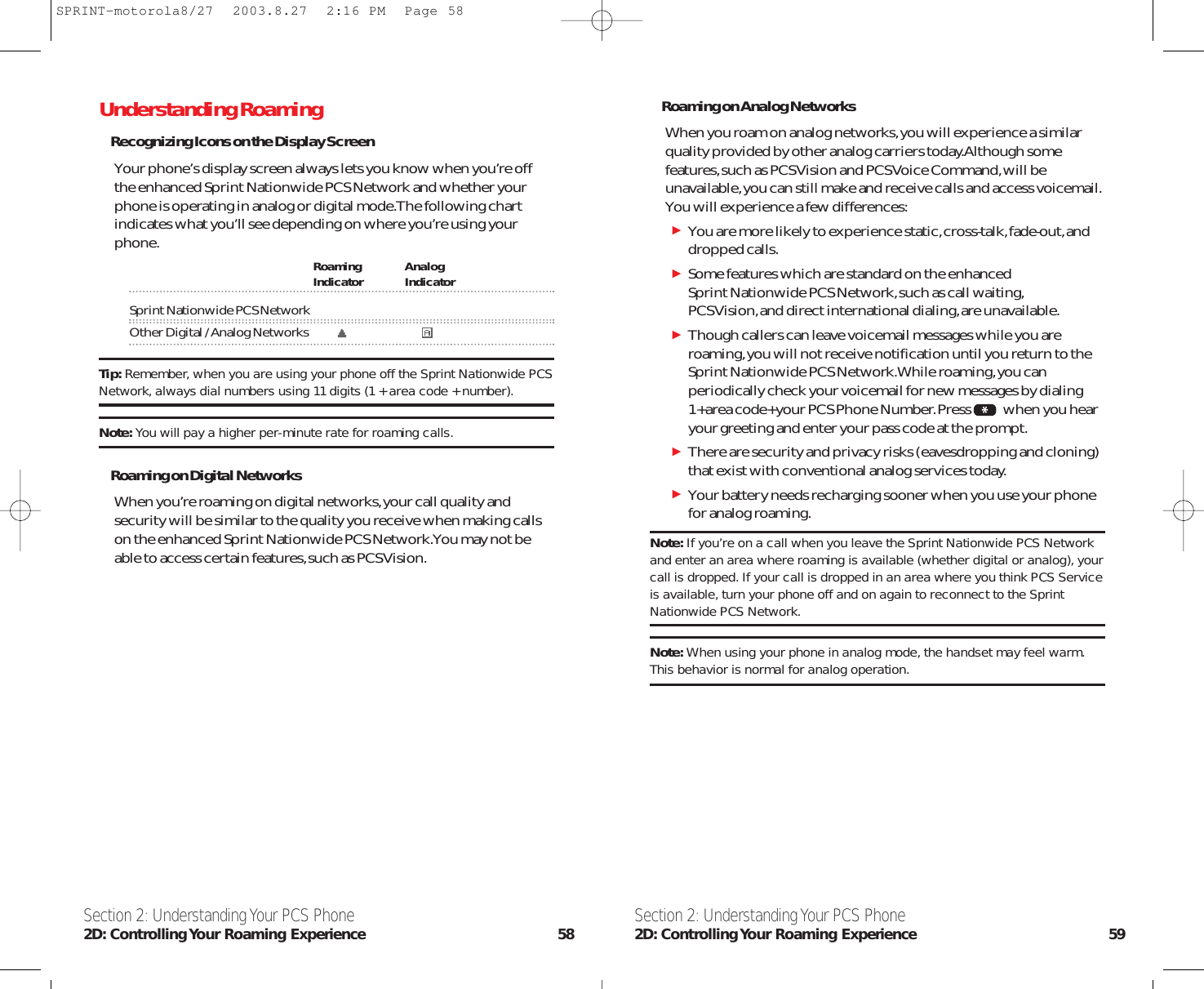
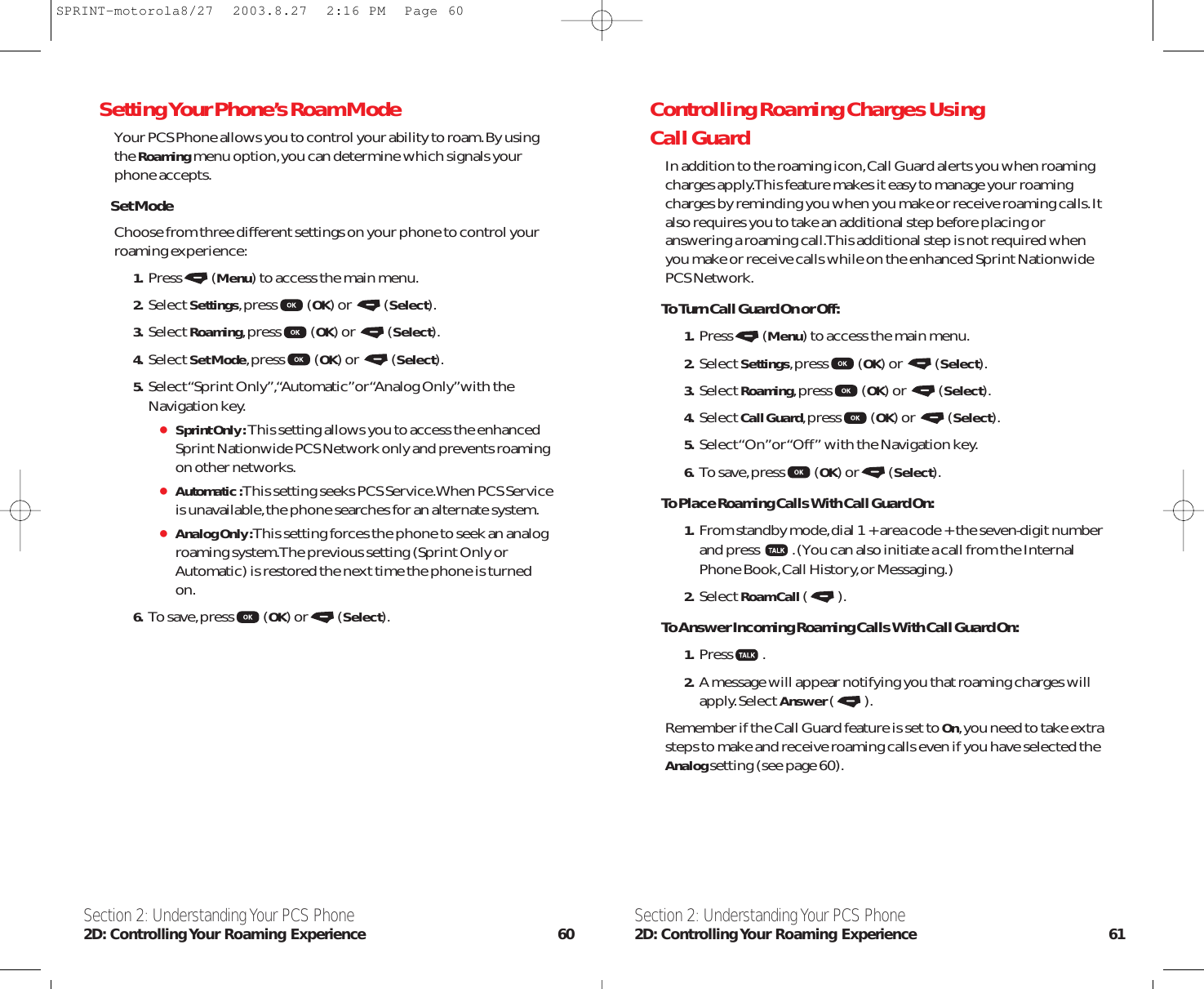
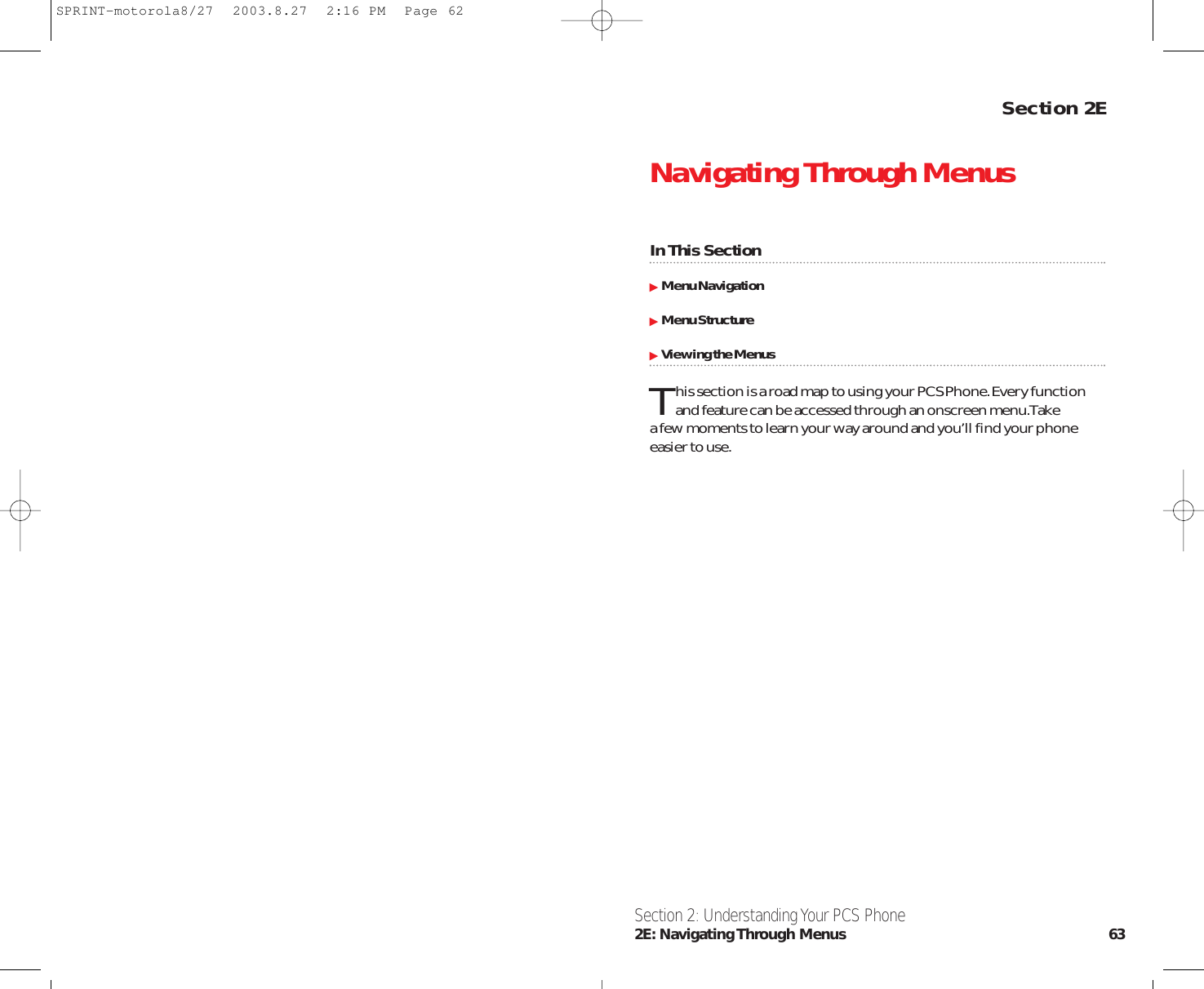
![Section 2: Understanding Your PCS Phone2E: Navigating Through Menus 65MenuNavigationThe navigation key on your PCS Phone allows you to scroll throughmenus quickly and easily.The scroll bar at the right of the menu keepstrack of your position in the menu at all times.To navigate through a menu,simply press the navigation key up ordown.If you are in a first-level menu,such as Settings,you may alsonavigate to the next or previous first-level menu by pressing thenavigation key right or left.Menu StructureSelecting Menu ItemsAs you navigate through the menu,menu options are highlighted.Select any numbered option by simply pressing the correspondingnumber on the phone’s keypad.You may also select any item byhighlighting it and pressing .For example,if you want to view your last incoming call:1. Press (Menu) to access the main menu.2. Select Recent Calls,press (OK) or (Select).3. Select Outgoing Calls,press (OK) or (Select).If you havereceived any calls,they are displayed on the screen.Backing Up Within a MenuTo go to the previous menu:Press .To return to standby mode:Press .Section 2: Understanding Your PCS Phone2E: Navigating Through Menus 64Viewing the MenusMenu DiagramThe following list outlines your phone’s menu structure.[SAMPLE MENU]Recent CallsOutgoing CallsIncoming CallsMissed CallsErase History Outgoing Calls/Incoming Calls/Missed Calls/All CallsPhone BookFind NameAdd New EntryMy Phone #Speed Dial #’sVoice NamesLong Phone #’sServicesPhone book StatusErase Phone bookMessagingComposeInboxOutboxSent FolderDrafts FolderQuick NotesSettingsVoice MailCall VoicemailClear IconGamesBejeweledBowlingFootballToolsDatebookAlarm ClockCalculatorWorld ClockStopwatch/TimerVoice MemoShortcutsSPRINT-motorola8/27 2003.8.27 2:16 PM Page 64](https://usermanual.wiki/Motorola-Mobility/T56DP1.Exhibit-8-Preliminary-Users-Manual/User-Guide-372493-Page-40.png)
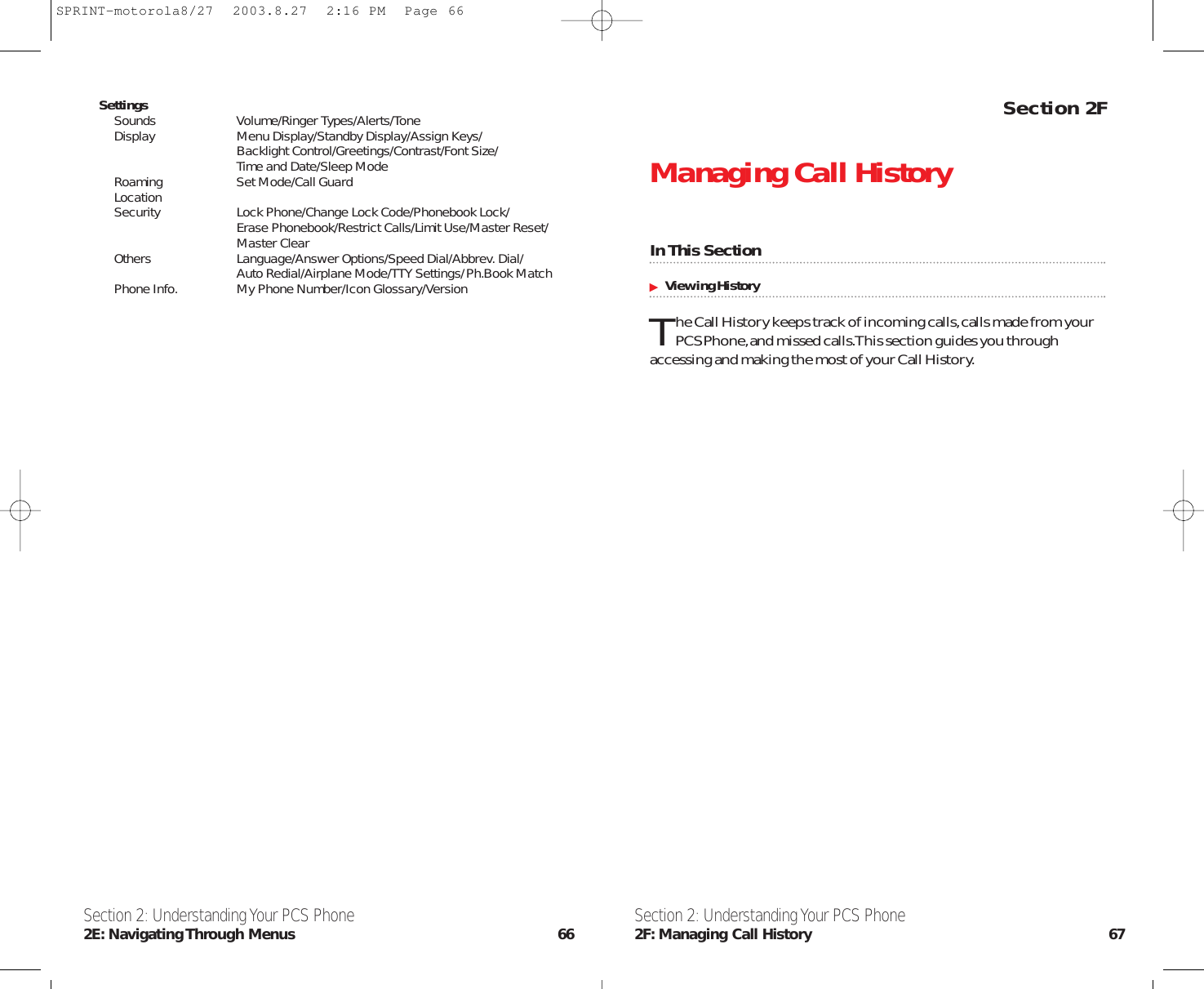
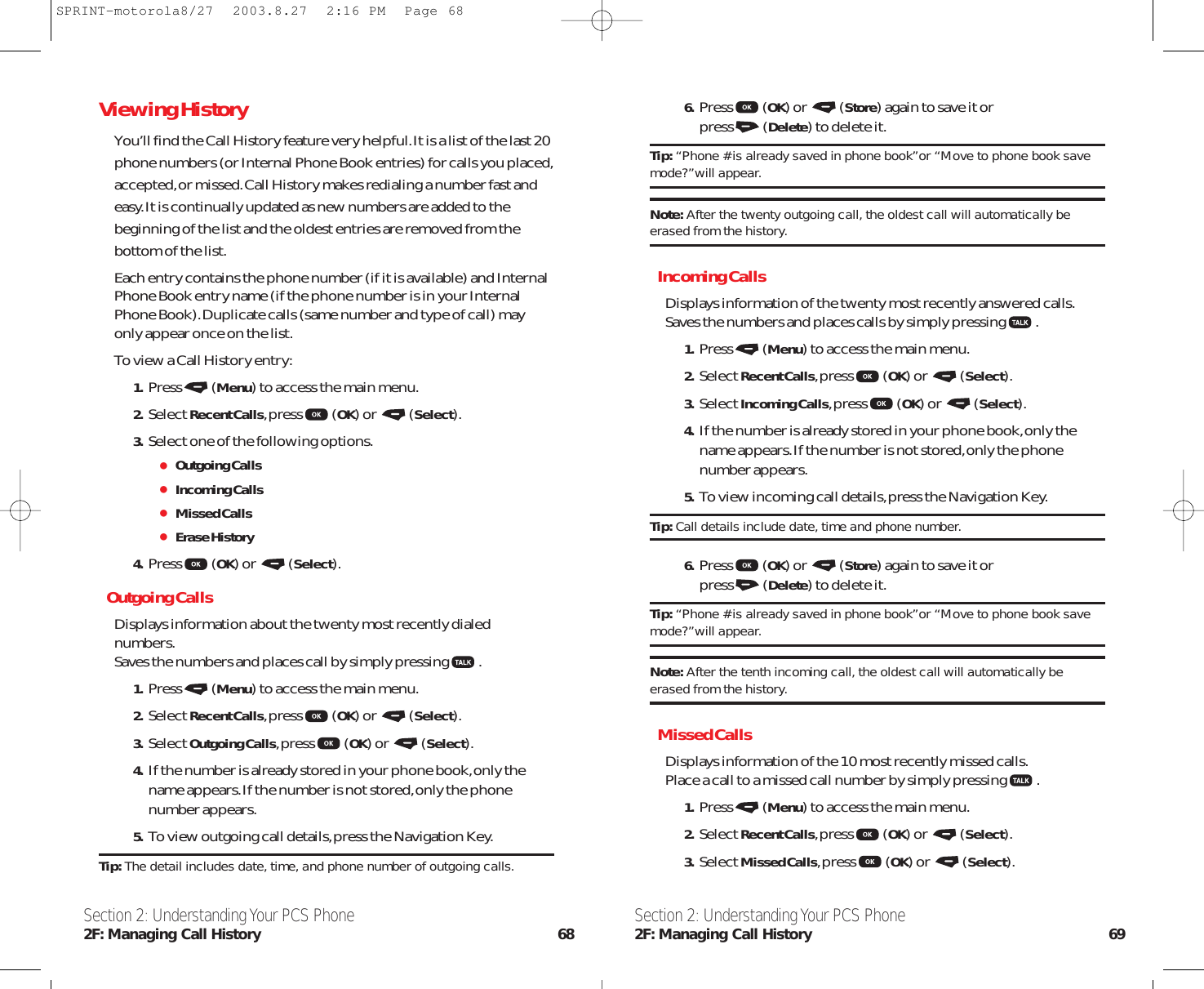
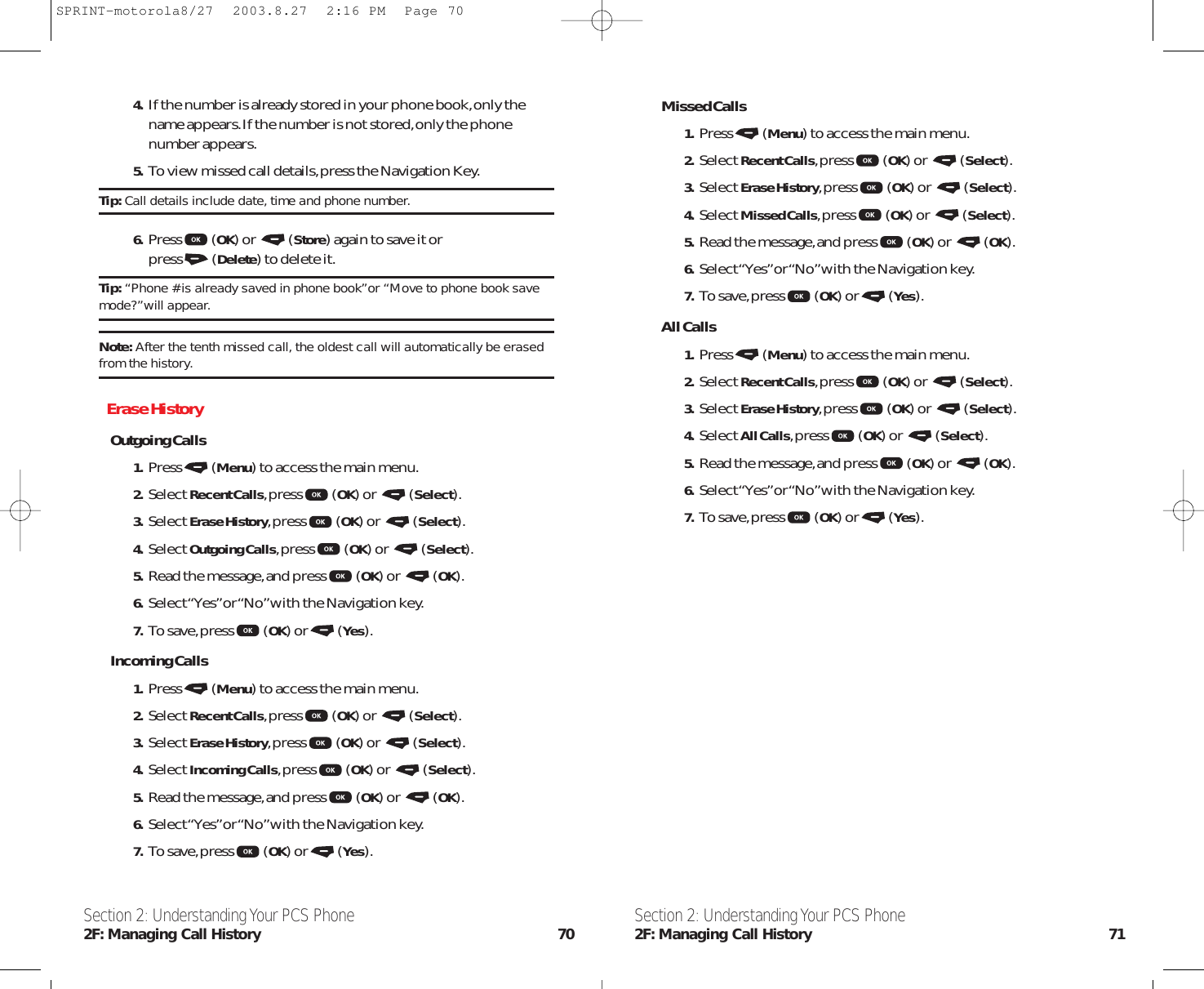
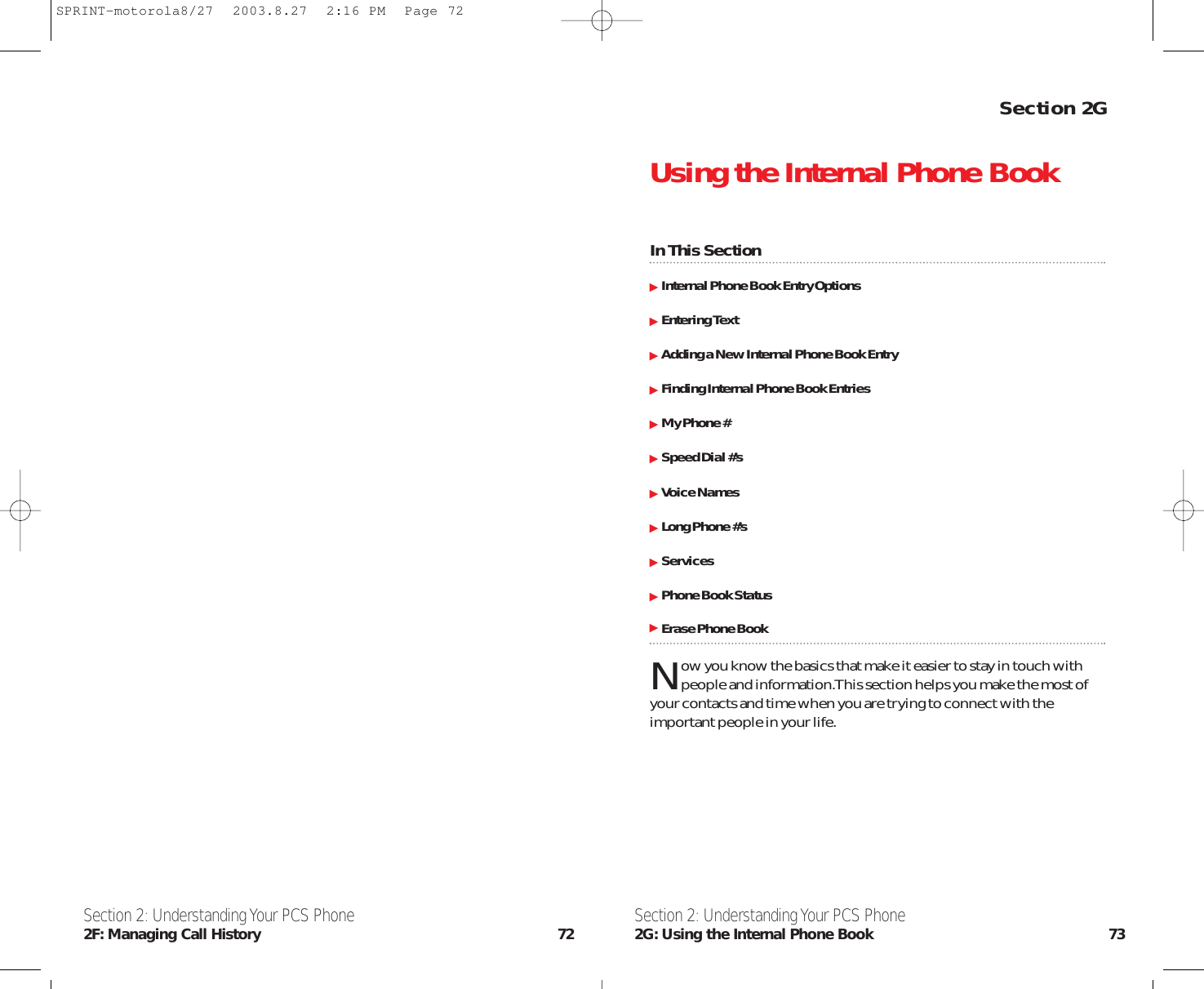
![Tap MethodTap method is the default standard mode for entering text on yourphone.To activate tap method from any text entry screen,press (Options) and select the Tap Method menu option.To enter text usingthe tap method:Press a number key one or more timescycle through the charactersassociated with the key and select the character you want.Continue to press number keysenter the rest of the characters inthe text message.Press (OK) or (OK) accept and store the text when youare finished.General Text Entry RulesUse the keypad to enter letters,numbers,symbols,and othercharacters with the tap method.Press the same key repeatedly tocycle through available charactersPress a number key as many times as necessary to enter thedesired character.Press and hold a number key to cycle between tap method andnumeric text entry mode.SpaceSwitch between lowercase to uppercase lettersIf you do not press a key for two seconds,the character in theblock cursor is accepted,and the cursor moves to the nextposition.The first character of every sentence is capitalized unless youmanually change it.(Press to force the character tolowercase while it is highlighted by the block cursor.)Section 2: Understanding Your PCS Phone2G: Using the Internal Phone Book 75Internal Phone Book Entry OptionsTo access an Internal Phone Book Entry’s options,display the entry.To select an option,highlight it and press .[Add number]to add a phone number to the entry.(See “Adding a New Internal Phone Book Entry”on page 79)[Name]to add an name to the entry.[Address]to add an address to the entry.Tip: You can view the next entry by pressing the navigation key right or view theprevious entry by pressing the navigation key left.Entering TextVarious text entry methods make it easy for you to enter names,numbers,and text messages on your phone.You can enter allcharacters (letters,numbers,and symbols) using the standard tapmethod.Other text modes let you easily enter numbers and symbols,or insert text already stored on your phone.Finally,a predictive textmode lets you enter text messages with a minimum of keypresses.Selecting a Character Input ModeTo activate a text mode,press (Options) from any text entryscreen and select the text mode from the Entry Method menu:1. When you display a screen where you can enter text,press (Options).2. Select a character input mode:iTAP Let the phone predict each word as you enter it,thenchoose the word from a list.Tap MethodEnter characters one at a time by pressing thekey for the letter,number,or symbol.This is the standardmode for entering text on your phone.NumericEnter only the number that appears on each key.Symbol Enter symbols only.BrowseBrowse through your phonebook lists to select aname or number to enter.Note: The text mode you select remains active until you change it by selectinganother mode.Section 2: Understanding Your PCS Phone2G: Using the Internal Phone Book 74SPRINT-motorola8/27 2003.8.27 2:16 PM Page 74](https://usermanual.wiki/Motorola-Mobility/T56DP1.Exhibit-8-Preliminary-Users-Manual/User-Guide-372493-Page-45.png)
![Section 2: Understanding Your PCS Phone2G: Using the Internal Phone Book 77Character ChartUse this chart as a guide for entering spaces,numbers,letters,symbols,and other characters with the tap method..,@1 ? ! *#/ A B C 2ÀÃÁÂÇD E F 3ÉÈÊG H I 4ÍJ K L 5M N O 6ÑÒÕÓÔP Q R S 7T U V 8ÙÚÜW X Y Z 90Entering SymbolYour phone provides an alternate way to find and enter symbolcharacters in a text message.You can view and select from a variety ofavailable symbols.To activate symbol mode from any text entryscreen,press (Options)and select the Symbol menu option.Toenter a symbol in symbol mode:Move cursor with navigation keyand select the symbol you want.. , : ; ! - @ ’ ” ? + * = / \ $ & # ( ) ˆ ˜ ` < > % _ | [ ] :) SP ¶ { }Press (OK) or (Select) accept symbol.Predictive Text Entry with iTAP™ SoftwareiTAP™ software provides a predictive text entry method that lets youenter the letters of a word using only one keypress per letter.Youmust activate iTAP software prior to entering letters.You can do thisfrom any text entry screen by pressing (Options) to open theEntry Method menu and selecting the iTAP menu option.Press a number key one timeenter the first letter of the word.Theletters associated with the key you pressed are shown at thebottom of the display.Section 2: Understanding Your PCS Phone2G: Using the Internal Phone Book 76Press number keysenter the rest of the word.Alternative wordsand letter combinations are shown at the bottom of the displaybased on the keys you press.These word choices are updatedwith each keypress.When you have entered all the letters of the word, press navigationkeylocate and highlight the word you want.Press (OK) or (Select) add the highlighted word to thetext area at the top of the display.A space is automaticallyinserted after the word.Enter Novel WordsYou may enter a word that is not in the iTAP software dictionary.Ifyou enter all the letters of a word but the word is not displayed:Press one or more times delete one or more letters until yousee a letter combination that matches the start of the word.Press navigation key highlight the letter or letter combination.Press (OK) or (Select) shift the text entry cursor to theleft and “lock”the selected portion of the word.Continue entering letters and highlighting letter combinations spellthe word.PunctuationThe iTAP software automatically adds a space after each word.Whenyou enter punctuation,this space is removed.To enter punctuationwith iTAP software:Press or enter punctuation or other characters.CapitalizationThe first word of a sentence is automatically capitalized,withfollowing words in lowercase.To set or adjust character capitalizationwith iTAP software:Press change the words to initial character capitalized,alluppercase characters,or all lowercase characters.SPRINT-motorola8/27 2003.8.27 2:16 PM Page 76](https://usermanual.wiki/Motorola-Mobility/T56DP1.Exhibit-8-Preliminary-Users-Manual/User-Guide-372493-Page-46.png)
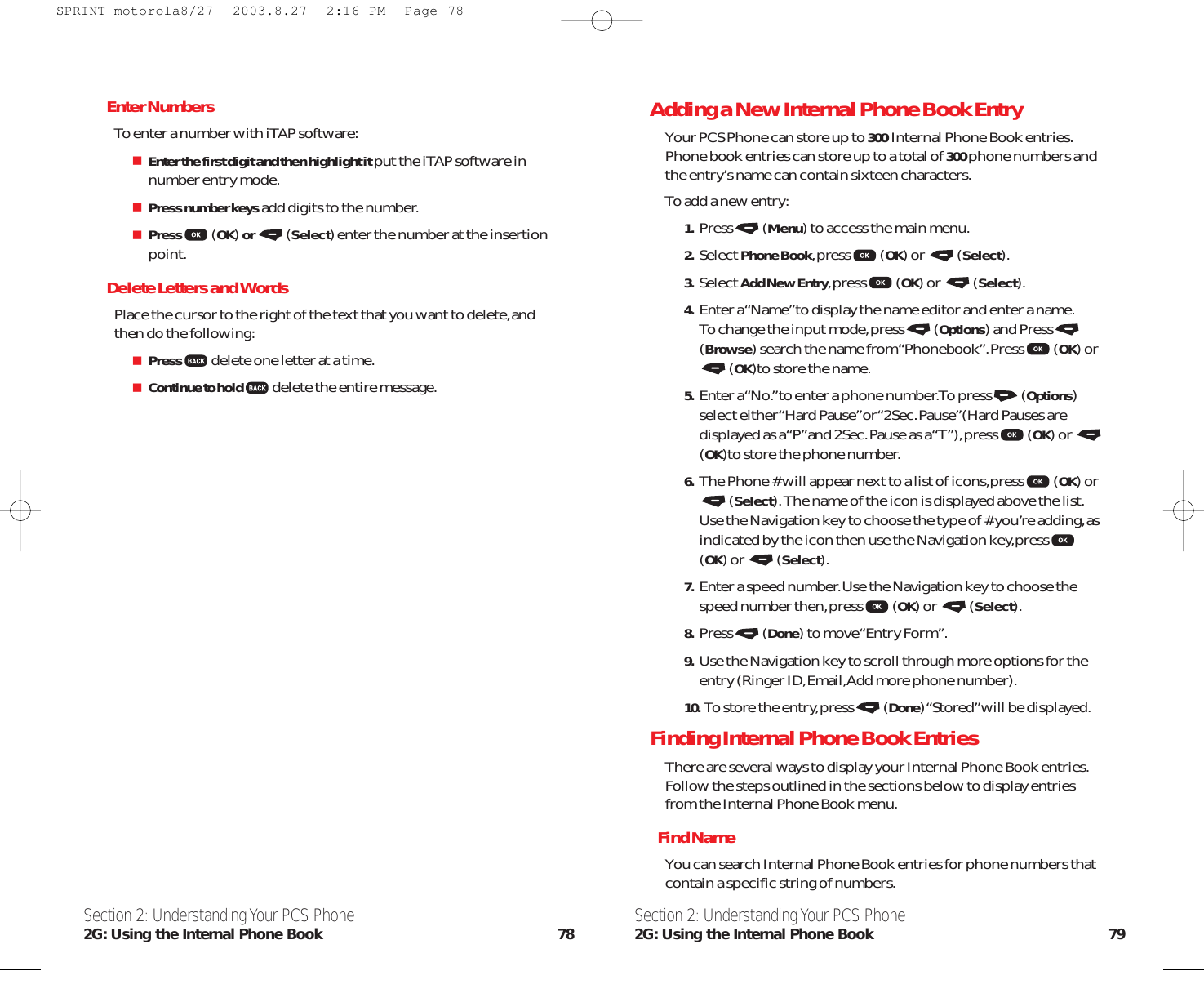
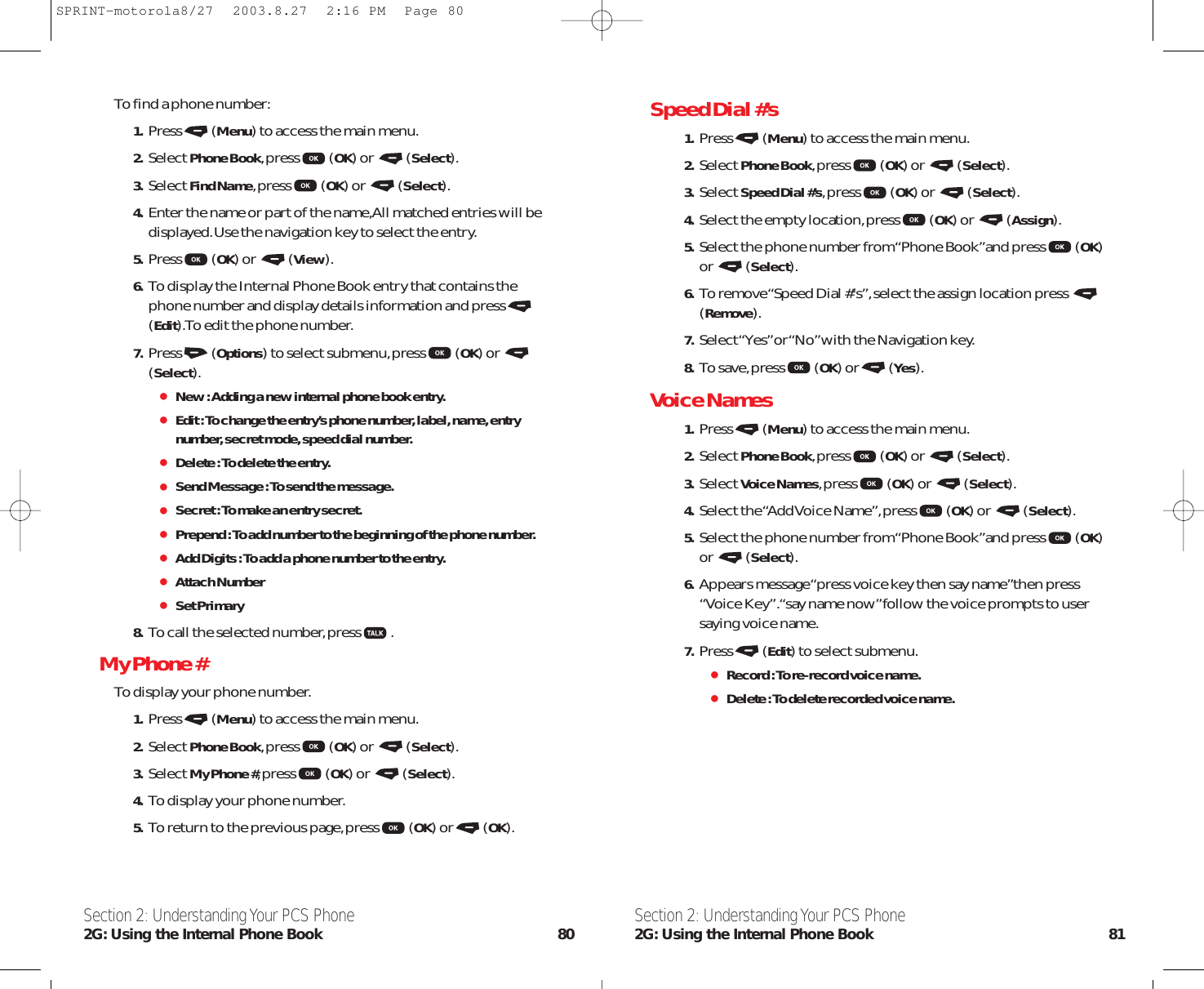
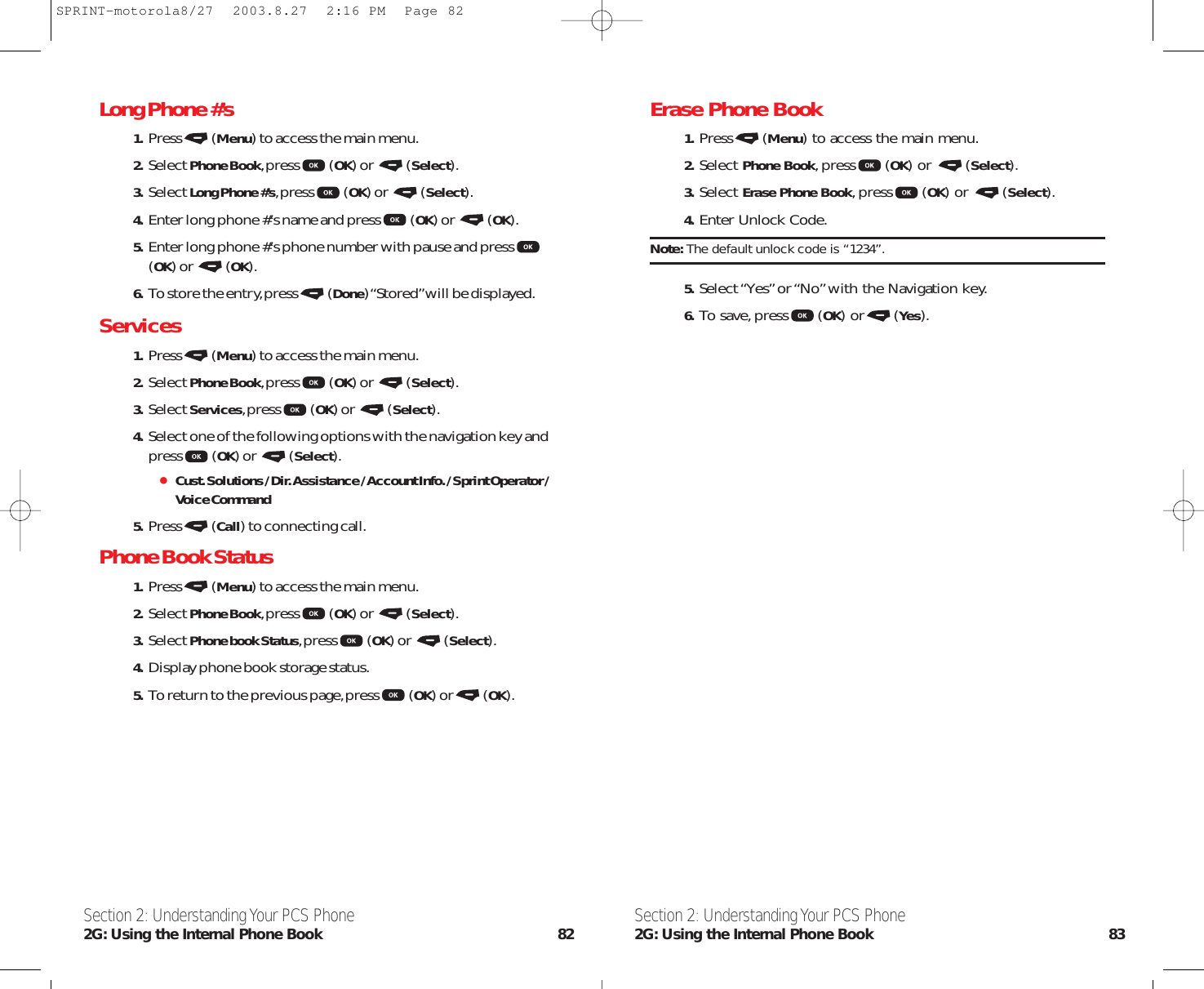
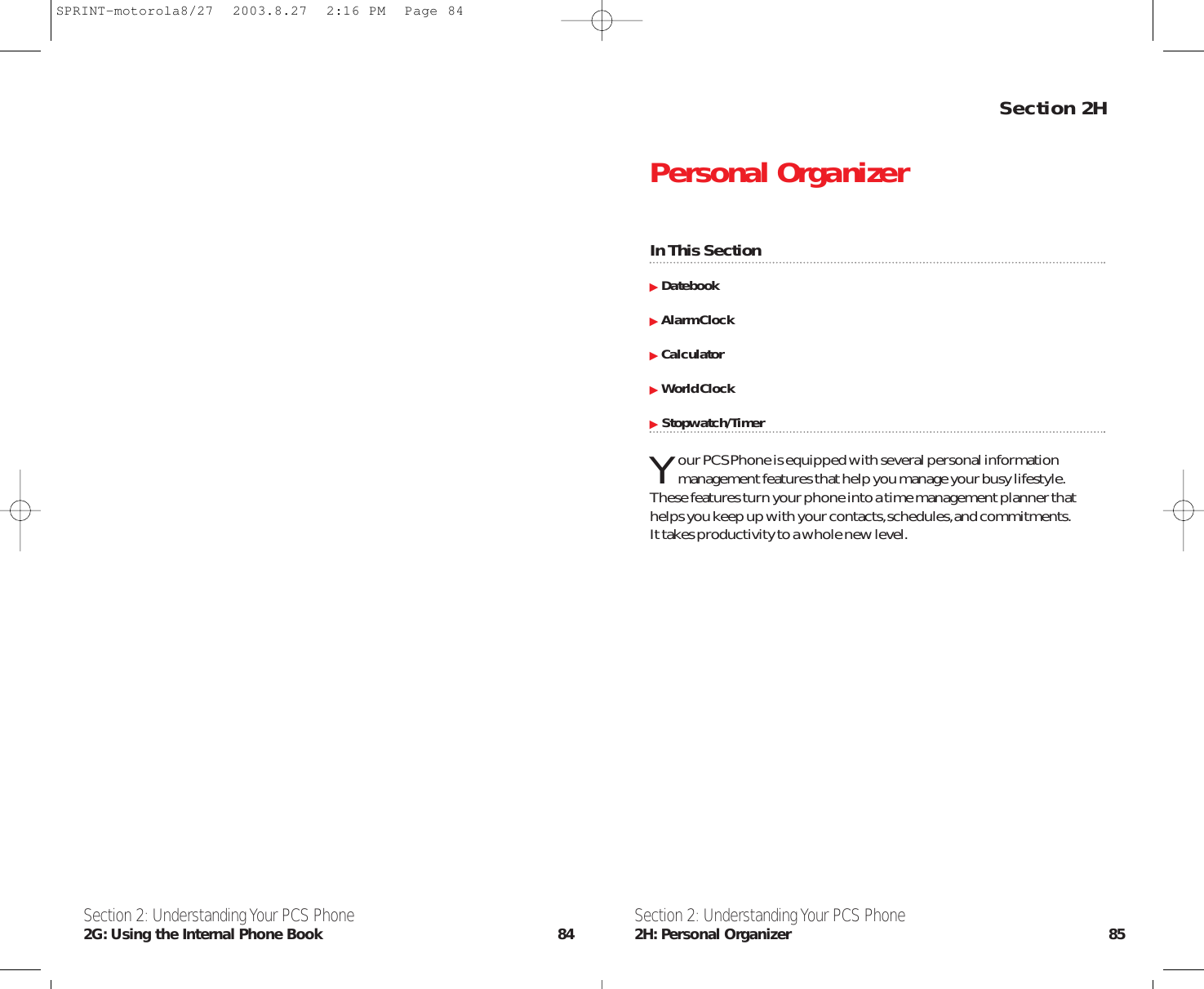
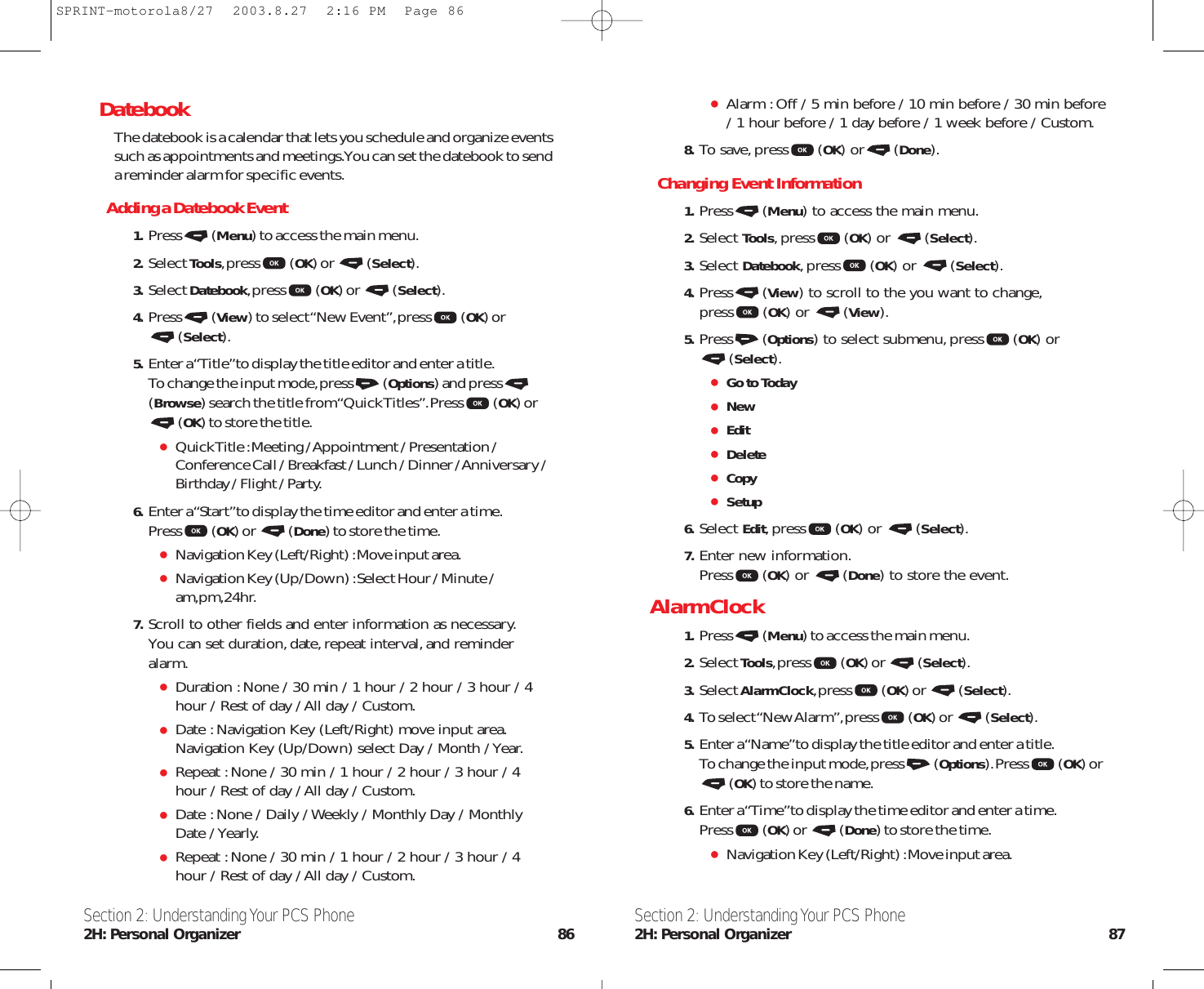
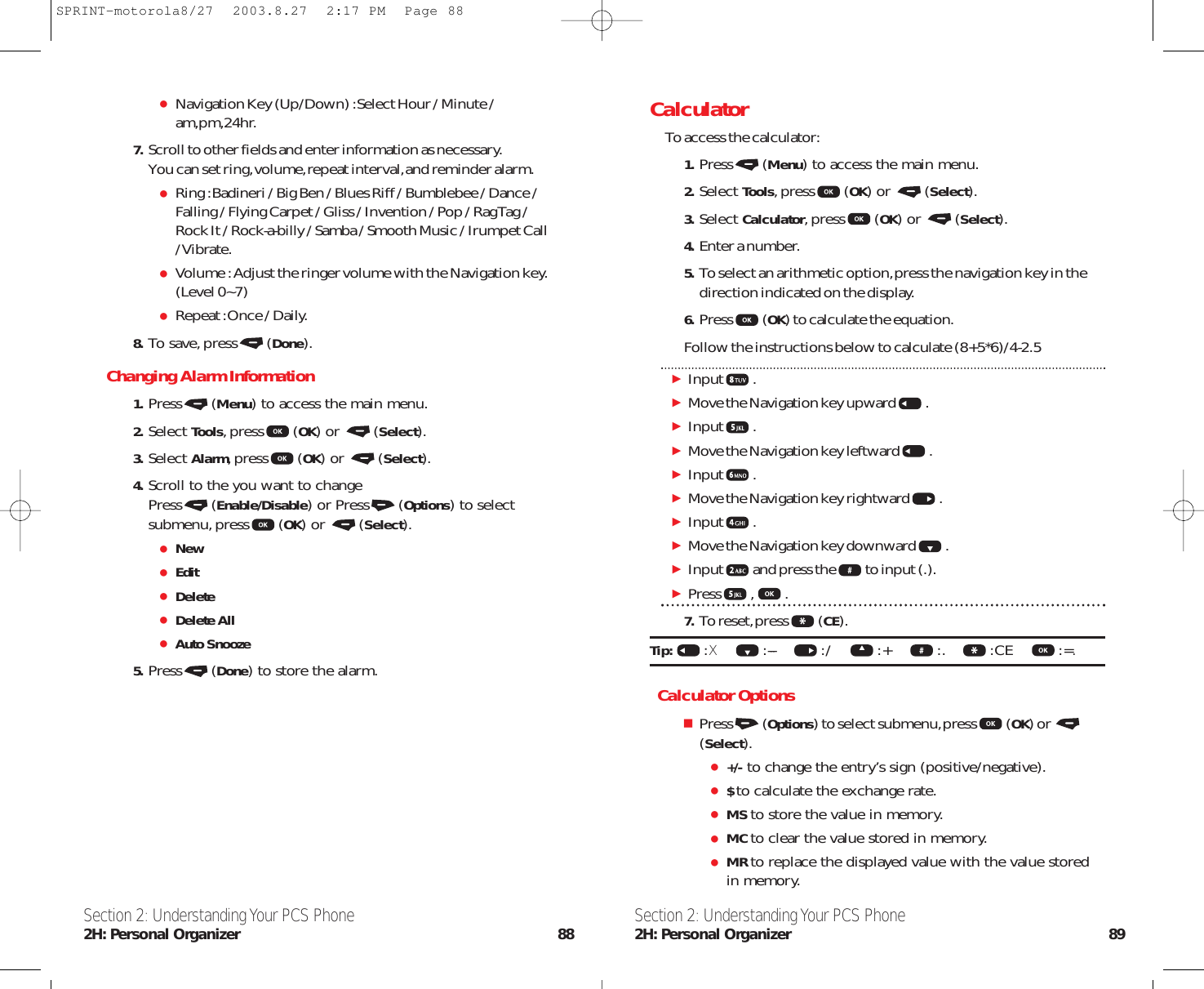
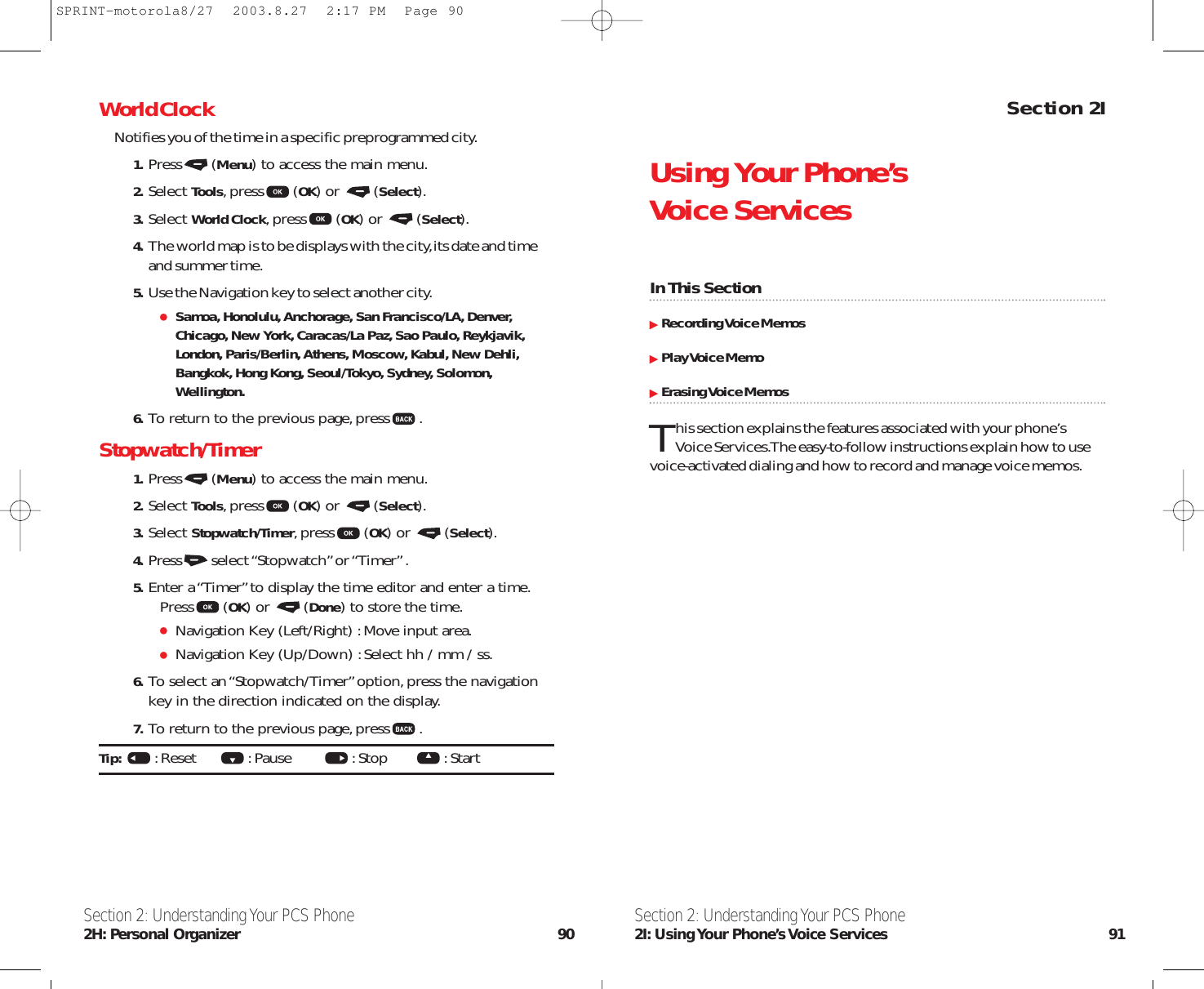
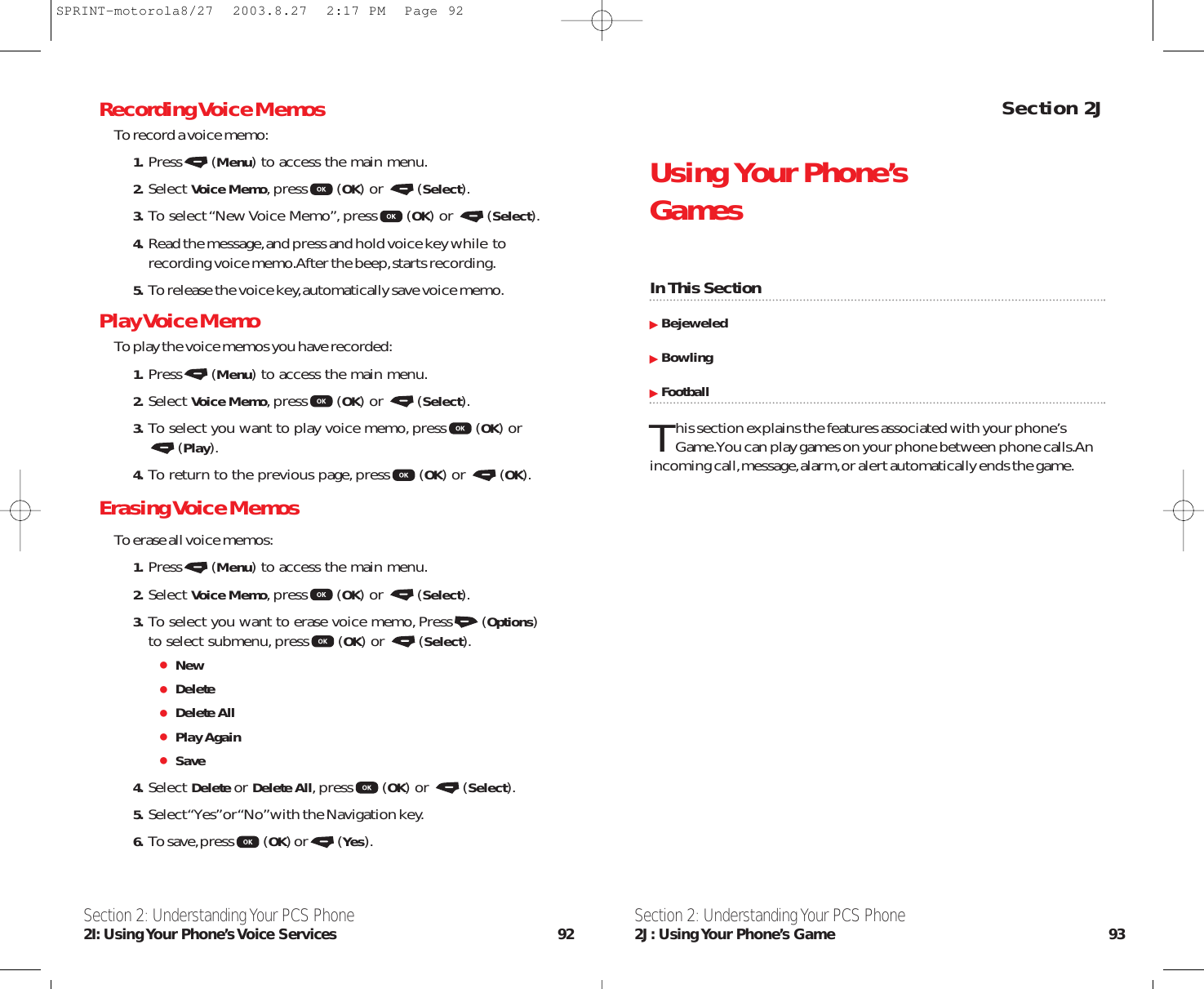
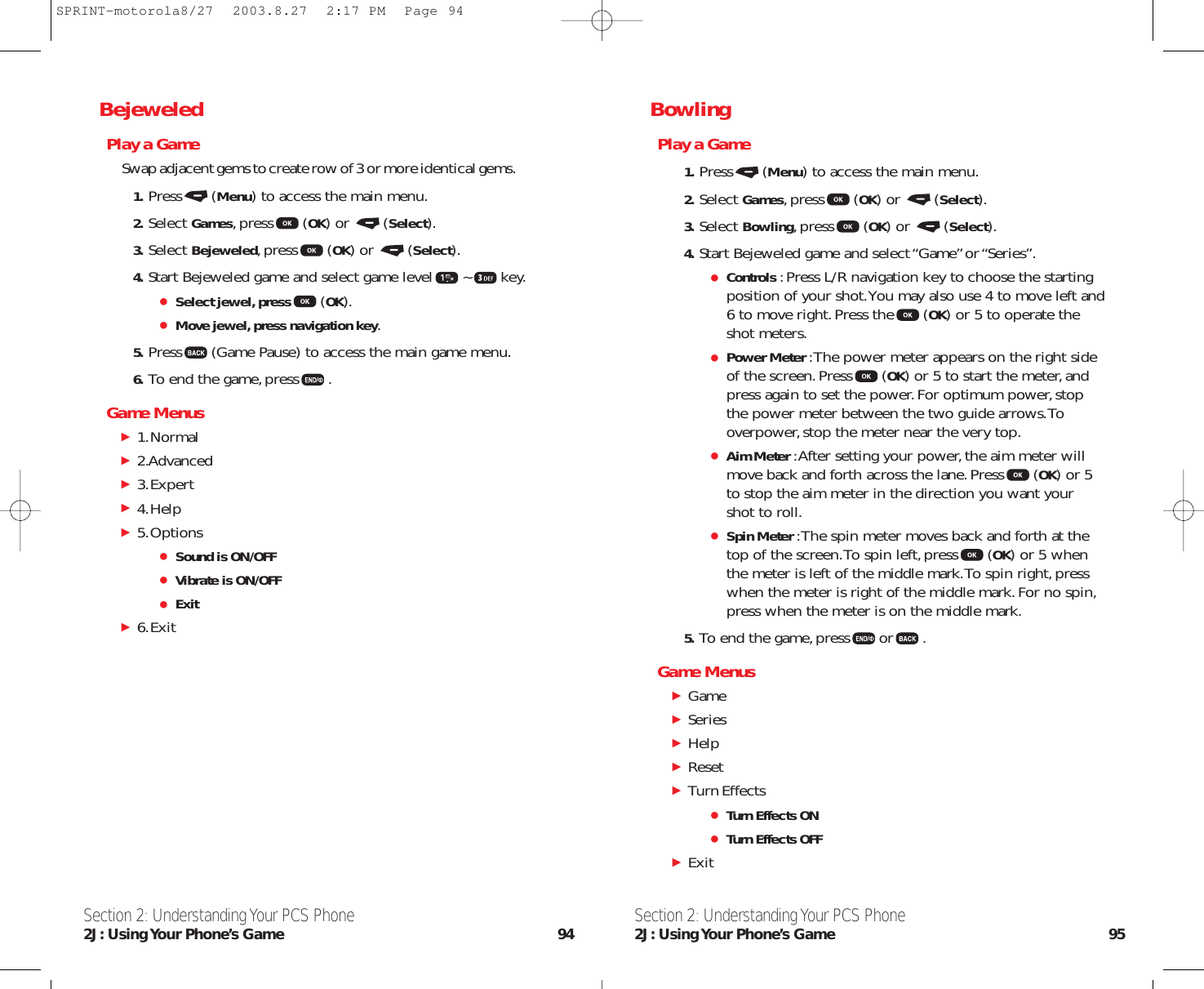
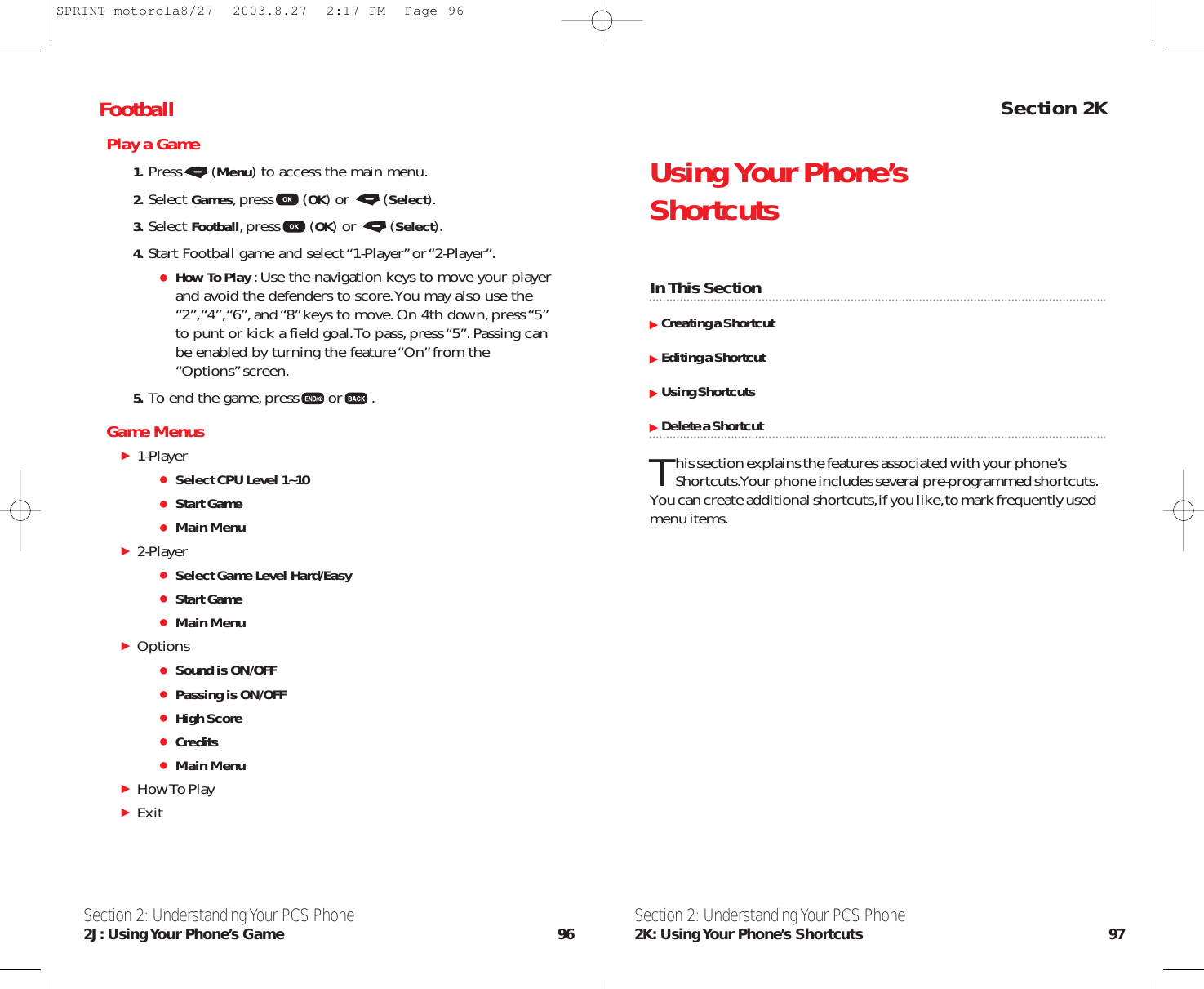
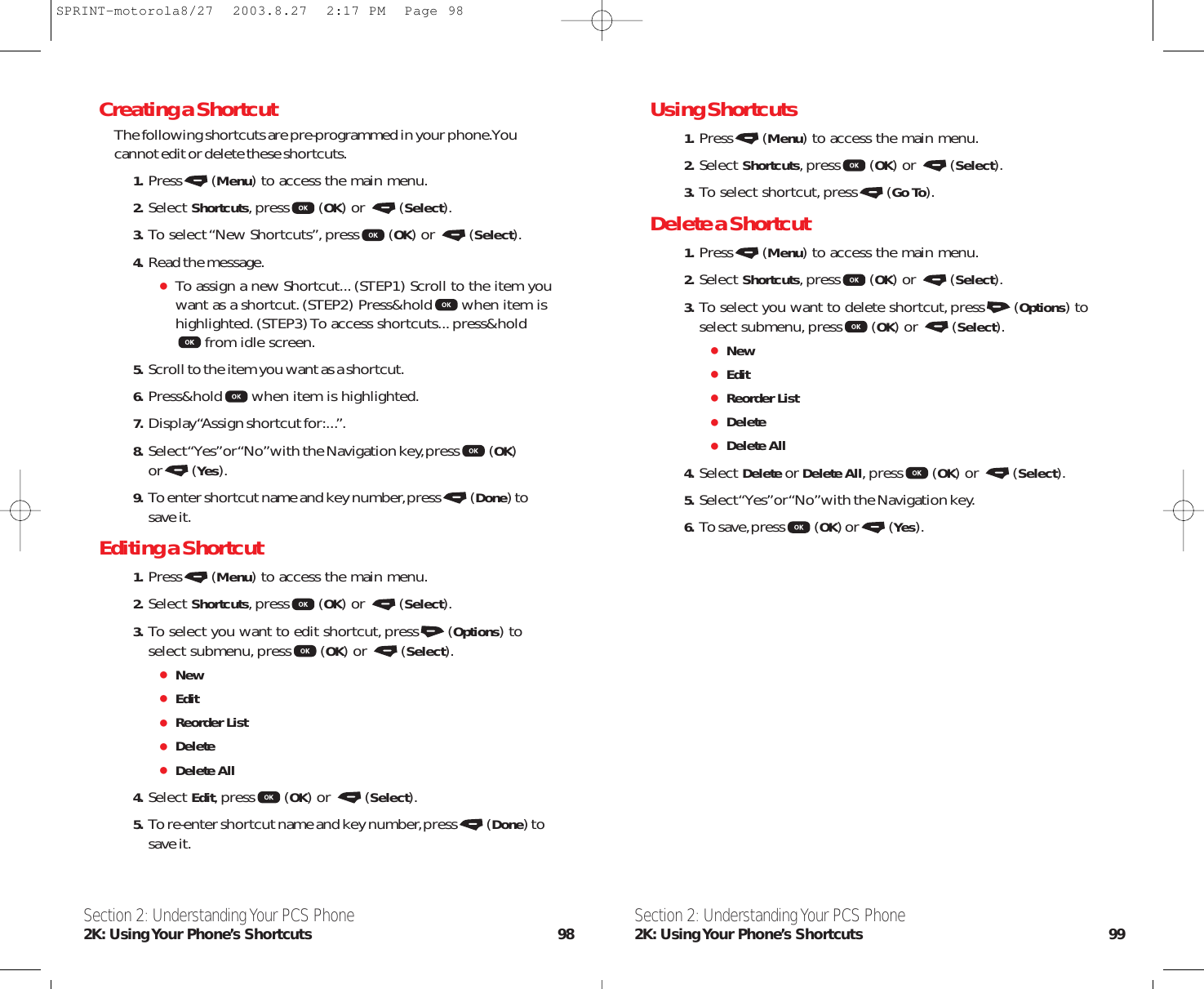
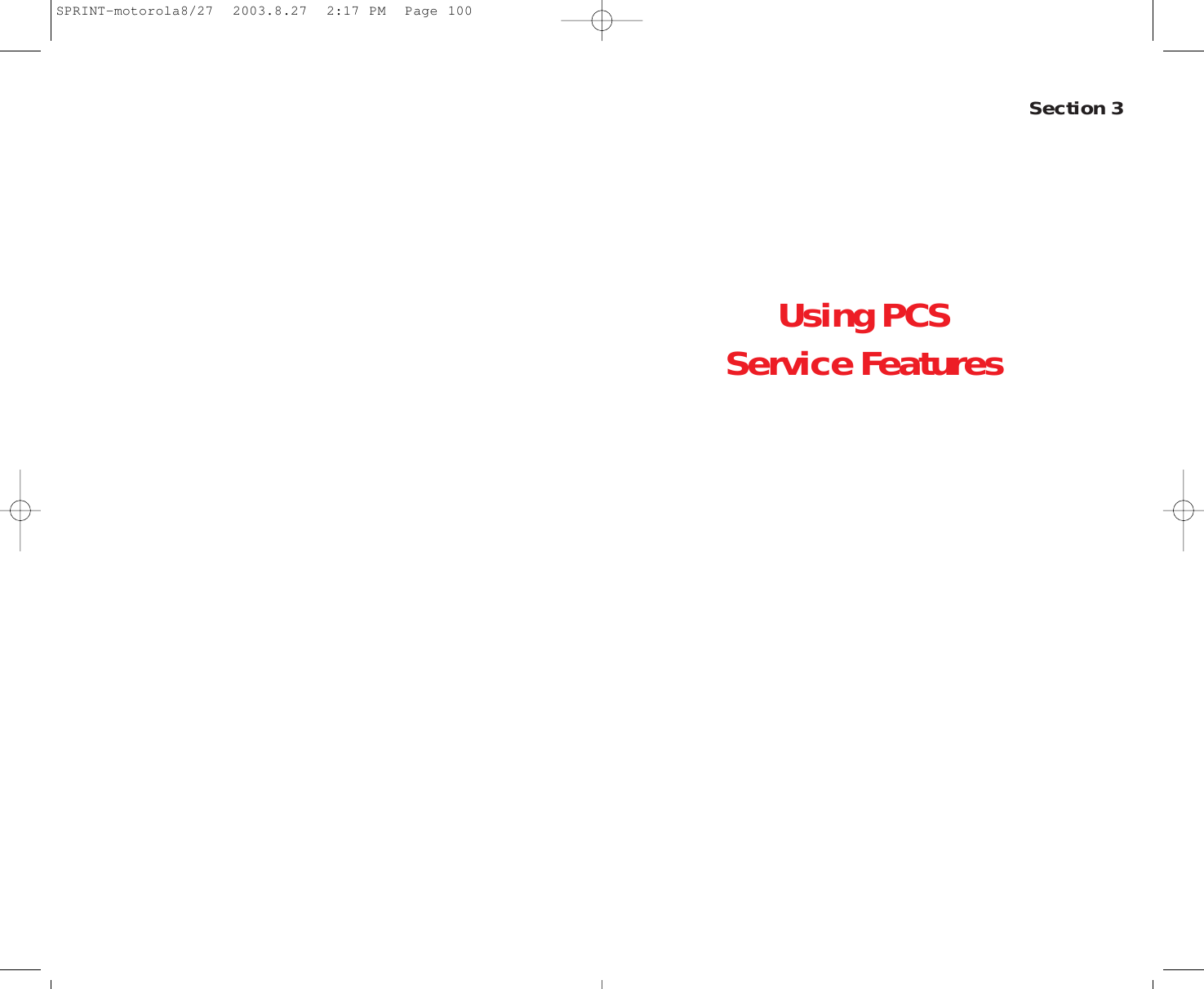
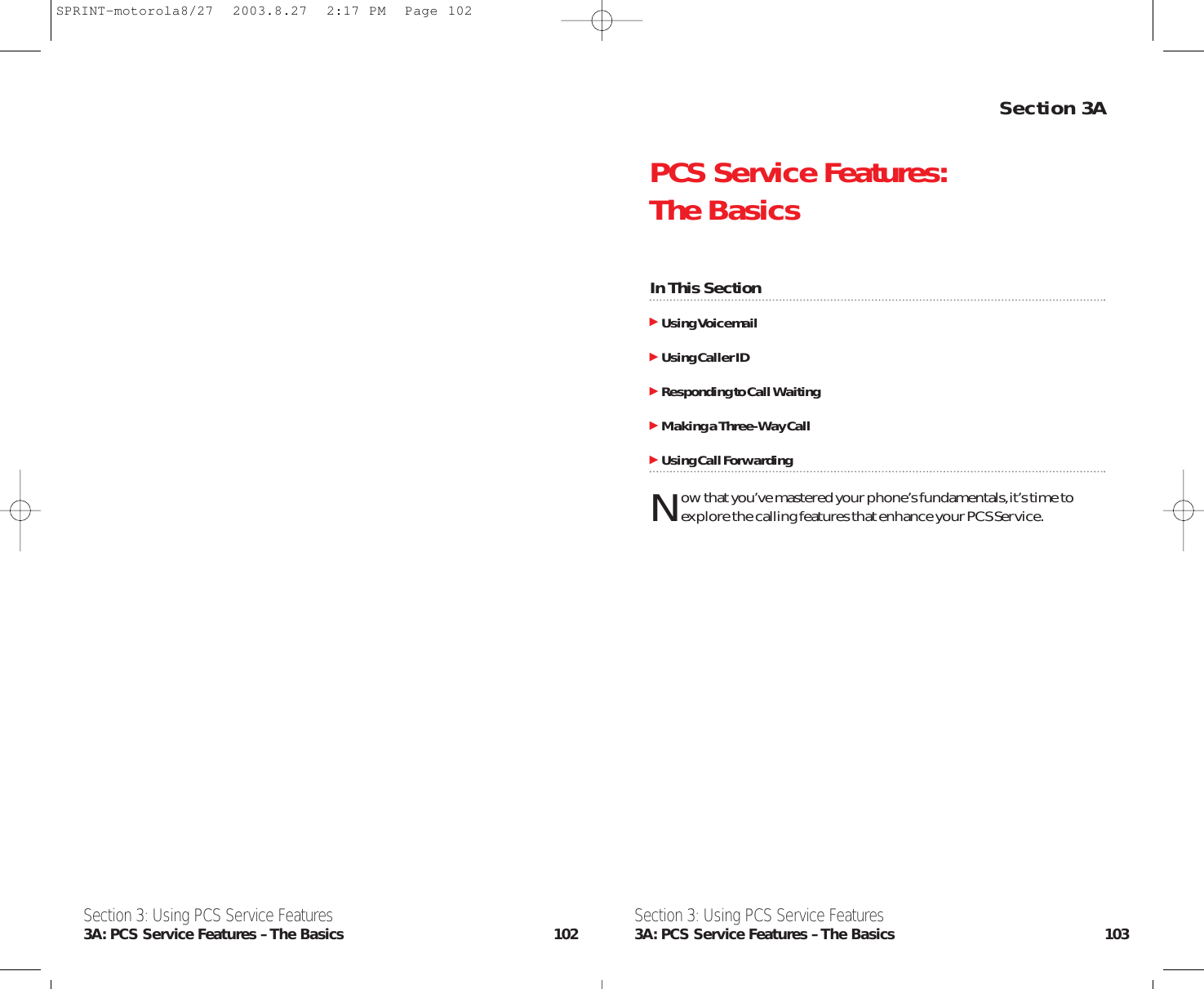
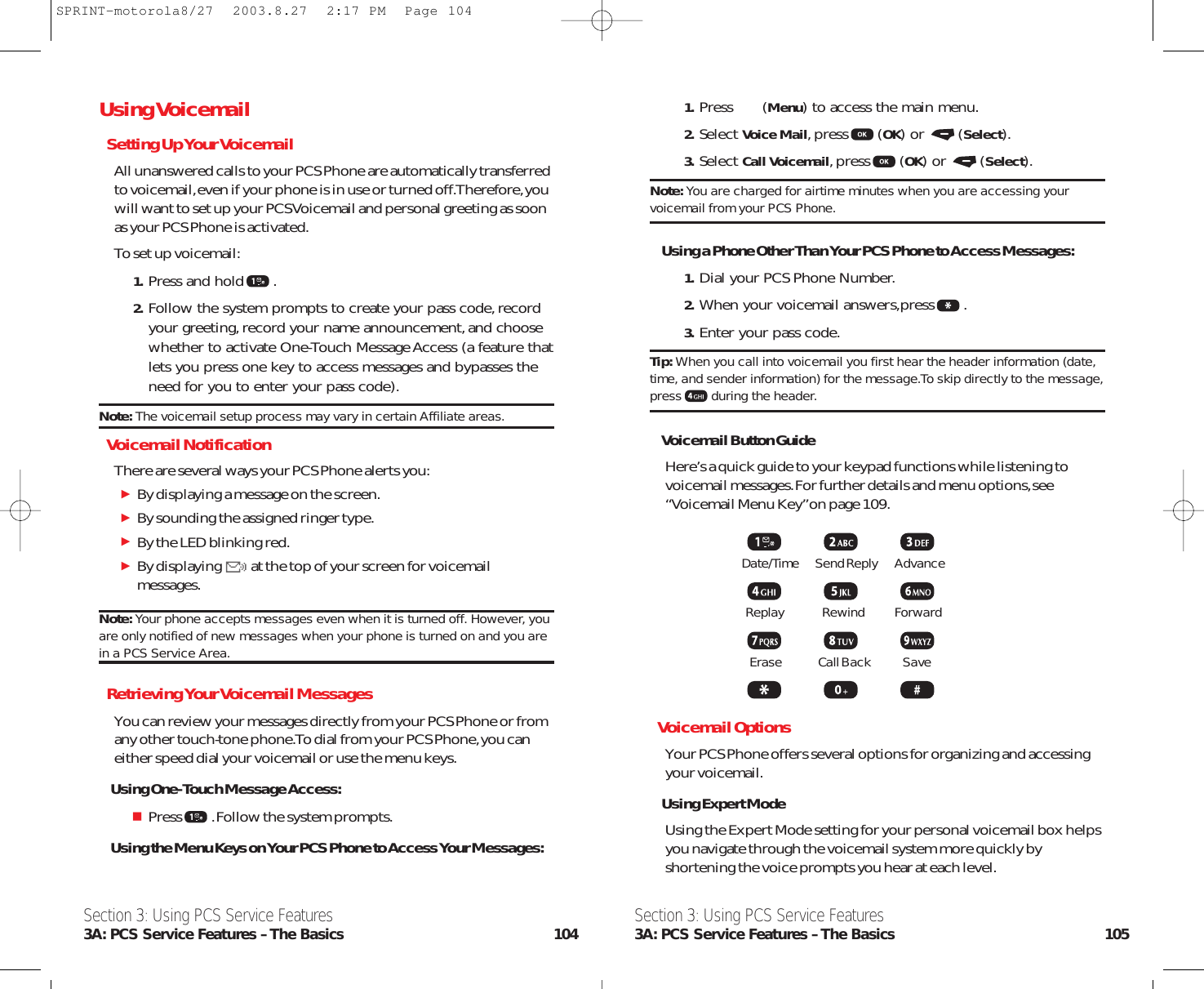
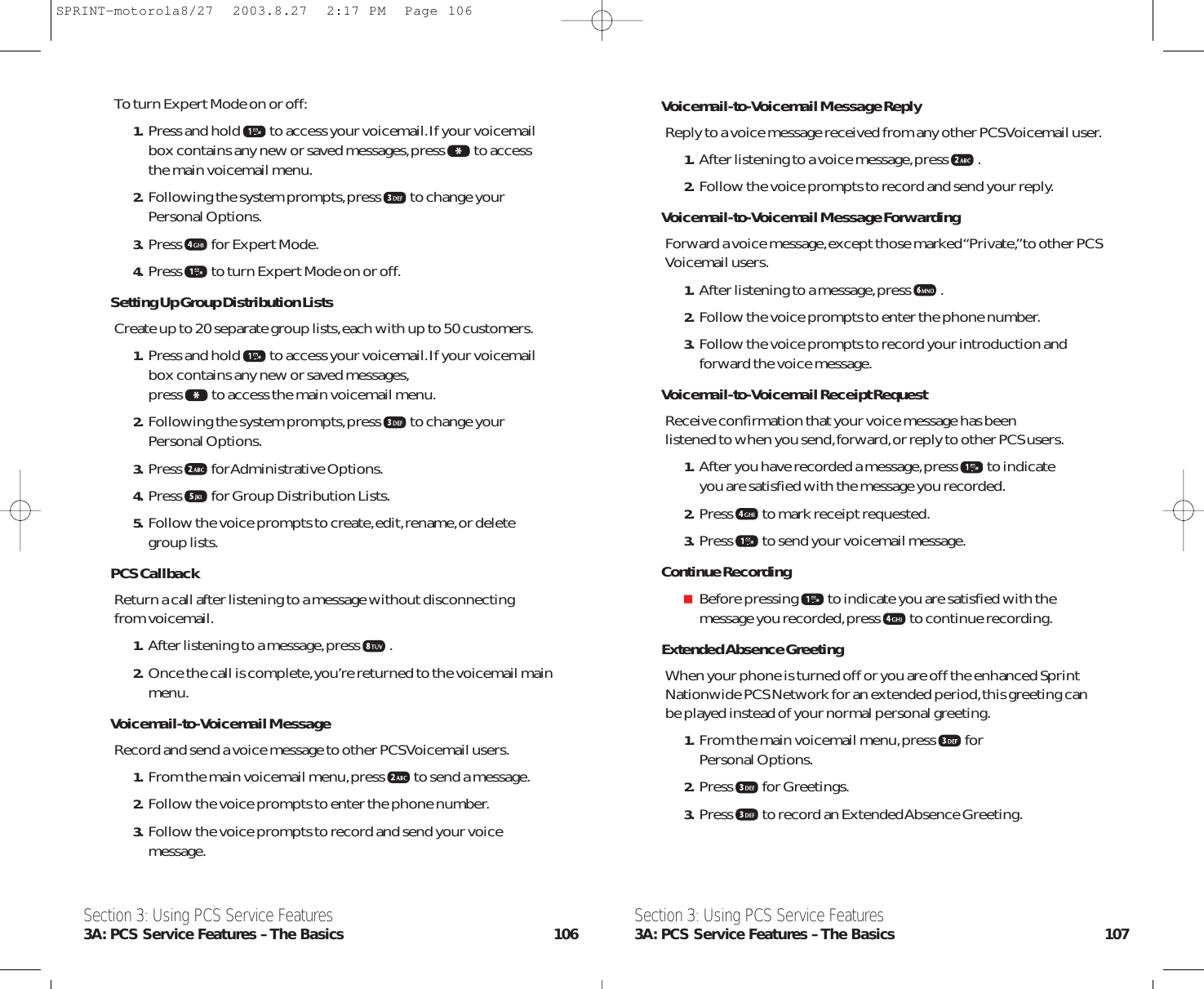
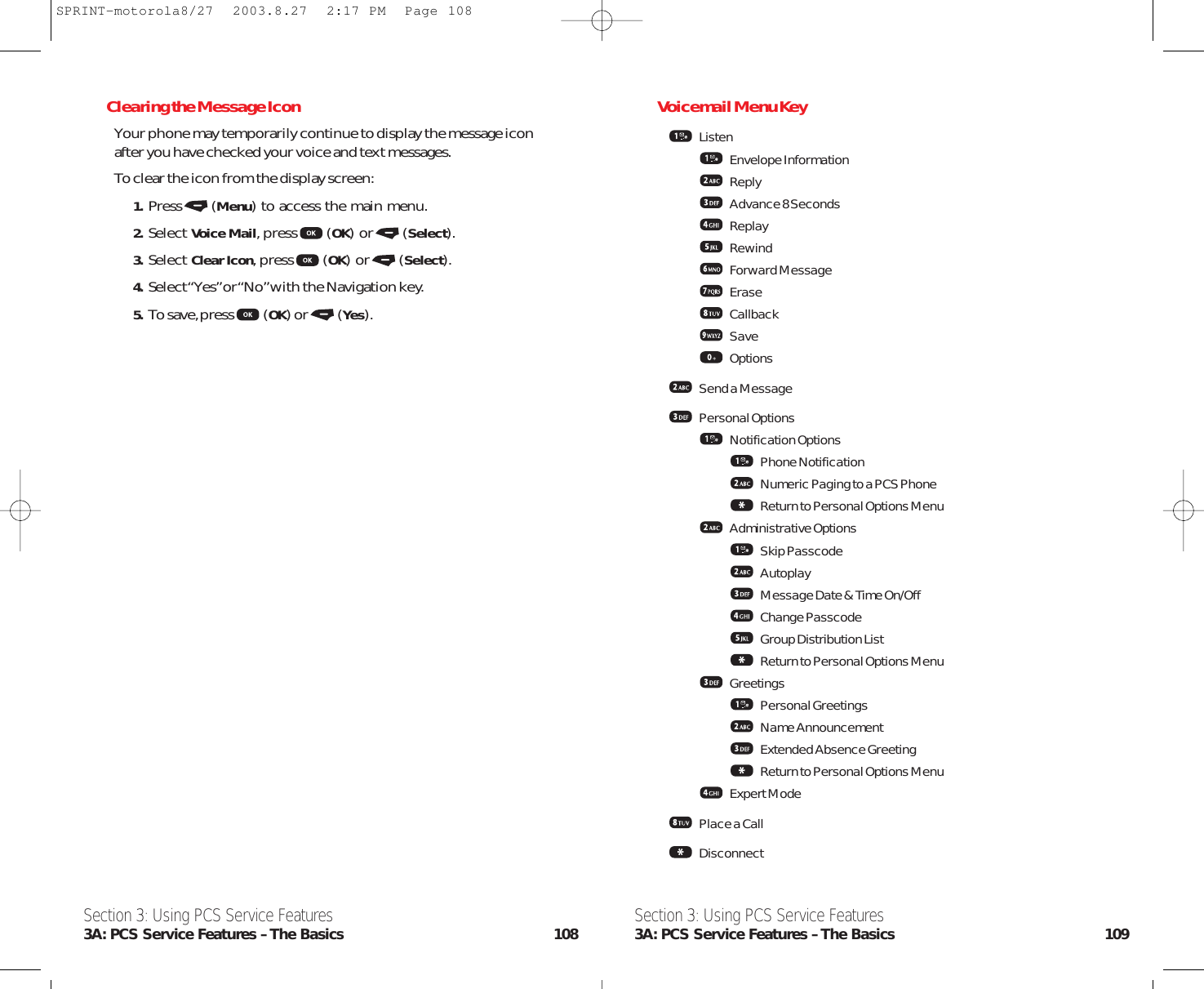
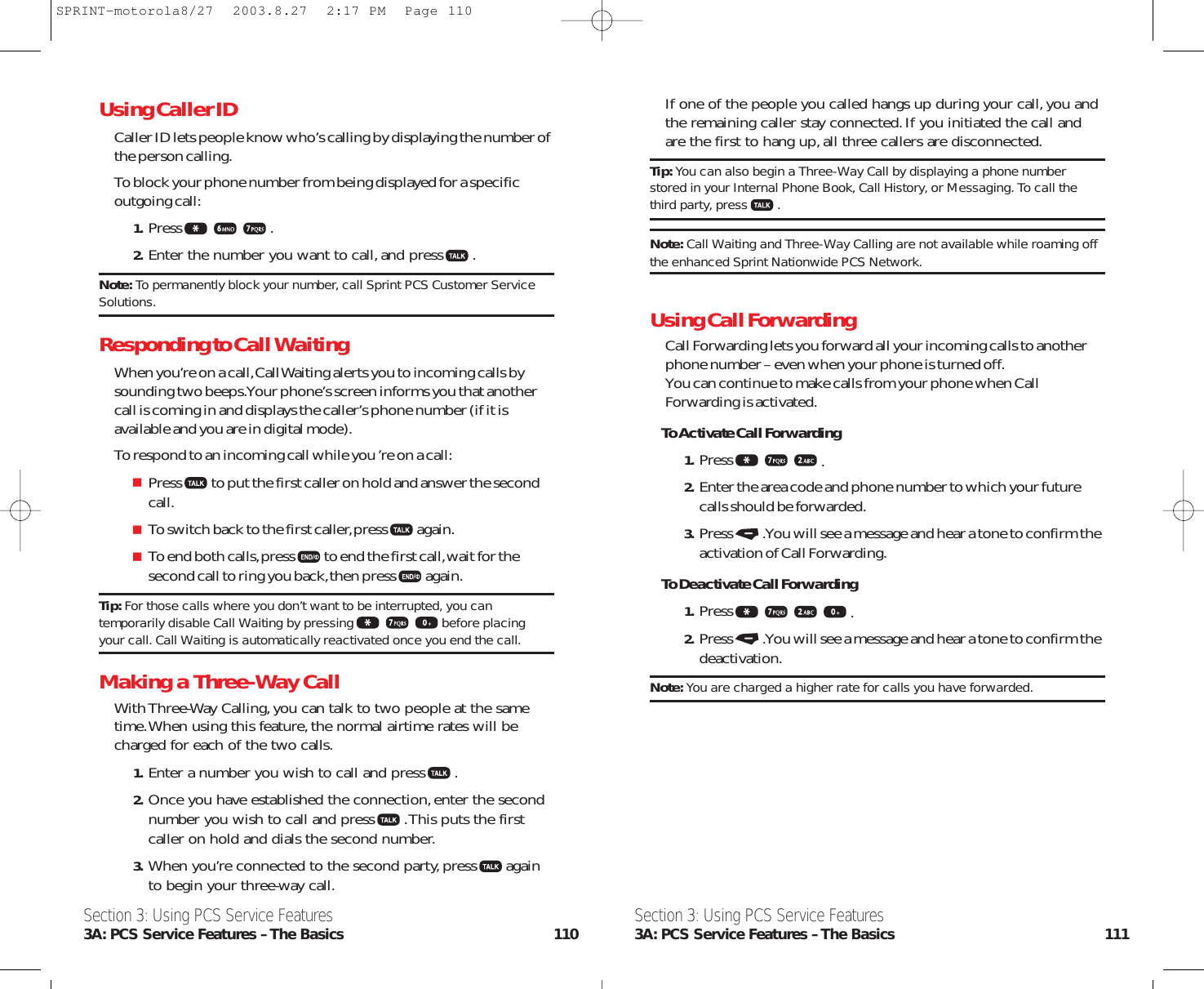
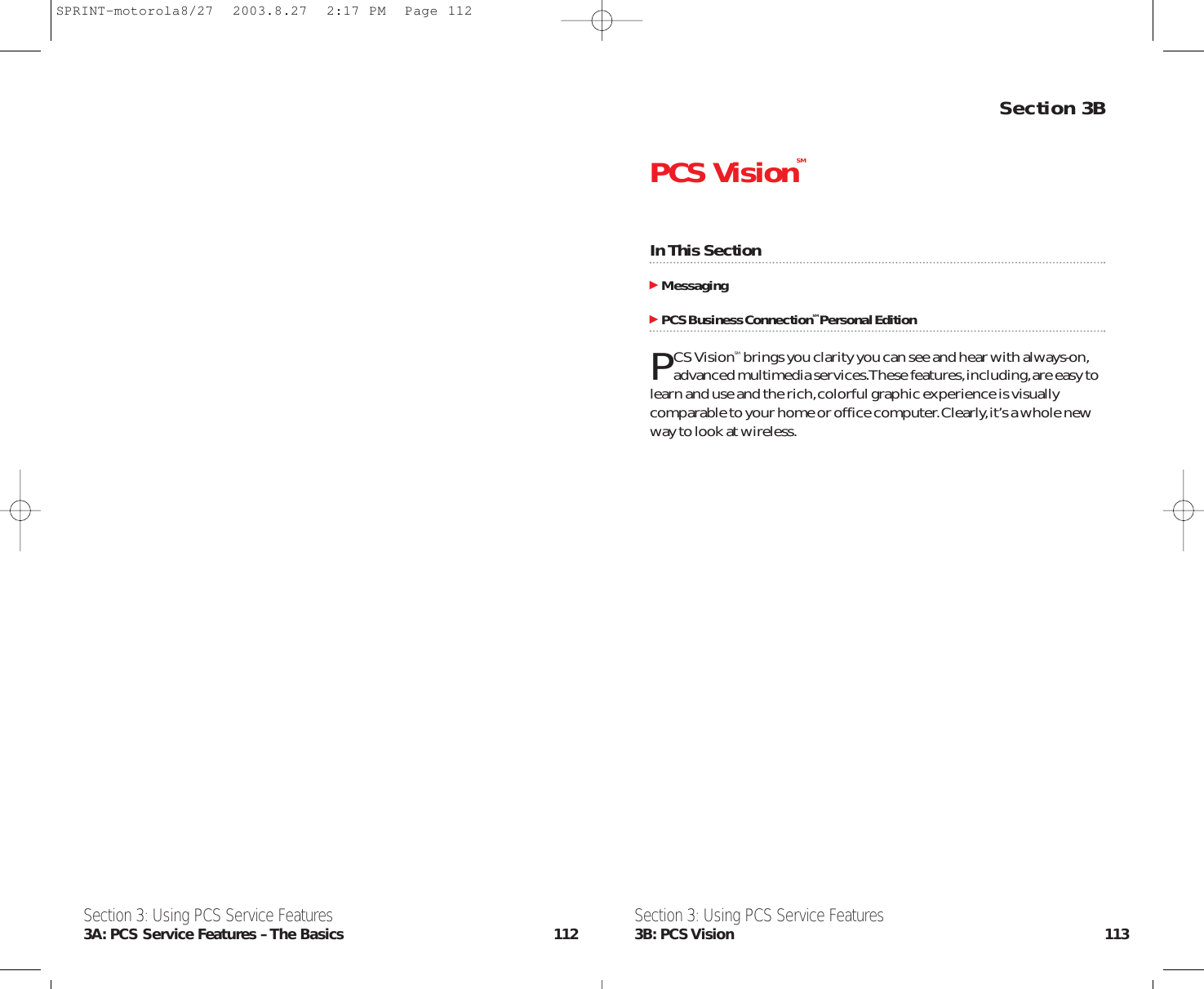
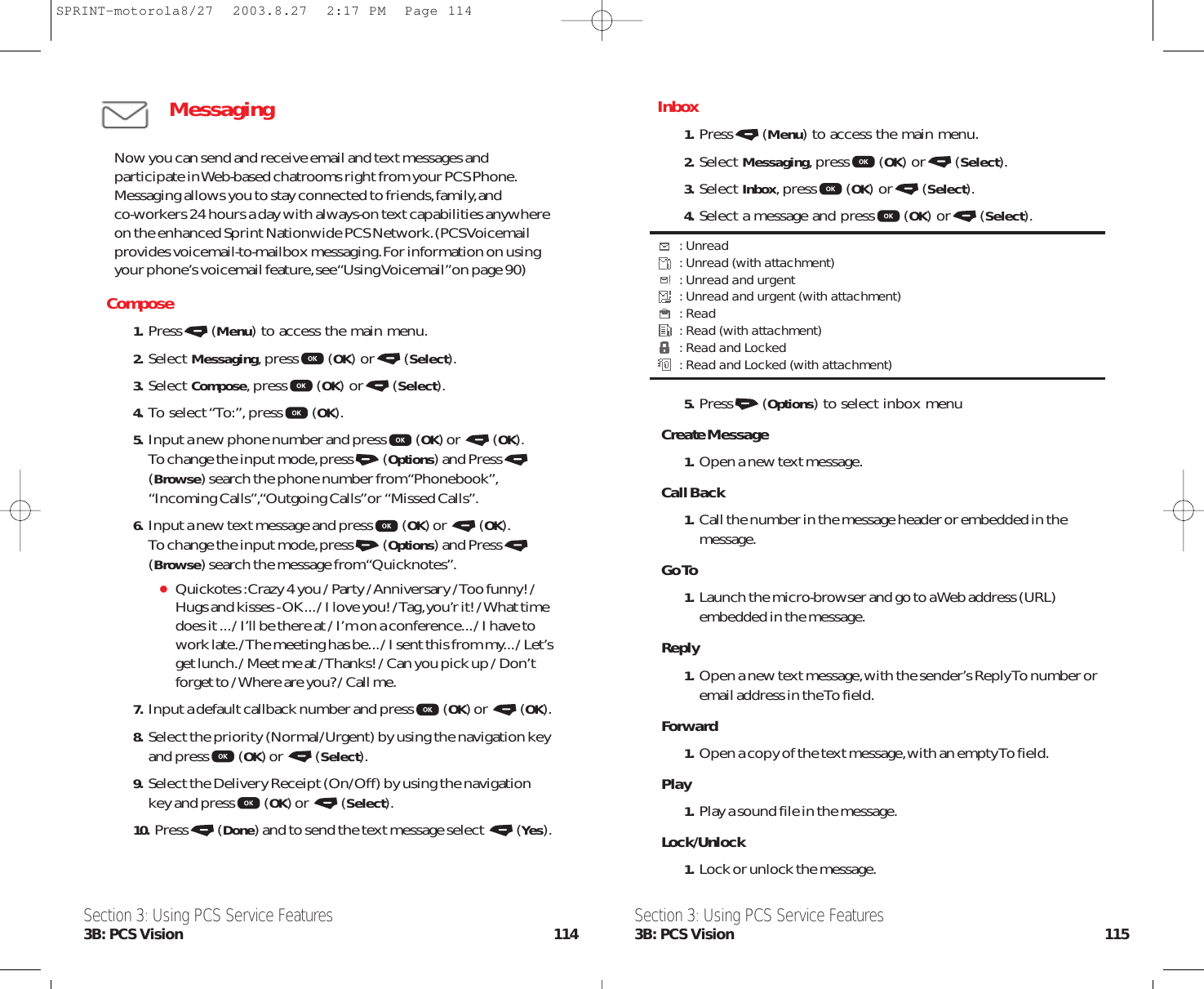
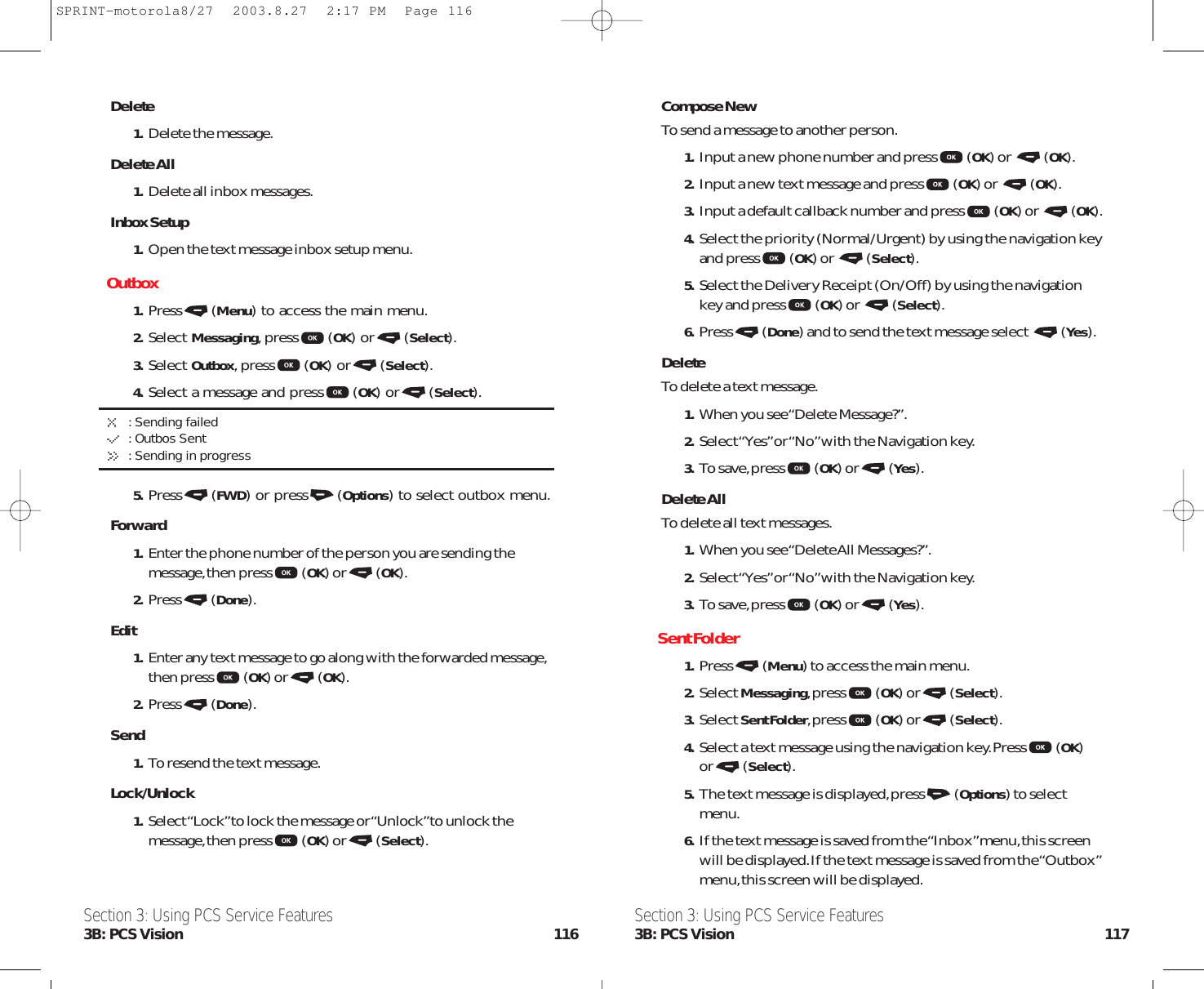
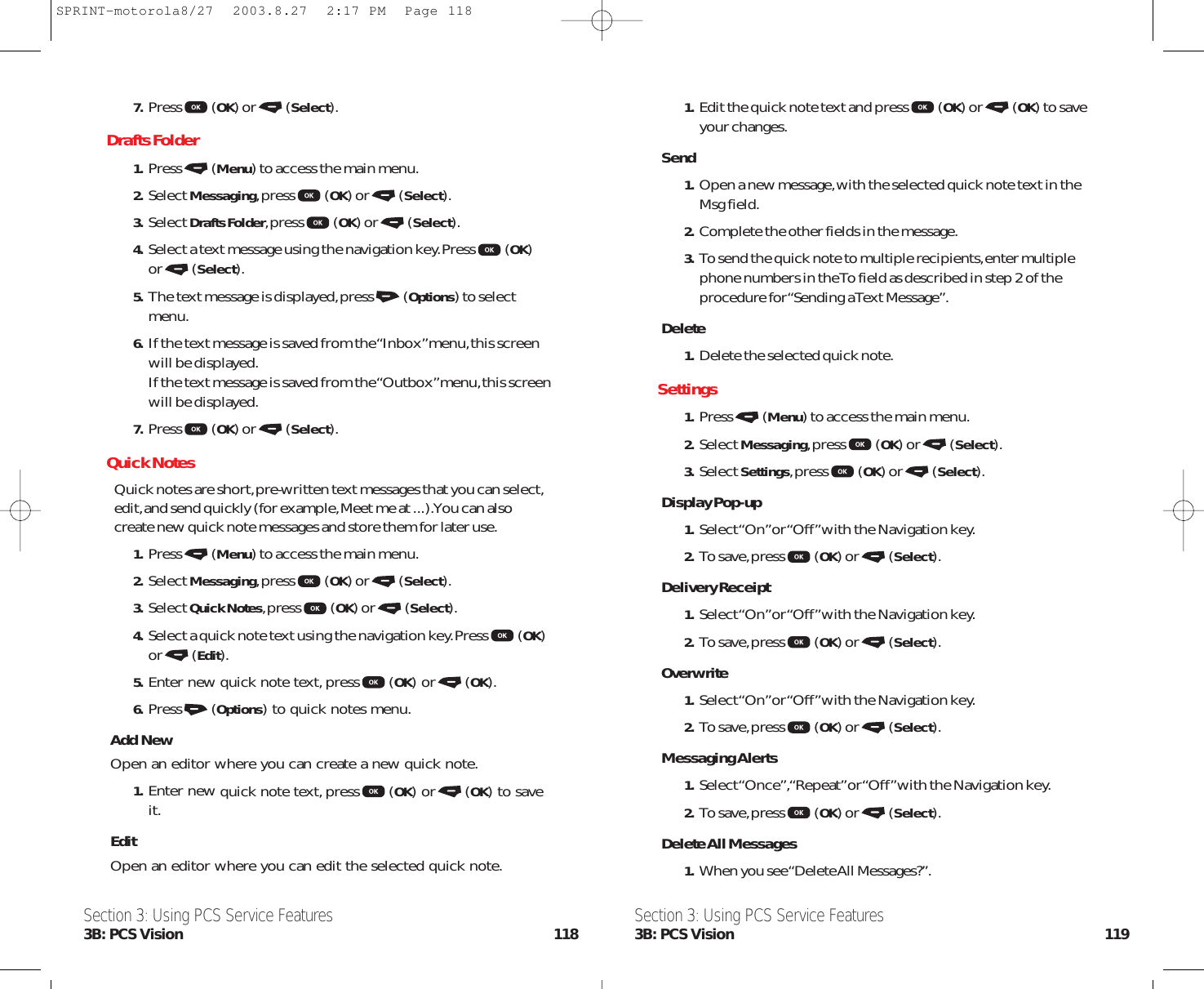
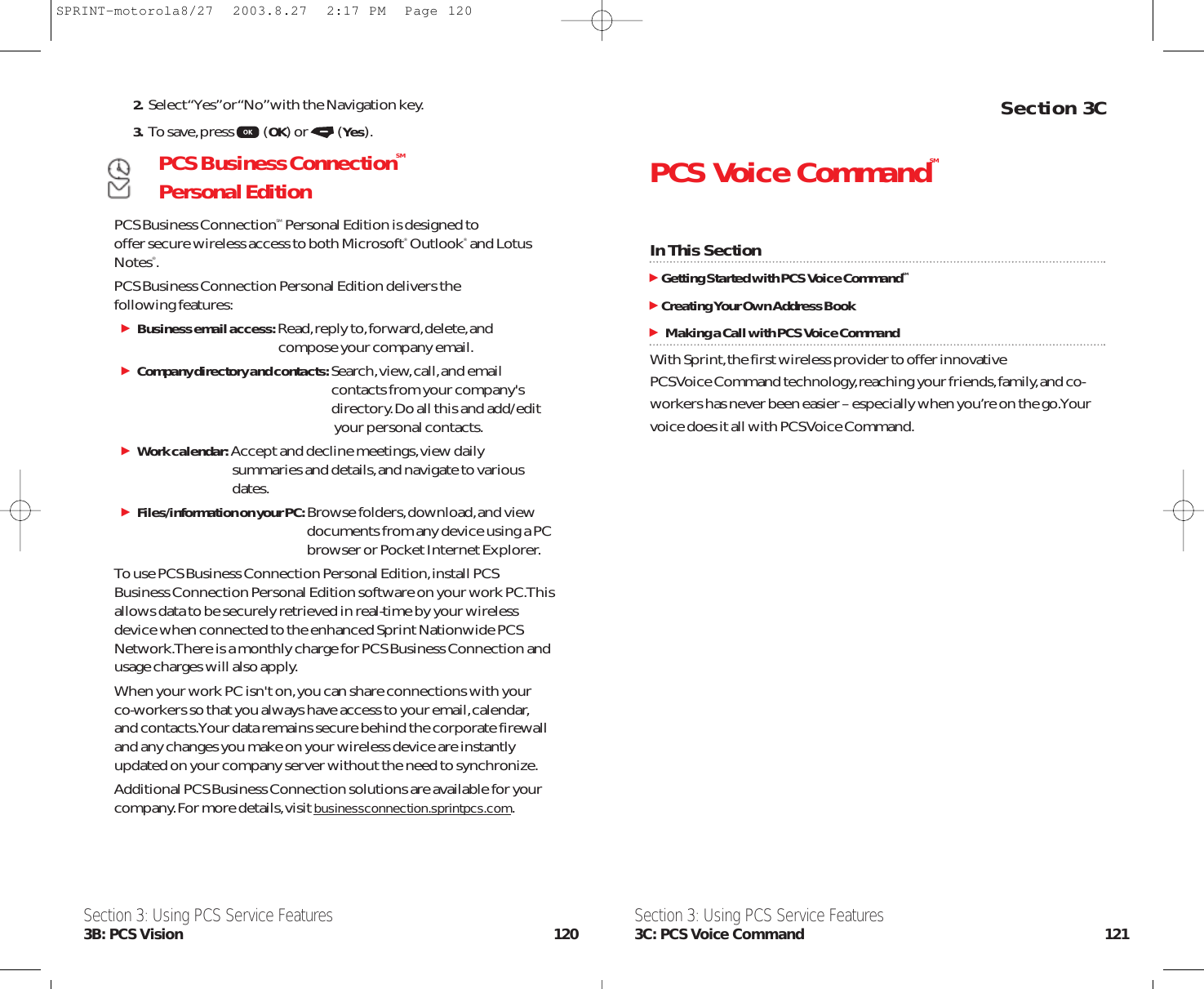
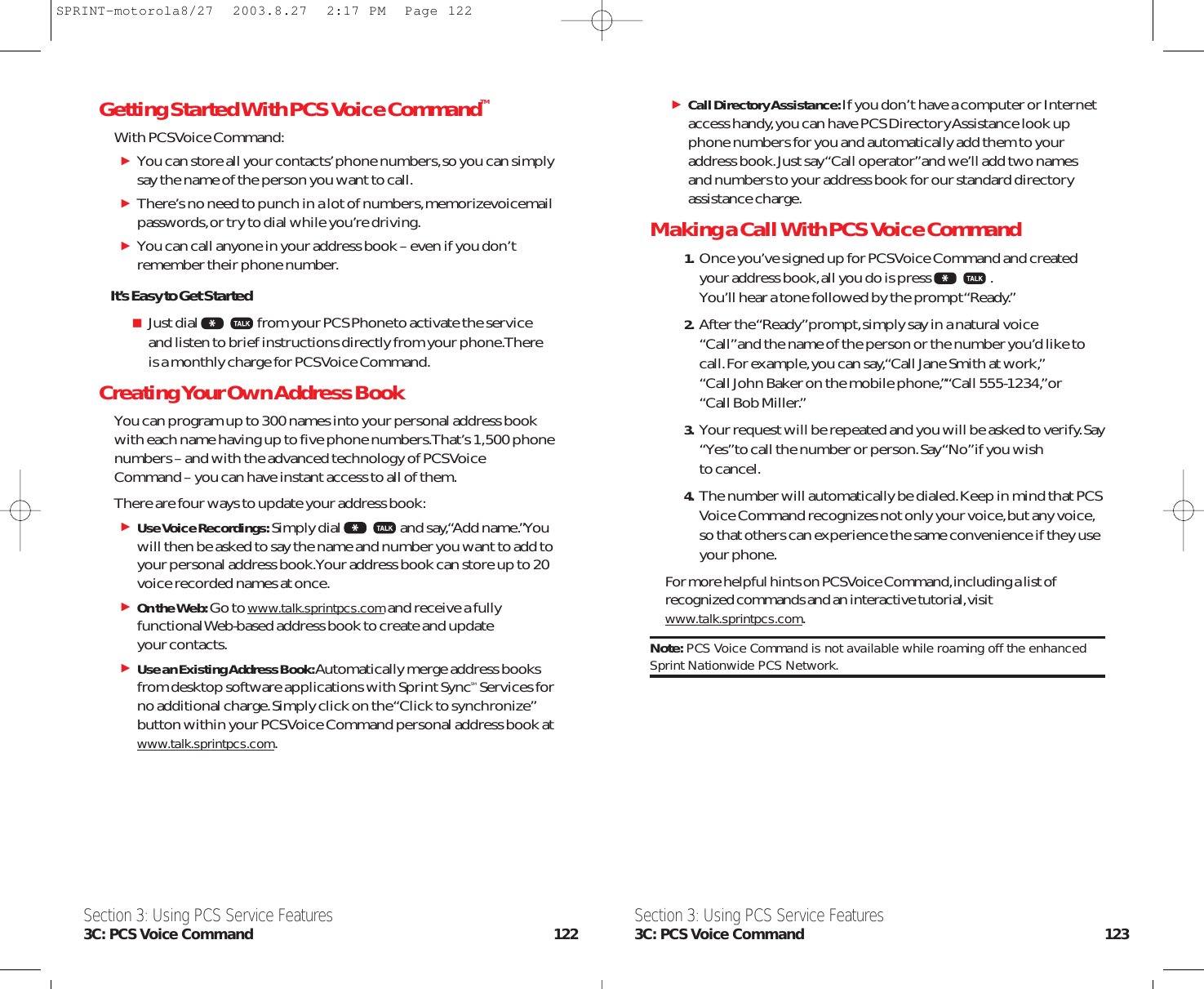
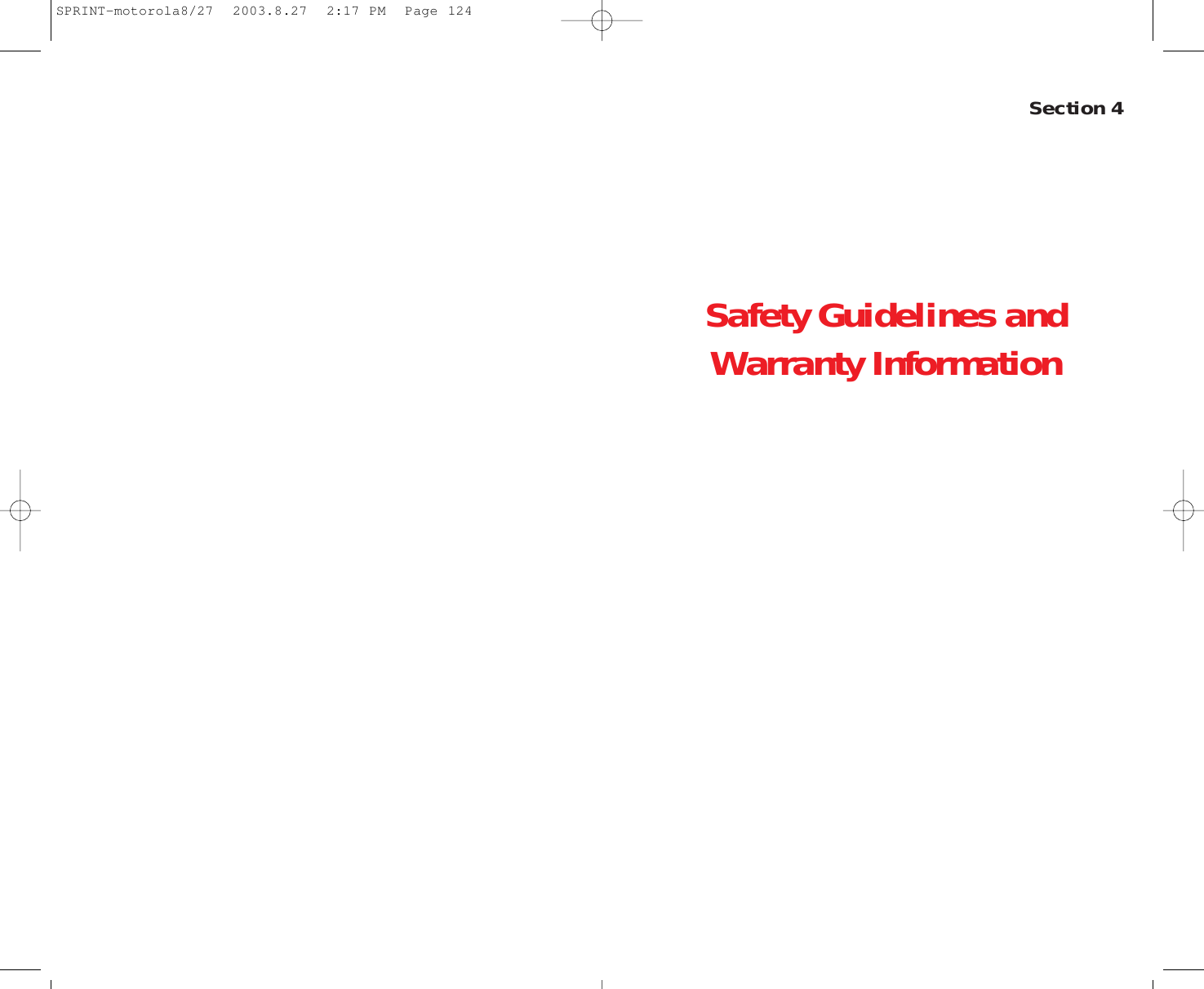
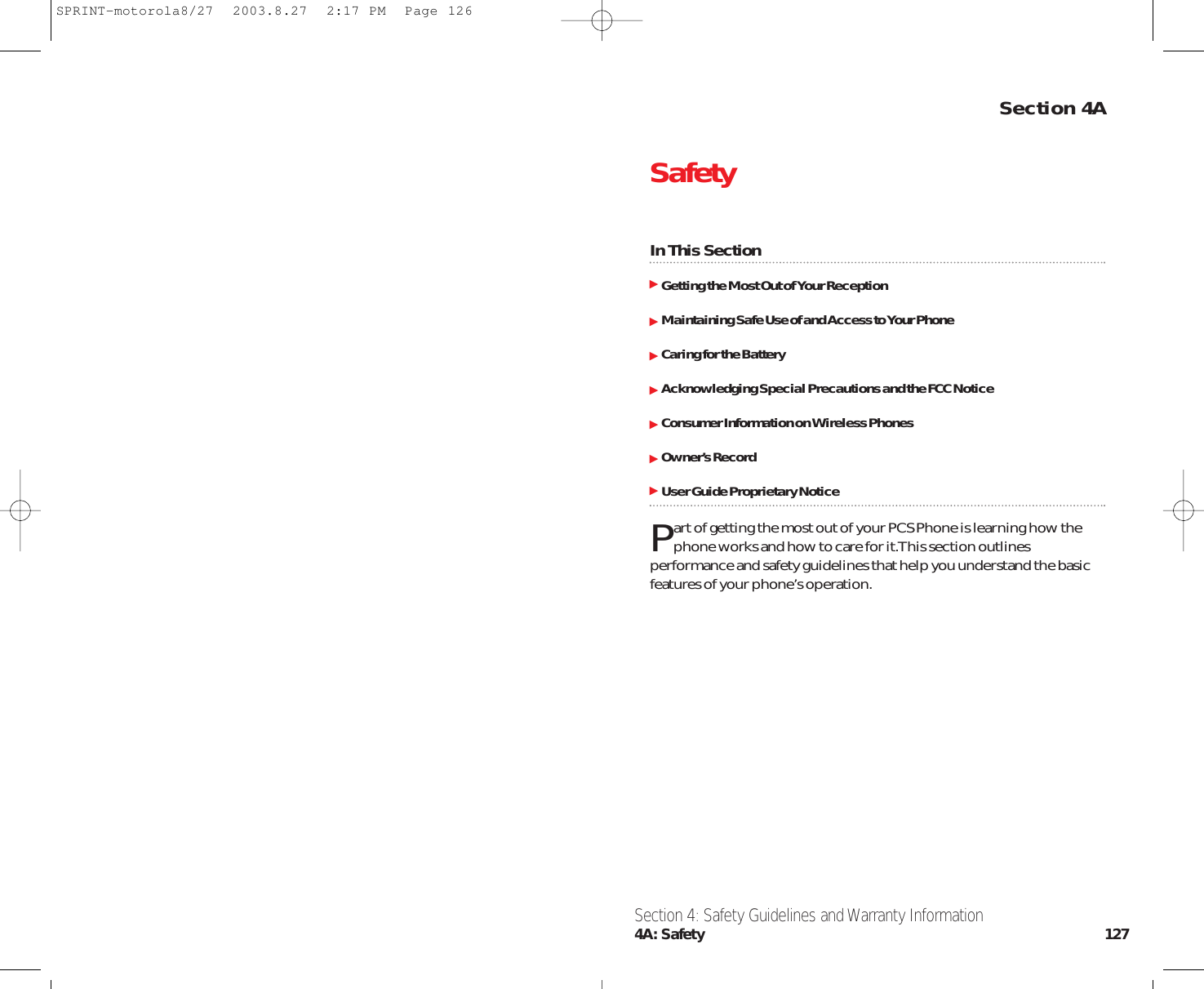
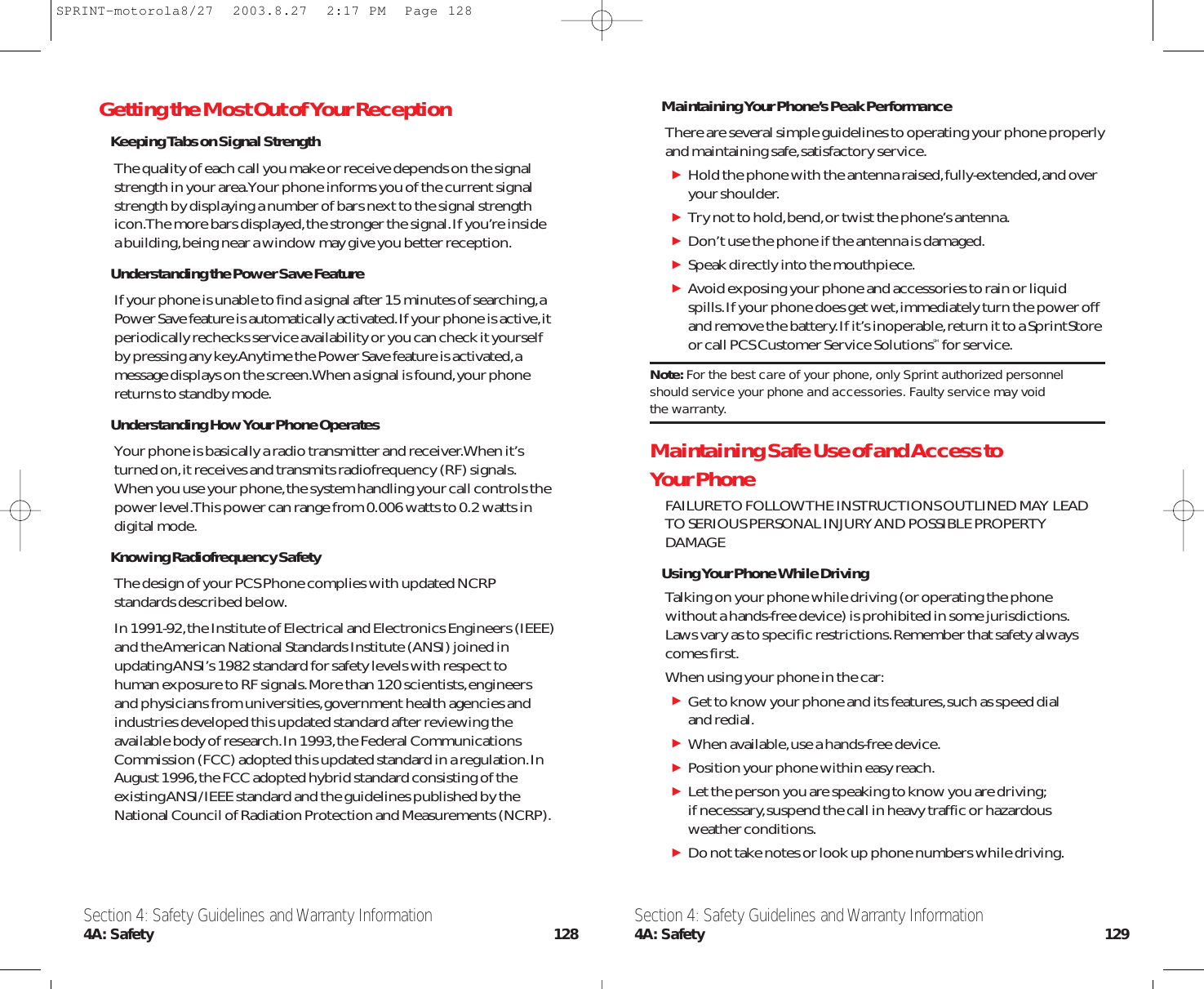
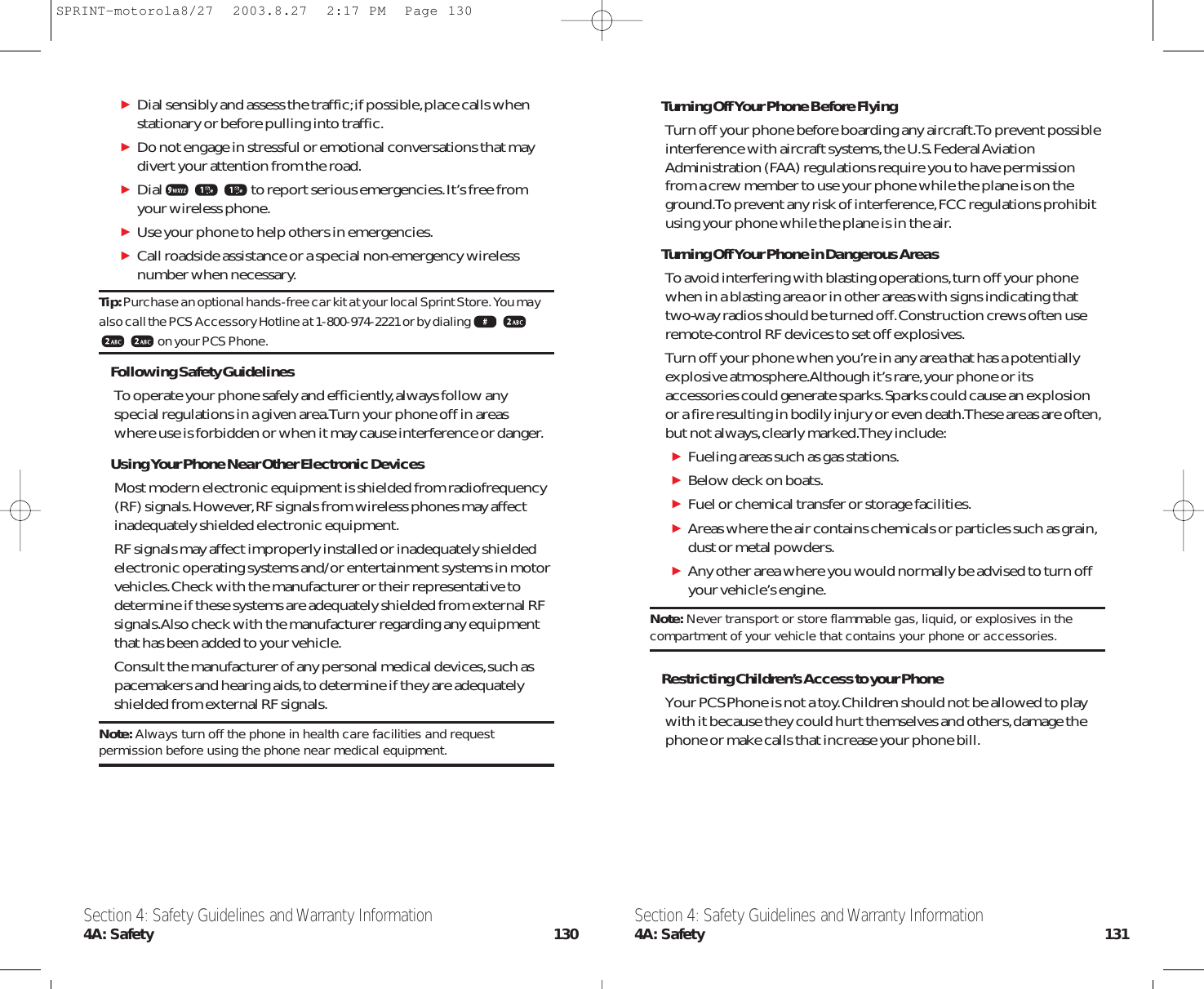
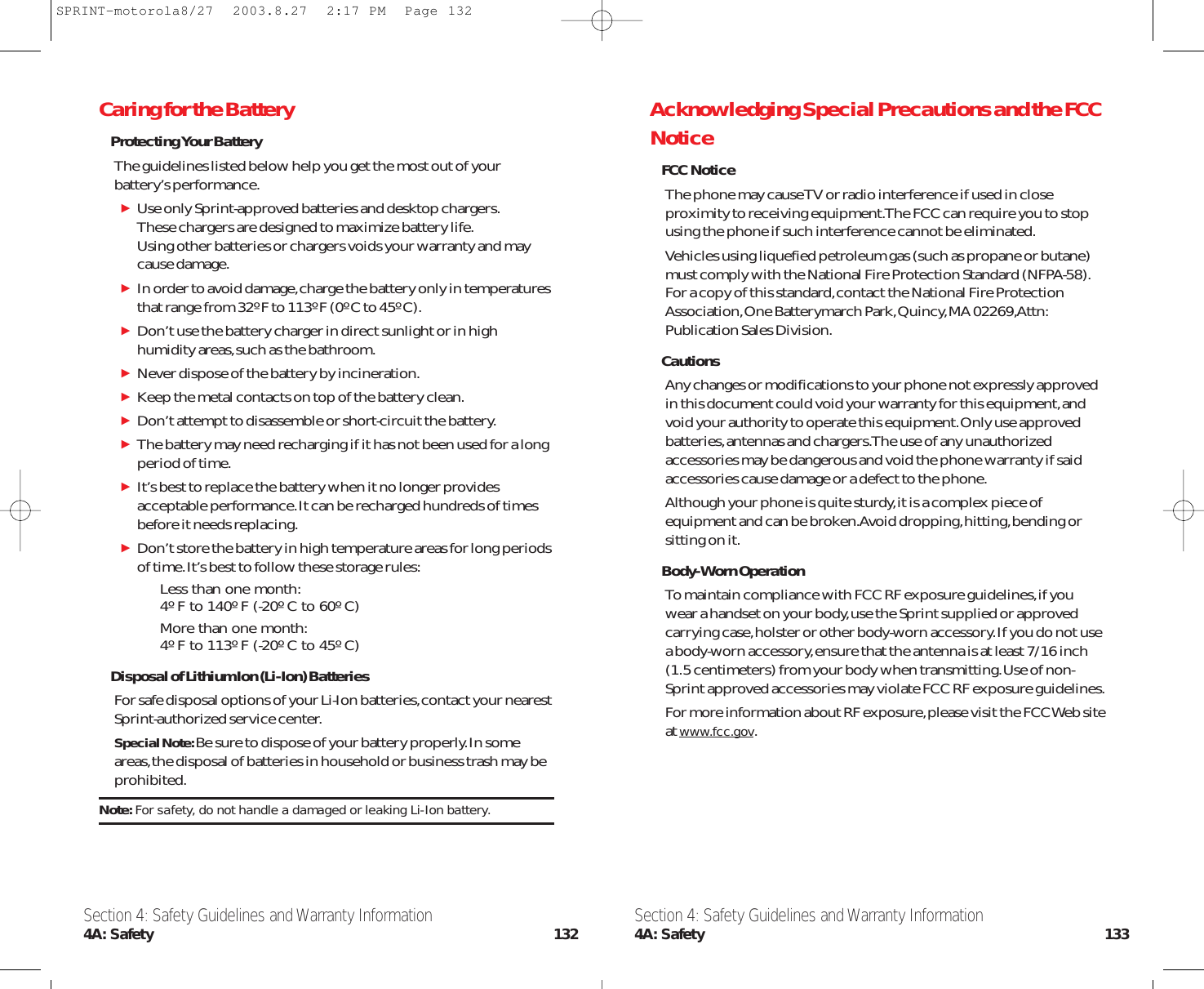
![Consumer Information on Wireless Phones(The following information comes from a consumer information Web site jointly sponsored by the U.S.Food and Drug Administration(FDA) and the Federal Communications Commission (FCC),entitled“Cell Phone Facts:Consumer Information on Wireless Phones.”Theinformation reproduced herein is dated April 3,2002.For furtherupdates,please visit the Web site:http://www.fda.gov/cellphones/.)1. What is radiofrequency energy (RF)?Radiofrequency (RF) energy is another name for radio waves.It is oneform of electromagnetic energy that makes up the electromagneticspectrum.Some of the other forms of energy in the electromagneticspectrum are gamma rays,x-rays and light.Electromagnetic energy(or electromagnetic radiation) consists of waves of electric andmagnetic energy moving together (radiating) through space.The areawhere these waves are found is called an electromagnetic field.Radio waves are created due to the movement of electrical charges inantennas.As they are created,these waves radiate away from theantenna.All electromagnetic waves travel at the speed of light.Themajor differences between the different types of waves are thedistances covered by one cycle of the wave and the number of wavesthat pass a certain point during a set time period.The wavelength isthe distance covered by one cycle of a wave.The frequency is thenumber of waves passing a given point in one second.For anyelectromagnetic wave,the wavelength multiplied by the frequencyequals the speed of light.The frequency of an RF signal is usuallyexpressed in units called hertz (Hz).One Hz equals one wave persecond.One kilohertz (kHz) equals one thousand waves per second,one megahertz (MHz) equals one million waves per second,and onegigahertz (GHz) equals one billion waves per second.RF energy includes waves with frequencies ranging from about 3000waves per second (3 kHz) to 300 billion waves per second (300 GHz).Microwaves are a subset of radio waves that have frequencies rangingfrom around 300 million waves per second (300 MHz) to three billionwaves per second (3 GHz).Specific Absorption Rates (SAR) for Wireless PhonesThe SAR is a value that corresponds to the relative amount of RFenergy absorbed in the head of a user of a wireless handset.The SAR value of a phone is the result of an extensive testing,measuring and calculation process.It does not represent how muchRF the phone emits.All phone models are tested at their highest valuein strict laboratory settings.But when in operation,the SAR of aphone can be substantially less than the level reported to the FCC.This is because of a variety of factors including its proximity to a basestation antenna,phone design and other factors.What is important toremember is that each phone meets strict federal guidelines.Variations in SARs do not represent a variation in safety.All phones must meet the federal standard,which incorporates asubstantial margin of safety.As stated above,variations in SAR valuesbetween different model phones do not mean variations in safety.SAR values at or below the federal standard of 1.6 W/kg areconsidered safe for use by the public.The highest reported SAR values of the [model xx]are:AMPS mode (Part 22) - Head:[x.xx]W/kg;Body-worn:[x.xx]W/kgPCS mode (Part 24) - Head:[x.xx]W/kg;Body-worn:[x.xx]W/kgFCC Radiofrequency EmissionThis phone meets the FCC Radiofrequency Emission Guidelines.FCCID number:[manufacturer needs to provide #].More information on thephone's SAR can be found from the following FCC Web site:http://www.fcc.gov/oet/fccid.Section 4: Safety Guidelines and Warranty Information4A: Safety 135Section 4: Safety Guidelines and Warranty Information4A: Safety 134SPRINT-motorola8/27 2003.8.27 2:17 PM Page 134](https://usermanual.wiki/Motorola-Mobility/T56DP1.Exhibit-8-Preliminary-Users-Manual/User-Guide-372493-Page-75.png)
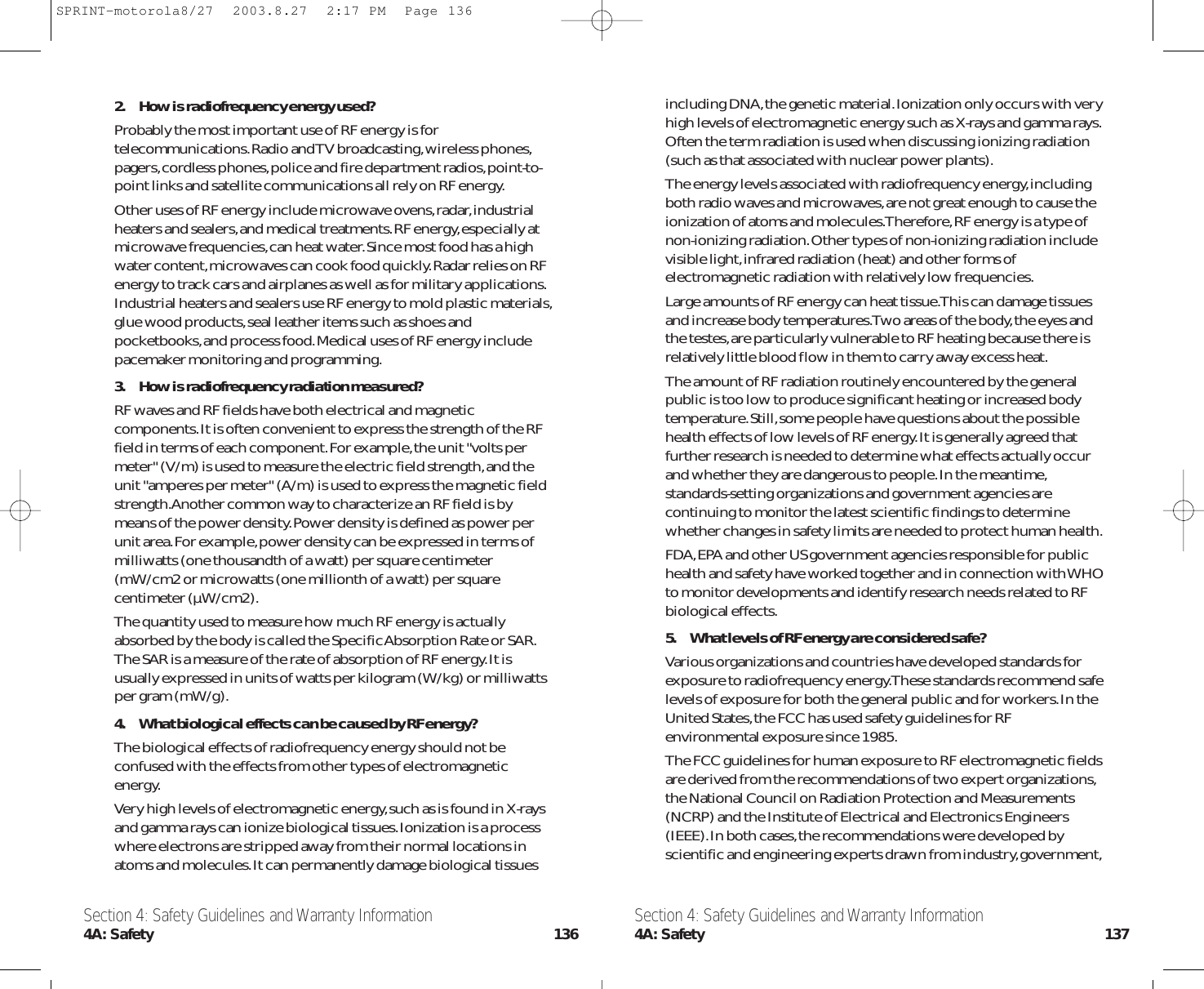
![Under the National Environmental Policy Act of 1969 (NEPA),theFCC has certain responsibilities to consider whether its actions willsignificantly affect the quality of the human environment.Therefore,FCC approval and licensing of transmitters and facilities must beevaluated for significant impact on the environment.Humanexposure to RF radiation emitted by FCC-regulated transmitters isone of several factors that must be considered in such environmentalevaluations.In 1996,the FCC revised its guidelines for RF exposure asa result of a multi-year proceeding and as required by theTelecommunications Act of 1996.Radio and television broadcast stations,satellite-earth stations,experimental radio stations and certain wireless communicationfacilities are required to undergo routine evaluation for RFcompliance when they submit an application to the FCC forconstruction or modification of a transmitting facility or renewal of alicense.Failure to comply with the FCC's RF exposure guidelinescould lead to the preparation of a formal Environmental Assessment,possible Environmental Impact Statement and eventual rejection ofan application.Technical guidelines for evaluating compliance withthe FCC RF safety requirements can be found in the FCC's OETBulletin 65.http://www.fcc.gov/oet/info/documents/bulletins/#65Low-powered,intermittent,or inaccessible RF transmitters andfacilities are normally excluded from the requirement for routineevaluation for RF exposure.These exclusions are based on standardcalculations and measurement data indicating that a transmittingstation or equipment operating under the conditions prescribed isunlikely to cause exposures in excess of the guidelines under normalconditions of use.Such exclusions are not exclusions fromcompliance,but,rather,exclusions from routine evaluation.The FCC'spolicies on RF exposure and categorical exclusion can be found inSection 1.1307(b) of the FCC's Rules and Regulations [(47 CFR1.1307(b)].7. How can I obtain the Specific Absorption Rate (SAR) value for mywireless phone?The FCC requires that wireless phones sold in the United Statesdemonstrate compliance with human exposure limits adopted by theFCC in 1996.The relative amount of RF energy absorbed in the headof a wireless telephone-user is given by the Specific Absorption Rate(SAR),as explained above.The FCC requires wireless phones tocomply with a safety limit of 1.6 watts per kilogram (1.6 W/kg) interms of SAR.and academia after extensive reviews of the scientific literaturerelated to the biological effects of RF energy.Many countries in Europe and elsewhere use exposure guidelinesdeveloped by the International Commission on Non-IonizingRadiation Protection (ICNIRP).The ICNIRP safety limits are generallysimilar to those of the NCRP and IEEE,with a few exceptions.Forexample,ICNIRP recommends different exposure levels in the lowerand upper frequency ranges and for localized exposure from certainproducts such as hand-held wireless telephones.Currently,the WorldHealth Organization is working to provide a framework forinternational harmonization of RF safety standards.The NCRP,IEEE,and ICNIRP all have identified a whole-body SpecificAbsorption Rate (SAR) value of 4 watts per kilogram (4 W/kg) as athreshold level of exposure at which harmful biological effects mayoccur.Exposure guidelines in terms of field strength,power densityand localized SAR were then derived from this threshold value.Inaddition,the NCRP,IEEE,and ICNIRP guidelines vary depending onthe frequency of the RF exposure.This is due to the finding thatwhole-body human absorption of RF energy varies with thefrequency of the RF signal.The most restrictive limits on whole-bodyexposure are in the frequency range of 30-300 MHz where the humanbody absorbs RF energy most efficiently.For products that onlyexpose part of the body,such as wireless phones,exposure limits interms of SAR only are specified.The exposure limits used by the FCC are expressed in terms of SAR,electric and magnetic field strength,and power density fortransmitters operating at frequencies from 300 kHz to 100 GHz.Thespecific values can be found in two FCC bulletins,OET Bulletins 56and 65:http://www.fcc.gov/oet/info/documents/bulletins/#56;http://www.fcc.gov/oet/info/documents/bulletins/#656. Why has the FCC adopted guidelines for RF exposure?The FCC authorizes and licenses products,transmitters,and facilitiesthat generate RF and microwave radiation.It has jurisdiction over alltransmitting services in the U.S.except those specifically operated bythe Federal Government.While the FCC does not have the expertiseto determine radiation exposure guidelines on its own,it does havethe expertise and authority to recognize and adopt technically soundstandards promulgated by other expert agencies and organizations,and has done so .(Our joint efforts with the FDA in developing thiswebsite is illustrative of the kind of inter-agency efforts andconsultation we engage in regarding this health and safety issue.)Section 4: Safety Guidelines and Warranty Information4A: Safety 139Section 4: Safety Guidelines and Warranty Information4A: Safety 138SPRINT-motorola8/27 2003.8.27 2:17 PM Page 138](https://usermanual.wiki/Motorola-Mobility/T56DP1.Exhibit-8-Preliminary-Users-Manual/User-Guide-372493-Page-77.png)
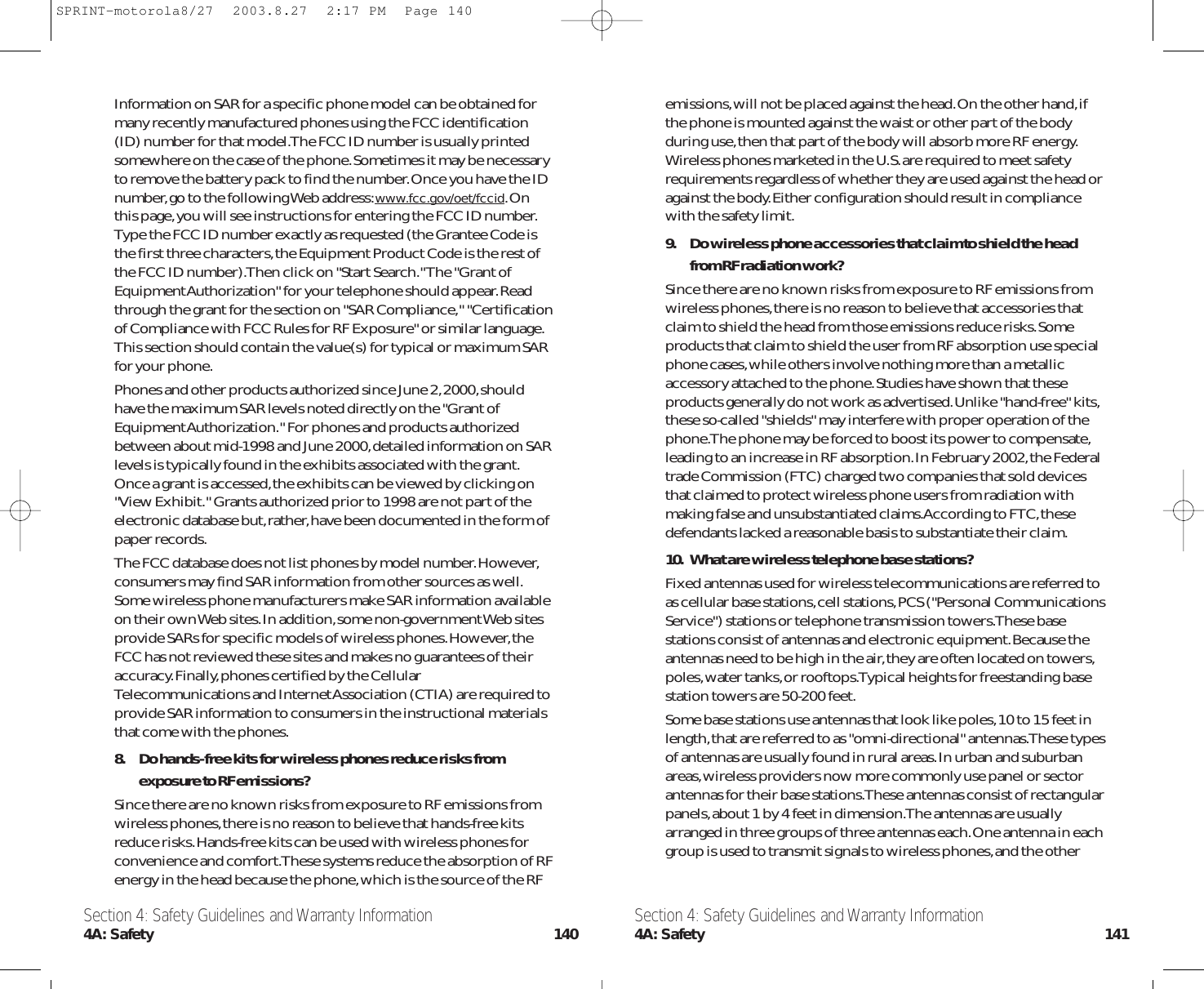
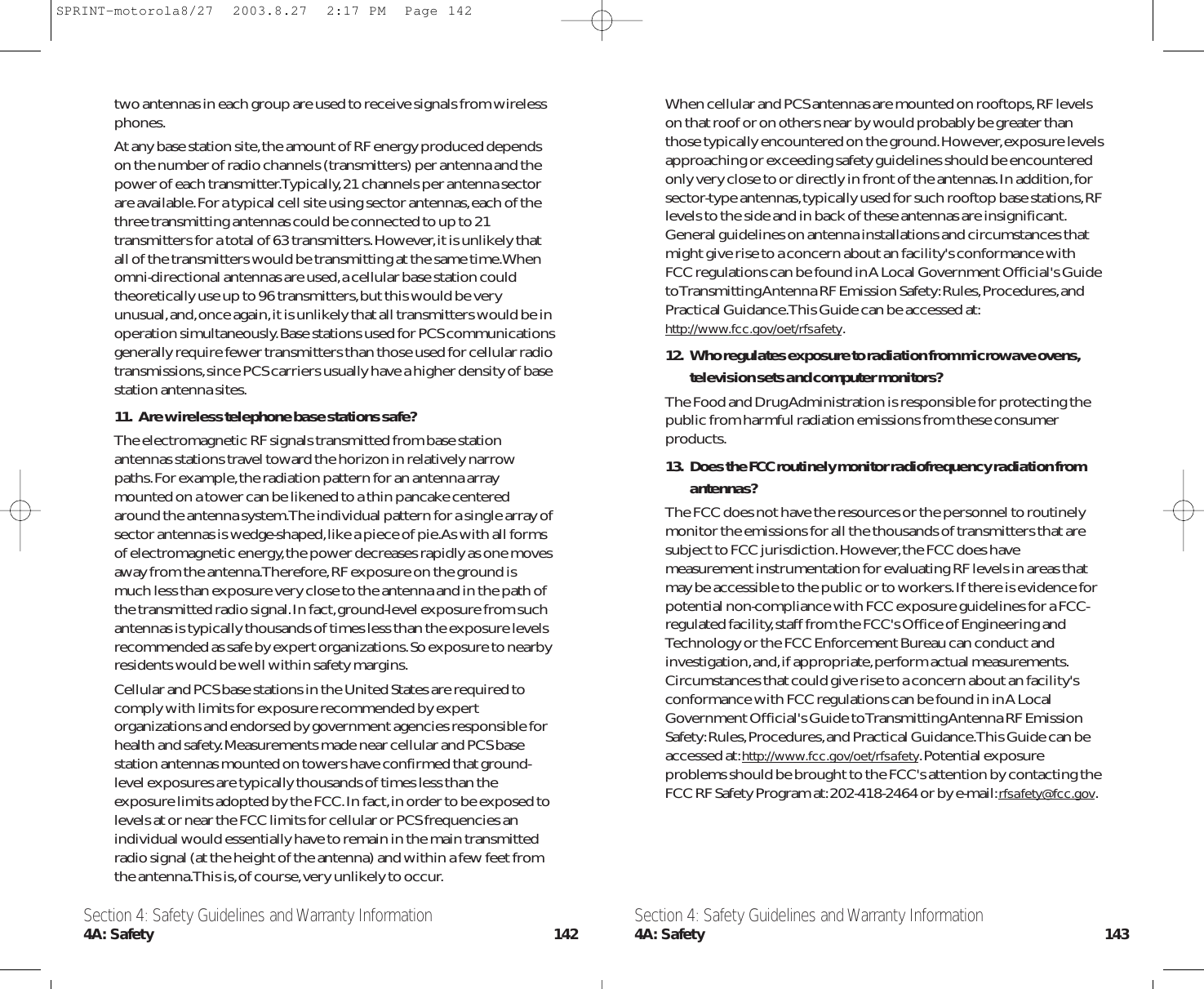
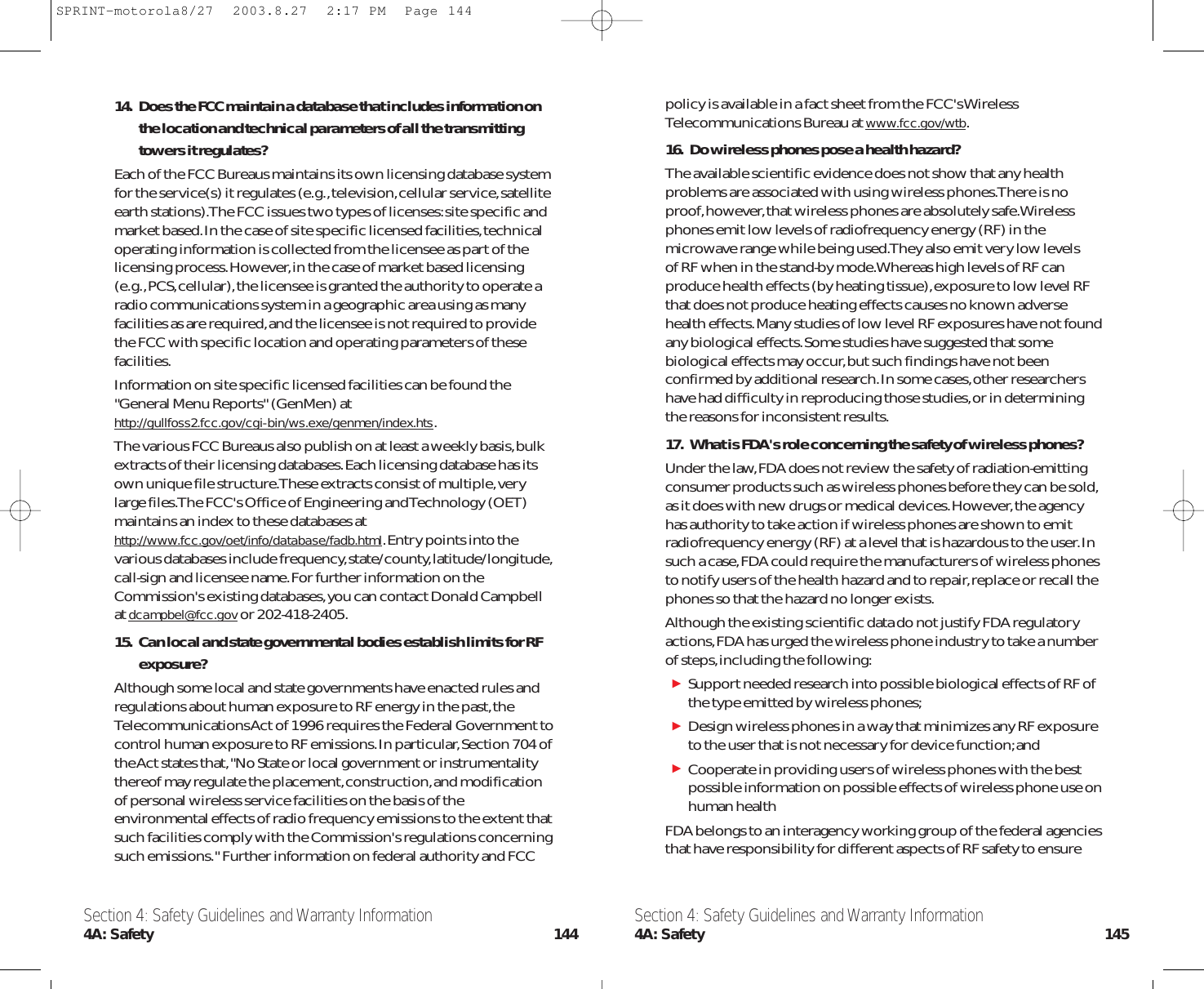
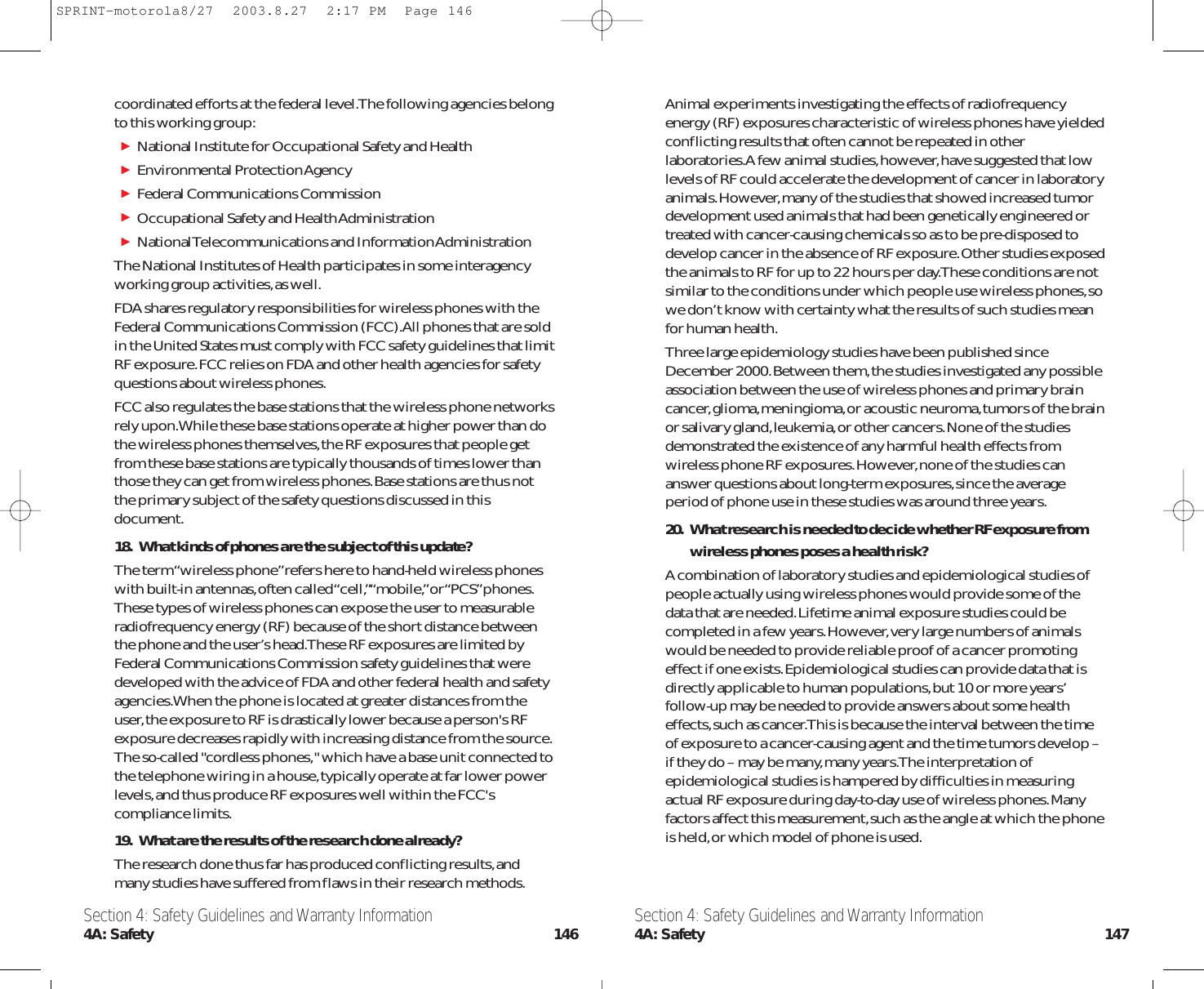
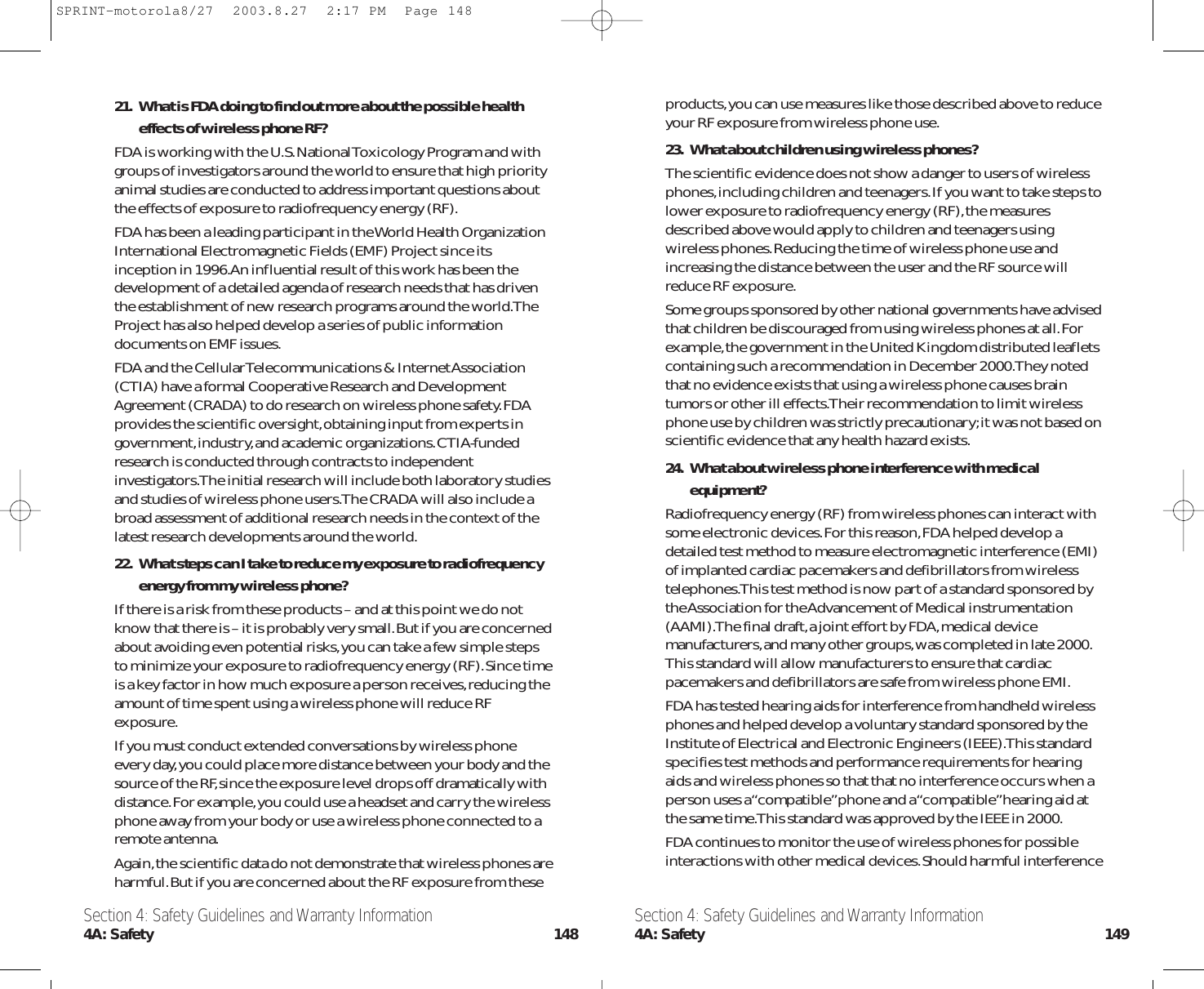
![among the various federal agencies with health or regulatoryresponsibilities in this area.OSHA is responsible for protecting workers from exposure tohazardous chemical and physical agents.In 1971,OSHA issued aprotection guide for exposure of workers to RF radiation [29 CFR1910.97].However,this guide was later ruled to be only advisory andnot mandatory.Moreover,it was based on an earlier RF exposurestandard that has now been revised.At the present time,OSHA usesthe IEEE and/or FCC exposure guidelines for enforcement purposesunder OSHA's "general duty clause" (for more information see:http://www.osha-slc.gov/SLTC/radiofrequencyradiation/index.html).NIOSH is part of the U.S.Department of Health and Human Services.It conducts research and investigations into issues related tooccupational exposure to chemical and physical agents.NIOSH has,in the past,undertaken to develop RF exposure guidelines forworkers,but final guidelines were never adopted by the agency.NIOSH conducts safety-related RF studies through its Physical AgentsEffects Branch in Cincinnati,Ohio.The NTIA is an agency of the U.S.Department of Commerce and isresponsible for authorizing Federal Government use of the RFelectromagnetic spectrum.Like the FCC,the NTIA also has NEPAresponsibilities and has considered adopting guidelines forevaluating RF exposure from U.S.Government transmitters such asradar and military facilities.The Department of Defense (DOD) has conducted research on thebiological effects of RF energy for a number of years.This research isnow conducted primarily at the U.S.Air Force Research Laboratorylocated at Brooks Air Force Base,Texas.The DOD Web site for RFbiological effects information is listed with other sites in conjunctionwith a question on other sources of information,below.26. Who funds and carries out research on the biological effects of RF energy?Research into possible biological effects of RF energy is carried out inlaboratories in the United States and around the world.In the U.S.,most research has been funded by the Department of Defense,due tothe extensive military use of RF equipment such as radar and high-powered radio transmitters.In addition,some federal agenciesresponsible for health and safety,such as the EnvironmentalProtection Agency (EPA) and the U.S.Food and Drug Administration(FDA),have sponsored and conducted research in this area.At thebe found to occur,FDA will conduct testing to assess the interferenceand work to resolve the problem.25. Which other federal agencies have responsibilities related topotential RF health effects?Certain agencies in the Federal Government have been involved inmonitoring,researching or regulating issues related to humanexposure to RF radiation.These agencies include the Food and DrugAdministration (FDA),the Environmental Protection Agency (EPA),the Occupational Safety and Health Administration (OSHA),theNational Institute for Occupational Safety and Health (NIOSH),theNational Telecommunications and Information Administration(NTIA) and the Department of Defense (DOD).By authority of the Radiation Control for Health and Safety Act of1968,the Center for Devices and Radiological Health (CDRH) of theFDA develops performance standards for the emission of radiationfrom electronic products including X-ray equipment,other medicaldevices,television sets,microwave ovens,laser products andsunlamps.The CDRH established a product performance standard formicrowave ovens in 1971 limiting the amount of RF leakage fromovens.However,the CDRH has not adopted performance standardsfor other RF-emitting products.The FDA is,however,the lead federalhealth agency in monitoring the latest research developments andadvising other agencies with respect to the safety of RF-emittingproducts used by the public,such as cellular and PCS phones.The FDA's microwave oven standard is an emission standard (asopposed to an exposure standard) that allows specific levels ofmicrowave leakage (measured at five centimeters from the ovensurface).The standard also requires ovens to have two independentinterlock systems that prevent the oven from generating microwavesthe moment that the latch is released or the door of the oven isopened.The FDA has stated that ovens that meet its standards and areused according to the manufacturer's recommendations are safe forconsumer and industrial use.More information is available from:www.fda.gov/cdrh.The EPA has,in the past,considered developing federal guidelines forpublic exposure to RF radiation.However,EPA activities related to RFsafety and health are presently limited to advisory functions.Forexample,the EPA now chairs an Inter-agency RadiofrequencyWorking Group,which coordinates RF health-related activitiesSection 4: Safety Guidelines and Warranty Information4A: Safety 151Section 4: Safety Guidelines and Warranty Information4A: Safety 150SPRINT-motorola8/27 2003.8.27 2:17 PM Page 150](https://usermanual.wiki/Motorola-Mobility/T56DP1.Exhibit-8-Preliminary-Users-Manual/User-Guide-372493-Page-83.png)
![Owner’s RecordThe model number,regulatory number and serial number are locatedon a nameplate inside the battery compartment.Record the serialnumber in the space provided below.This will be helpful if you needto contact us about your phone in the future.Model:PCS Phone [model xx]Serial No.:User Guide Proprietary NoticeCDMA Technology is licensed by QUALCOMM Incorporated underone or more of the following patents:4,901,307 5,109,390 5,267,262 5,416,797 5,506,865 5,544,196 5,657,420 5,101,501 5,267,261 5,414,796 5,504,773 5,535,239 5,600,754 5,778,338 5,228,054 5,337,338 5,710,784 5,056,109 5,568,483 5,659,569 5,490,165 5,511,073 T9 Text Input is licensed by Tegic Communications and is covered byU.S.Pat.5,818,437,U.S.Pat.5,953,541,U.S.Pat.6,011,554 and otherpatents pending.present time,most of the non-military research on biological effectsof RF energy in the U.S.is being funded by industry organizations.More research is being carried out overseas,particularly in Europe.In 1996,the World Health Organization (WHO) established theInternational EMF Project to review the scientific literature and worktowards resolution of health concerns over the use of RF technology.WHO maintains a Web site that provides extensive information onthis project and about RF biological effects and research(www.who.ch/peh-emf).FDA,EPA and other US government agencies responsible for publichealth and safety have worked together and in connection with WHOto monitor developments and identify research needs related to RFbiological effects.Section 4: Safety Guidelines and Warranty Information4A: Safety 153Section 4: Safety Guidelines and Warranty Information4A: Safety 152SPRINT-motorola8/27 2003.8.27 2:17 PM Page 152](https://usermanual.wiki/Motorola-Mobility/T56DP1.Exhibit-8-Preliminary-Users-Manual/User-Guide-372493-Page-84.png)
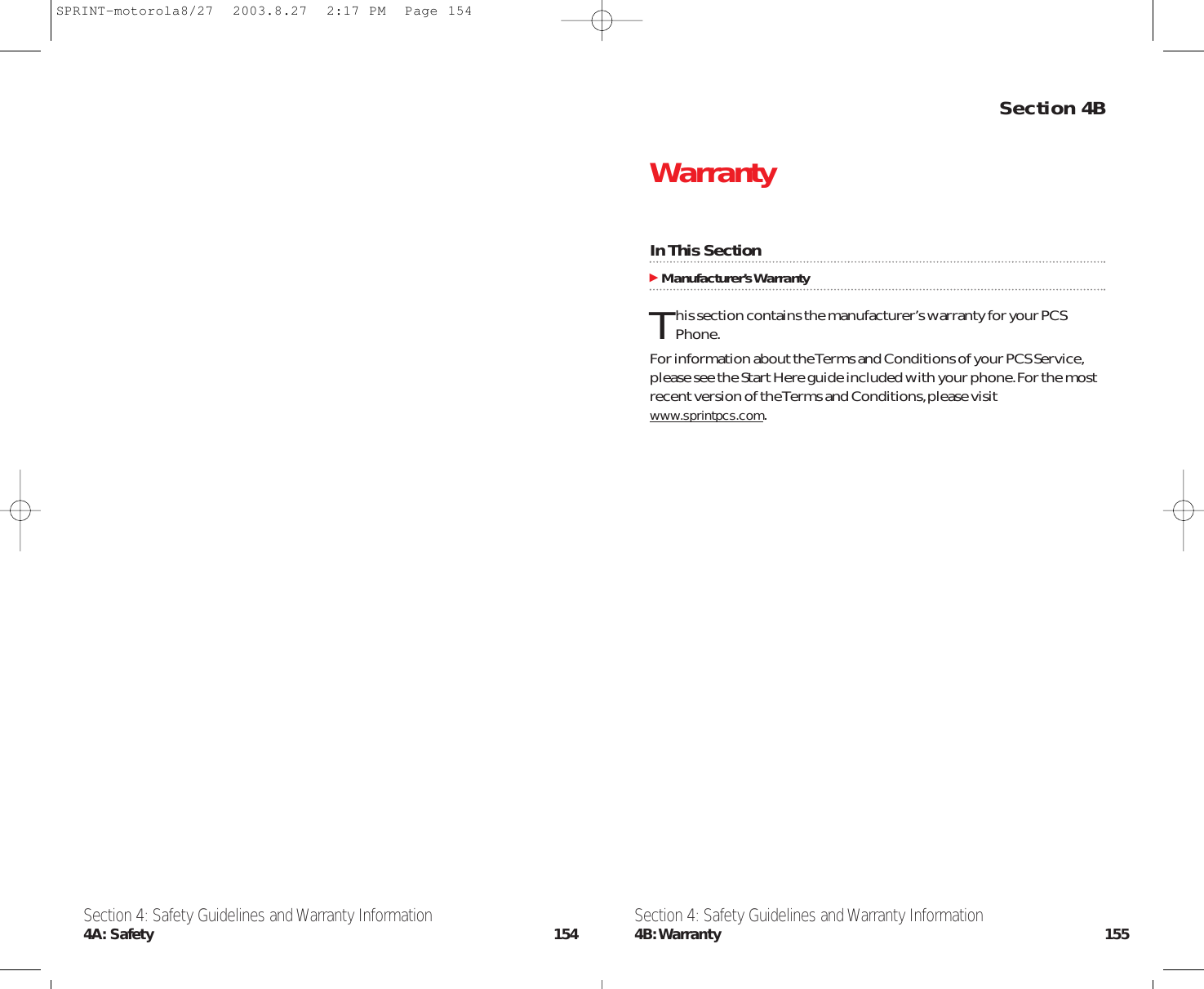
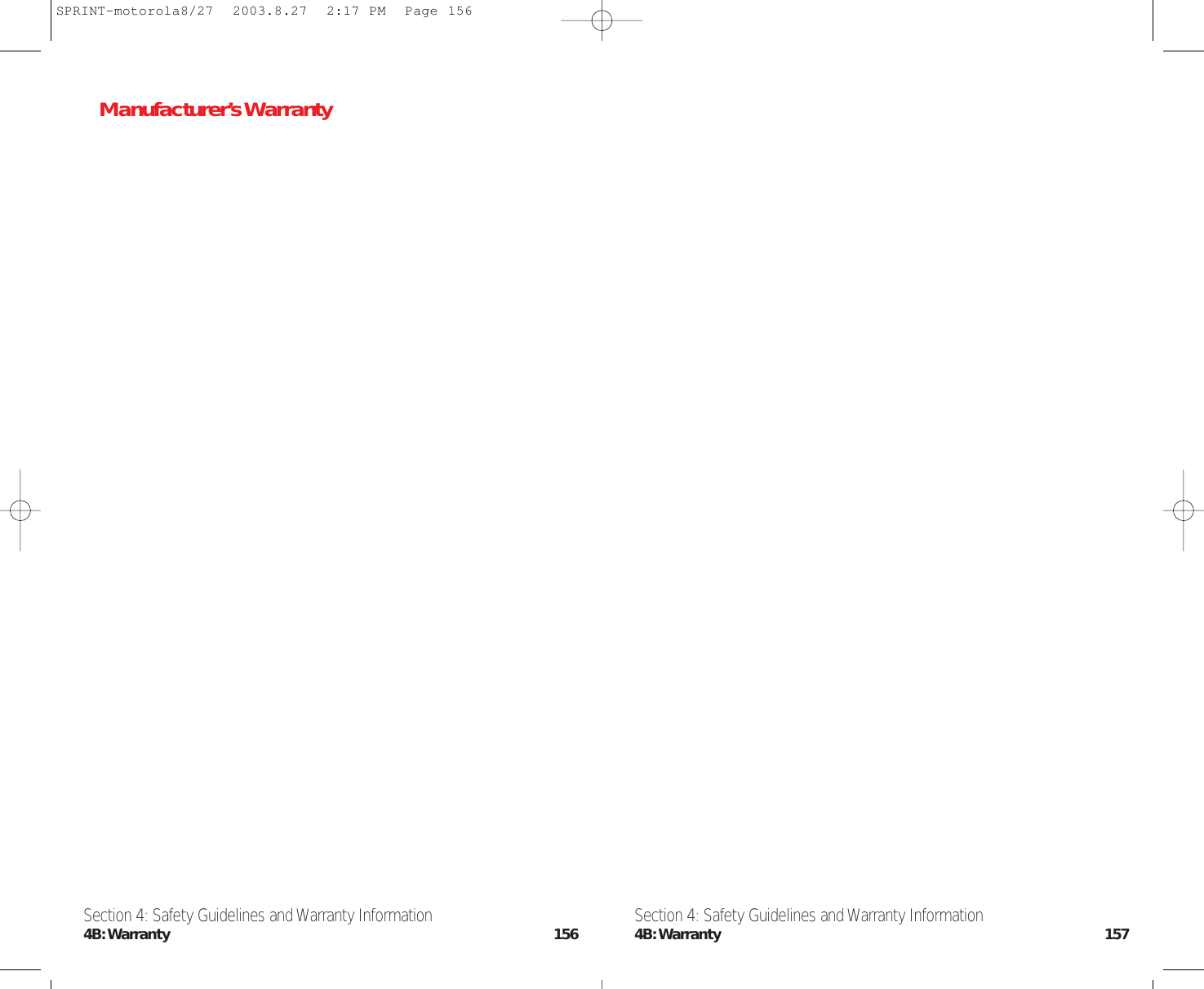
![[INSERT PHONE-SPECIFIC BROWSER & SECURITY ID GRAPHICS][]Copyright © 2002 Sprint Spectrum L.P.All rights reserved.No reproduction in whole or in part without priorwritten approval.Sprint,PCS Vision,PCS Business Connection,and the diamond logo are trademarks of SprintCommunications Company L.P.All other trademarks are property of their respective owners.Section 4: Safety Guidelines and Warranty Information4B:Warranty 158SPRINT-motorola8/27 2003.8.27 2:17 PM Page 158](https://usermanual.wiki/Motorola-Mobility/T56DP1.Exhibit-8-Preliminary-Users-Manual/User-Guide-372493-Page-87.png)
![Index 161Games 122Messaging 107Password 41Pictures 118Ringers 124Screen Savers 126Security Features 41Signing In and Out 43Web Connection 105PCS Voice Command 131-133Phone NumberDisplaying 17Picture Wallet 84Pictures Password 82Pictures Web Site 85RRinger Types 26Roaming 46SSecurity Menu 38Sharing Pictures 86Short Mail 109Special Numbers 40TT9 Text Input 61Three-Way Calling 97TTY Use 32UUnlocking Your Phone 38Updates 108VVoicemailClearing 94Expert Mode 92Menu 95Notification 90Options 92Retrieving 91Setting Up 5, 90Volume Settings 28WWeb 100Browsing 101Launching 100Index 160Index[SAMPLE ONLY]AAirplane Mode 32Answering Calls 18BBacklight 29BatteryCapacity 15Charging 16Disposal 142Installing 15Removing 15CCall Guard 49Call HistoryErasing 58Making a Call From 57Options 56Saving a Phone Number From57Viewing 56Camera 79-86Camera Mode Options 80Managing Pictures 82Review Mode Options 83Taking Pictures 80Chat 117Clock 31DDialing Options 19Display Screen Symbols 12Display Settings 29-31EEmail 116Entering TextABC Mode 62Selecting a Character InputMode 60Symbols and Numbers 62T9 Text Input 61FFCC Notice 143GGreeting 29IInstant Messaging 111Internal Phone BookAdding an Entry 63Editing Entries 65Finding Entries 63Options 60Secret Entries 66LLocation Settings 31Locking Your Phone 38MMaking Calls 17Manufacturer’s Warranty 166MenusDiagram 53Navigation 52Structure 52Viewing 53Missed Call Notification 18NNet Guard 100PPCS Business Connection 128PCS ServicesCall Forwarding 98Call Waiting 96Caller ID 96Customer Solutions 6Directory Assistance 6Operator Services 6PCS VisionDownloading Items 120FAQs 129SPRINT-motorola8/27 2003.8.27 2:17 PM Page 160](https://usermanual.wiki/Motorola-Mobility/T56DP1.Exhibit-8-Preliminary-Users-Manual/User-Guide-372493-Page-88.png)
